
U.S. EDITION | ISSUE 2 | 2024 | $12.99 CaitlinSimmers,ranked#1intheworld,isreadyforhermomenton the biggest stag e
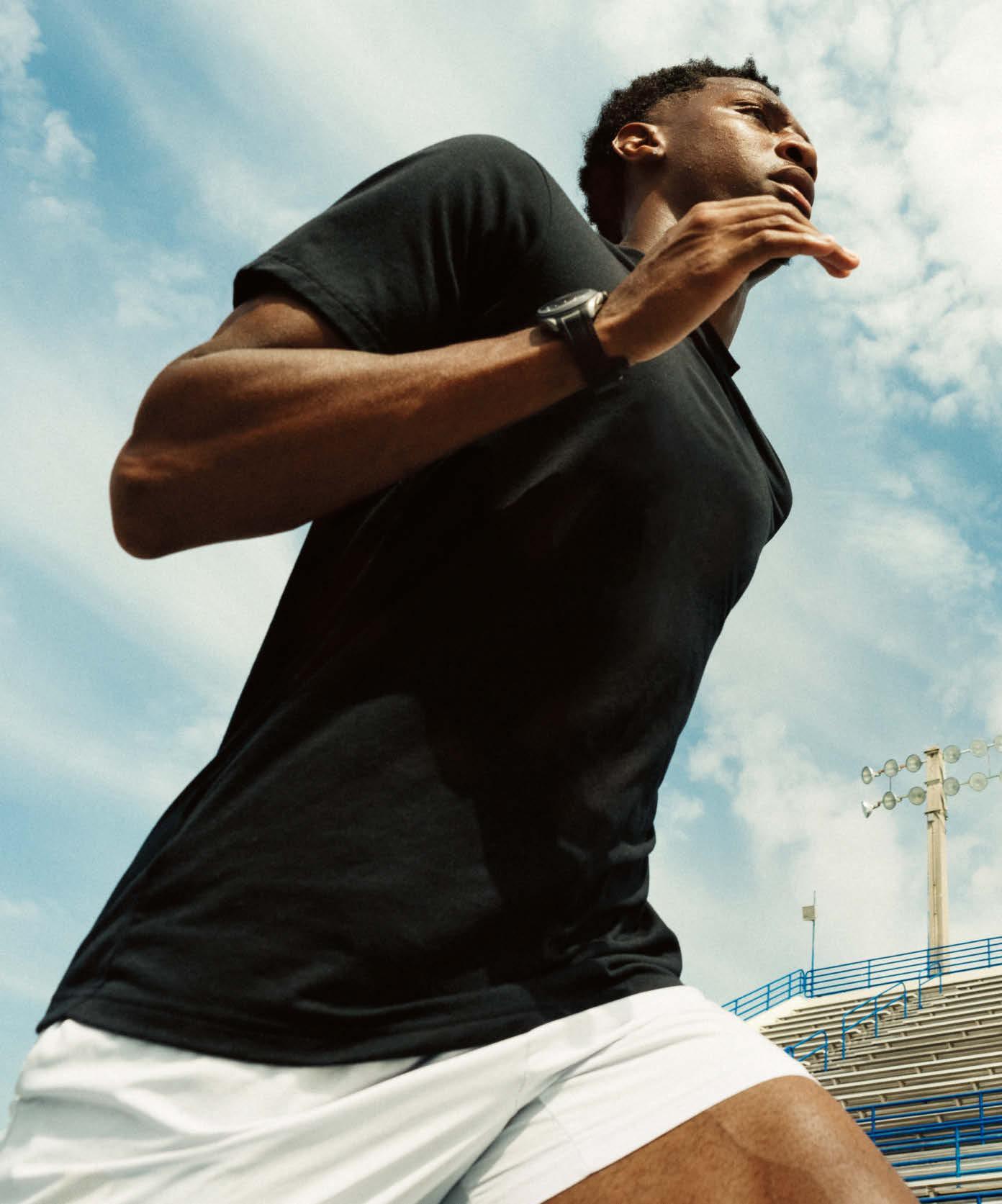
Erriyon Knighton, one of the fastest humans on earth, is poised for stardom on the worldʼs biggest stage
U.S. EDITION | ISSUE 2 | 2024 | $12.99

THINGS ARE LOOKING UP FOR JAGGER EATON THINGS ARE LOOKING UP FOR JAGGER EATON
Among the world’s best in two disciplines, the pro skater has made big gains by doing the
little
things right
U.S. EDITION | ISSUE 2 | 2024 | $12.99







































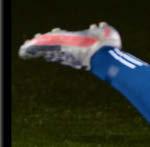












































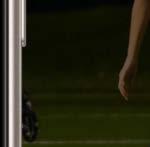



















































































Zoom that goes the distance











Catch all the action, from any seat, using Nightography Zoom with Galaxy AI


























The Official Smartphone Action Camera for Red Bull




















Samsung account login is required for certain AI features. Galaxy AI features by Samsung will be provided for free until the end of 2025 on supported Samsung Galaxy devices.
Clockwise from top left: Caitlin Simmers, Erriyon Knighton, Jagger Eaton, Sasha DiGiulian, MenaRD and Paul Rabil.
WAYS OF WINNING
BY PETER FLAX
The issue you’re holding is packed with stories about world-class athletes who are champions in an amazing range of sports and disclipines. The roster includes a surfer, a skater, a pole vaulter, a climber, a gamer, a sprinter, a basketball star, a triple jumper and even a breaker. The World of Red Bull can be a dizzying place!
Each of these stories is packed with insights into how champions are born and forged. And if you read them all, you’ll see that, while most top performers have a few key things in common, our subjects have found diferent, highly personalized paths to the top of their games.
Let’s hit the common ground frst. We’re afraid to report that one prerequisite is having outlier innate talent—a predispostion to be fast or acrobatic or explosive or whatever separates the immortals from the rest of us. But that said, all these champions have put in years of hard work to hone their gifs, to translate their latent talent into tangible performance. And they’re all committed to the essentials of high performance—being super mindful about things like sleep, nutrition and mental preparation.
But beyond that, they collectively demonstrate that there are multiple, distinctly individualized paths to the top. Some of them, like pro skateboarder Jagger Eaton and climber Sasha DiGiullian, have found a huge edge by embracing an obsessive single-mindedness in their pursuit of greatness. While others, like sprinter Erriyon Knighton and pole vaulter Mondo Duplantis, work hard to craf a balance between their work and the rest of their lives. Some have required counseling to reframe or rediscover their motivation, and others have thrown themselves at outside hobbies to satify creative needs that their sporting life doesn’t fully satisfy. You get the idea.
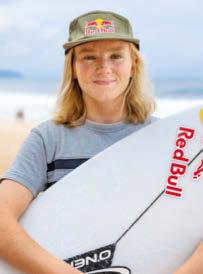

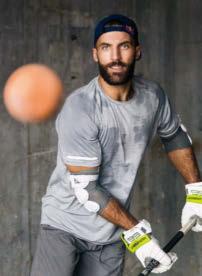
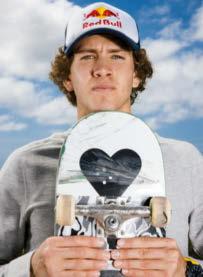


Paul Rabil, who has transitioned from being the best lacrosse player in modern times to a sports mogul, has a new book that explores this duality. His book, a manual for regular folks seeking their version of greatness, makes it clear that there’s no single roadmap to athletic success. There are lessons to be learned from high performers, but we all have to forge our own path to our best selves.
As you dig into the issue, we encourage you to look for wisdom and inspiration from these champions that feels relevant to your life.
If you want to be great at something, it’s wise to study how other people succeed—and explore what works for you.
EDITOR’S NOTE THE RED BULLETIN QUARTERLY
04 THE RED BULLETIN
Cover: Domenic Mosqueira
(Caitlin Simmers), Atiba Jefferson
Bull
Mions ke
(Jagger Eaton), Hana Asan (Erriyon Knighton) Christa Funk, Hana, Asano, Shawn Hubbard/Red
Bull Content Pool, Atiba Jefferson, Daniel Weiss/Red
Content Pool, Greg
PHOTOGRAPHER

HANA ASANO
“I’m always grateful to be given both an opportunity to document an athlete’s real training and also have the designated time for portraiture,” says the Los Angeles–based photographer, who traveled to Florida to shoot sprint phenom Erriyon Knighton. “This offers two unique views into the elite athlete’s life, and two completely different ways to photograph the same subject.” Asano’s clients include Adidas, Lululemon, Women’s Health and Asics. Page 14
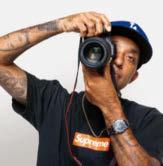
PHOTOGRAPHER
ATIBA JEFFERSON
The L.A.-based photographer shot pro skateboarder Jagger Eaton, including a unique upward facing image of Eaton doing an ollie. “That photo breaks a lot of the rules of skateboard photography because you normally show where a skater is coming from and going to,” he says. “This shot makes it so much more mysterious—you really don’t know if he’s 5 feet high or 5 inches.” Jefferson’s clients include Nike, Supreme, Thrasher and Netfix Page 68

WRITER
GLORIA LIU
The Lake Tahoe–based writer tackled our feature on climber Sasha DiGiulian, the subject of a new flm. “I think ambitious women who play in male-dominated felds will recognize the dynamics that Sasha has had to navigate in her career,” says Liu, a contributing editor at Outside whose work has also appeared in The Atlantic and Bicycling. “Hopefully they’ll be inspired by the way she’s stayed true to who she is despite the pushback she’s sometimes encountered.” Page 96

WRITER
SHEILA YASMIN MARIKAR
“It’s cliché to call anyone in Los Angeles ‘down to earth’; most of us have our heads in the clouds in one way or another,” says the L.A.-based writer, who profles YouTube super-streamer Ludwig in this issue. “But Ludwig is just that—he greeted me in sweatpants and bare feet, with no publicist or attendant entourage. If it’s an act, he deserves an Oscar for it.” Marikar’s work has appeared in The New Yorker and Vogue, and she’s the author of a new novel, Friends in Napa. Page 116
CONTRIBUTORS
@HANAASANO @SHEILAYM @ATIBAPHOTO @THATS_MY_LINE
THE RED BULLETIN 05


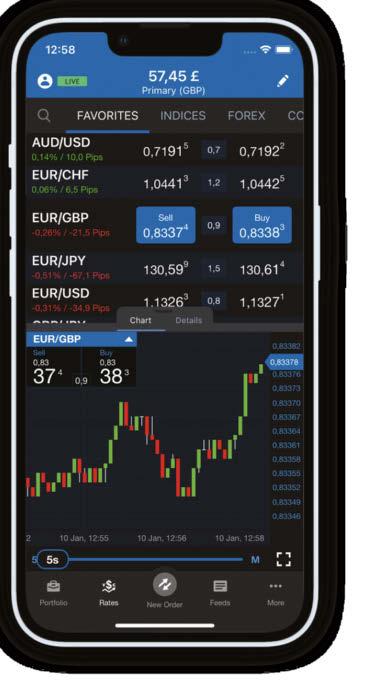
Erriyon Knighton This summer, the sprinter is ready for the fast lane
Paul
Caitlin
She’s 18 and rapidly on her way to surfng stardom
Portfolio:
Stunning surf shots from the famed reef break Teahupo’o
Postcard
A master of
The B-boy possesses a talent for
Mondo Duplantis
The record-breaking pole vaulter soars to legend status
Sasha DiGiulian
With a new flm looming, the pro climber opens up
Chasing
The story behind capturing an impossible eclipse shot
Ludwig At home with the YouTube and streaming icon
Patrick Cloud
Get to know the host of Red Bull Rap IQ and his top tracks
Shiny objects in our favorite colors: gold, silver and bronze
10 Masthead The Red Bulletin worldwide 11 Cocktail Watermelon Fizz 130 Final Take MiLaysia Fulwiley celebrates CONTENTS PLUS Formula 1 Go slightly wild with stickers of some of our favorite drivers! 2024 ISSUE 2 THE RED BULLETIN QUARTERLY 12 POWER & GLORY 14
24
his success 26
Like a Pro Two world-class athletes share key training insights 34 In the Moment Blxst at Coachella 36 MenaRD
Street Fighter player wins tournaments—and hearts 114 THE CREATORS 116
Rabil Q&A The lacrosse legend shares some secrets of
Train
The
124
126 Gear
44 ART IN MOTION 46
56
Simmers
Ted Grambeau
64
Moore visits
68
Eaton
from a Pro Carissa
Tahiti
Jagger
street
pro skater aims high 78 Phil Wizard
and park, the
real magic 84 NEW HEIGHTS 86
96
106
Darkness
Domenic Mosqueira, Atiba Jefferson, Hana Asano

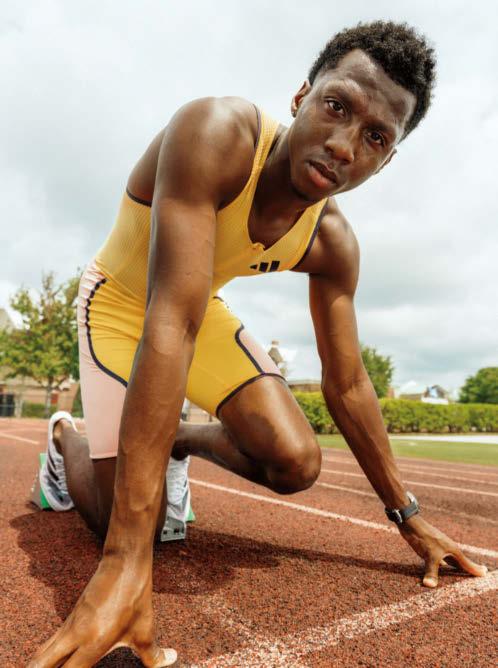

46
68
14
Caitlin Simmers
Jagger Eaton
Erriyon Knighton
BEYOND THE ORDINARY THE RED BULLETIN 09
Five events into the 2024 WSL season, Caitlin Simmers is ranked #1 in the world.
UNITED STATES
THE RED BULLETIN USA, Vol. 14, Issue 2, ISSN 2308-586X
Editorial Director
Peter Flax
Executive Editor Nora O’Donnell
Editor/Producer
Melissa Saenz Gordon
Art Director
Tara Thompson
Photo Editor
Rudi Übelhör
Copy Chief
David Caplan
Director Printing & Distribution
Branden Peters
VP Channels & Programming
Natalie Osterling
VP Partnerships
Dave Szych, dave.szych@redbull.com
Advertising Sales
Marissa Bobkowski, marissa.bobkowski@ redbull.com
Tanya Foster, tanya.foster@redbull.com
Todd Peters, todd.peters@redbull.com
Printed by Fry Communications, Inc., 800 W. Church Rd., Mechanicsburg, PA 17055, frycomm.com
The Red Bulletin is published quarterly by Red Bull Media House, North America 1740 Stewart St., Santa Monica, CA 90404.
Periodicals postage paid at Santa Monica, CA, and additional mailing offices.
ATTENTION POSTMASTER: Send address changes to THE RED BULLETIN, PO Box 469002, Escondido, CA 92046.
Subscribe getredbulletin. com, subscription@us. redbulletin.com.
Basic subscription rate is $19.95 per year. Offer available in the U.S. and U.S. possessions only. The Red Bulletin is published four times a year. Please allow four to six weeks for delivery of the first issue. Customer Service 855-492-1650; subscription@ us.redbulletin.com
AUSTRIA
THE RED BULLETIN Austria, ISSN 1995-8838
Editors
Nina Kaltenböck (manager), Lisa Hechenberger
Proofreaders
Hans Fleißner (manager), Petra Hannert, Monika Hasleder, Billy KirnbauerWalek, Klaus Peham
Country Project Management
Julian Vater
Media Sales & Partnerships
Thomas Hutterer (manager), Michael Baidinger, Franz Fellner, Ines Gruber, Wolfgang Kröll, Gabriele Matijevic-Beisteiner, Yvonne Mensik, Alfred Minassian, Nicole OkasekLang, Fanny Postl, Carina Rzavsky, Nicole Umsait, Johannes Wahrmann-Schär, Ellen Wittmann-Sochor, Ute Wolker, Christian Wörndle, Sabine Zölß
FRANCE
THE RED BULLETIN France, ISSN 2225-4722
Editors Pierre-Henri Camy (manager), Marie-Maxime
Dricot, Christine Vitel
Country Project Management
Marin Heitzler
Media Sales & Partnerships
Yoann Aubry
GERMANY
THE RED BULLETIN Germany, ISSN 2079-4258
Editor
David Mayer
Proofreaders
Hans Fleißner (manager), Petra Hannert, Monika Hasleder, Billy KirnbauerWalek, Klaus Peham
Country Project Management
Natascha Djodat
Media Sales & Partnerships
Thomas Hutterer (manager), Michael Baidinger, Franz Fellner, Ines Gruber, Wolfgang Kröll, Gabriele Matijevic-Beisteiner, Yvonne Mensik, Alfred Minassian, Nicole OkasekLang, Fanny Postl, Carina Rzavsky, Nicole Umsait, Johannes Wahrmann-Schär, Ellen Wittmann-Sochor, Ute Wolker, Christian Wörndle, Sabine Zölß
SWITZERLAND
THE RED BULLETIN Switzerland, ISSN 2308-5886
Editor
Anna Mayumi Kerber
Proofreaders
Hans Fleißner (manager), Petra Hannert, Monika Hasleder, Billy KirnbauerWalek, Klaus Peham
Country Project Management
Meike Koch
Media Sales & Partnerships
Christian Bürgi (manager), Marcel Bannwart, Lauritz Putze, Michael Wipraechtiger
UNITED KINGDOM
THE RED BULLETIN United Kingdom, ISSN 2308-5894
Editor Ruth McLeod
Chief Sub-Editor Davydd Chong
Country Project Management
Ollie Stretton
Media Sales
Mark Bishop
GLOBAL TEAM
Publisher
Andreas Kornhofer
Head of The Red Bulletin
Andreas Rottenschlager
Executive Creative Director
Markus Kietreiber
Creative Directors
Erik Turek (manager), Kasimir Reimann
Art Directors
Marion Bernert-Thomann, Miles English
Designers
Martina de Carvalho-Hutter, Kevin Faustmann-Goll, Carita Najewitz
Photo Editors
Eva Kerschbaum (manager), Marion Batty (deputy), Susie Forman, Tahira Mirza
Production Editor
Marion Lukas-Wildmann
Managing Editor
Ulrich Corazza
Global Content
Tom Guise (manager), Lou Boyd
Publishing Management
Sara Car-Varming (manager), Ivona Glibusic, Melissa Stutz
Head of Media Sales & Partnerships
Lukas Scharmbacher
Senior Manager Creative Elisabeth Kopanz
Art Direction Commercial
Peter Knehtl (manager), Lisa Jeschko, Martina Maier, Julia Schinzel, Florian Solly
Head of Publishing Operations
Sigurd Abele
Direct to Consumer Business
Peter Schiffer (manager), Marija Althajm, Melanie Schmid, Yoldaş Yarar (Subscription)
Retail & Special Projects Management
Klaus Pleninger
Disclaimer
If you subscribed to The Red Bulletin magazine in the USA either by mail, online or other method, we may send you offers through direct mail that we feel might be of interest to you and/or share your name and mailing address and certain other information, such as when you first subscribed, with reputable companies that provide marketing offers through direct mail.
If you do not want us to send you any offers from third parties through direct mail or share your personal information with other companies so that they can send you direct mail offers about their products and services, please write to us at the street address or subscription email address at left. Please note that even if you opt out of receiving promotional direct mail offers, we may continue to send you service notifications by direct mail that are related to your The Red Bulletin account(s).
Production
Veronika Felder (manager), Martin Brandhofer, Walter O. Sádaba, Sabine Wessig
Repro
Clemens Ragotzky (manager), Claudia Heis, Nenad Isailovic, Josef Mühlbacher
Sales Operations & Development
Anna Schönauer (manager), Manuela Brandstätter, David Mühlbacher, Monika Spitaler
Finance
Ziga Balic, Nora Kovacs-Horvathr
Project Management Publishing
Katrin Dollenz
Assistant to General Management
Sandra Stolzer
General Manager Red Bull
Media House Publishing
Stefan Ebner
Editorial office
Am Grünen Prater 3, A-1020 Vienna
Phone +43 1 90221-0, Web redbulletin.com
Published by Red Bull Media House GmbH, Oberst-Lepperdinger-Straße 11–15, A-5071 Wals bei Salzburg, FN 297115i, Landesgericht Salzburg, ATU63611700
Executive Directors
Dietmar Otti, Christopher Reindl, Marcus Weber
MASTHEAD 10 THE RED BULLETIN
LIGHT AND FIZZY
Looking for an easy drink that’s nearly free of calories? Then try this nonalcoholic cocktail featuring the new Red Bull Red Edition Sugarfree.
When mixologist Saeed House got his hands on the new Red Edition Sugarfree, he knew he wanted to pair the tart and candy-like flavor with something earthy and herbal. Enter cucumbers and mint. Mixed with
fresh watermelon chunks, lime juice and monk fruit syrup, which is naturally sugar free, the n/a cocktail transforms into a complex and energizing refresher that’s also very light on the calories.
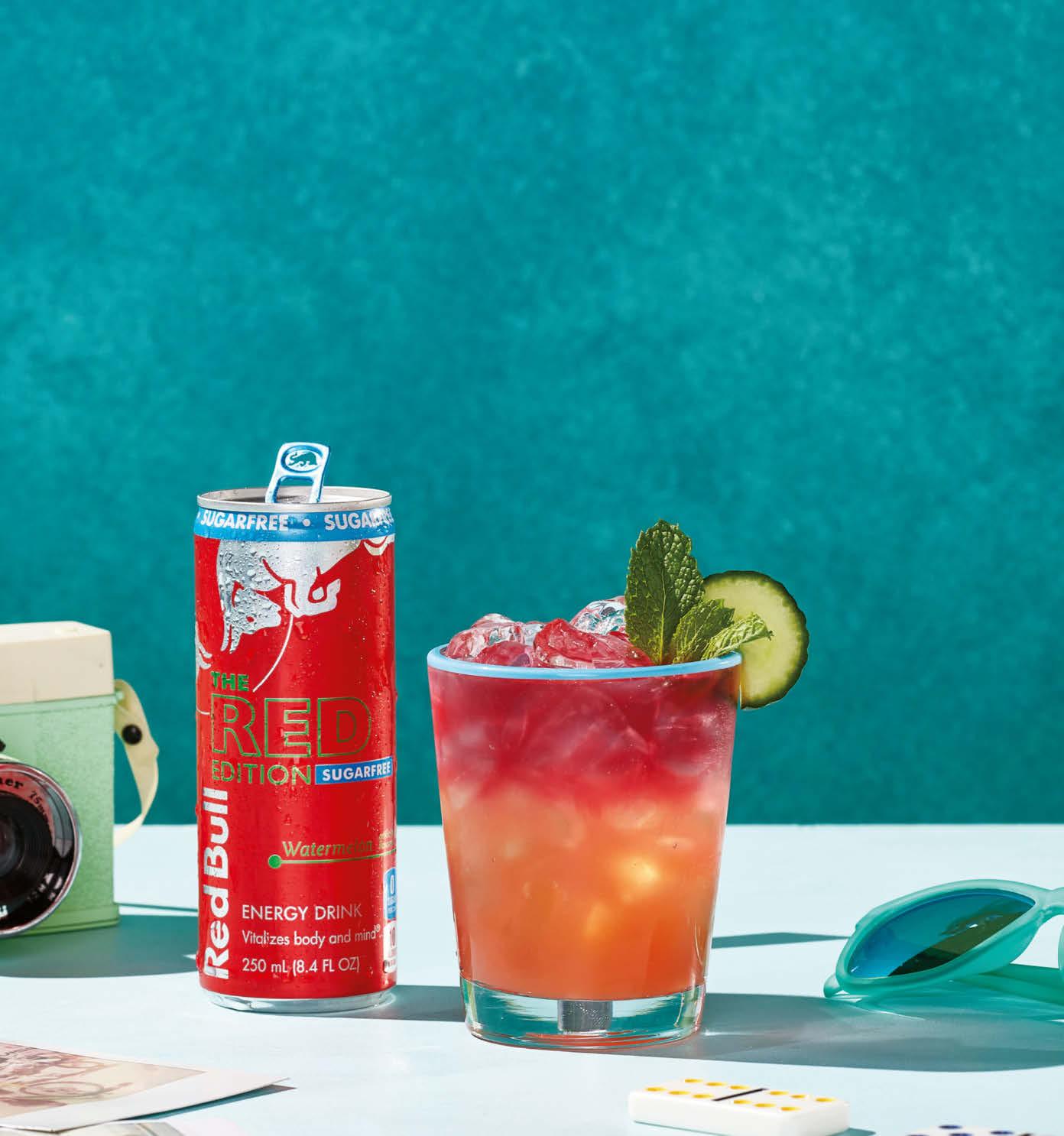

Saeed “Hawk” House, also known as Cocktails By Hawk on TikTok and Instagram, is a content creator, recipe developer and bartender based in Los Angeles who personally loves a drink that’s “light, bright and not too complex.”
RECIPE
WATERMELON
FIZZ
Ingredients:
3 watermelon chunks (1 inch cubes)
3 cucumber slices
8 mint leaves
₃⁄₄ oz fresh lime juice
₃⁄₄ oz monk fruit syrup
(1 part monk fruit, 1 part water)
2 oz Red Bull Red Edition Sugarfree
Garnish: Mint sprig and cucumber slice
Directions:
Combine watermelon chunks, cucumber slices and mint leaves in a cocktail shaker and muddle. Add fresh lime juice, monk fruit syrup and ice. Shake and pour into rocks glass with fresh ice. Top with Red Bull Red Edition Sugarfree. Garnish with mint and cucumber slice.
Ready to make it yourself? Scan here to learn more about Red Bull Red Edition Sugarfree.

ENERGY BOOST
THE RED BULLETIN 11 Lew Robertson, Saeed House
POWER&GLORY PPOWER&GLORY OWER&GLORYOWER&GLORYPOWER&GLORY OWER&GLORY POWER&GLORYPOWER&GLORYOWER&GLORY OWER OWER&GLORY GLORY
GLORY GLORY GLORY GLORY GLORY GLORYGLORYGLORY OWER& 2024 ISSUE 2 THE RED BULLETIN QUARTERLY 14 Erriyon Knighton 24 Paul Rabil 26 Train Like a Pro 34 Blxst 36 MenaRD theExploringpursuitof true greatness THE RED BULLETIN 13

POWER & GLORY
14 THE RED BULLETIN
Knighton was photographed in Gainesville and Tampa, Florida, on March 15 and 16.
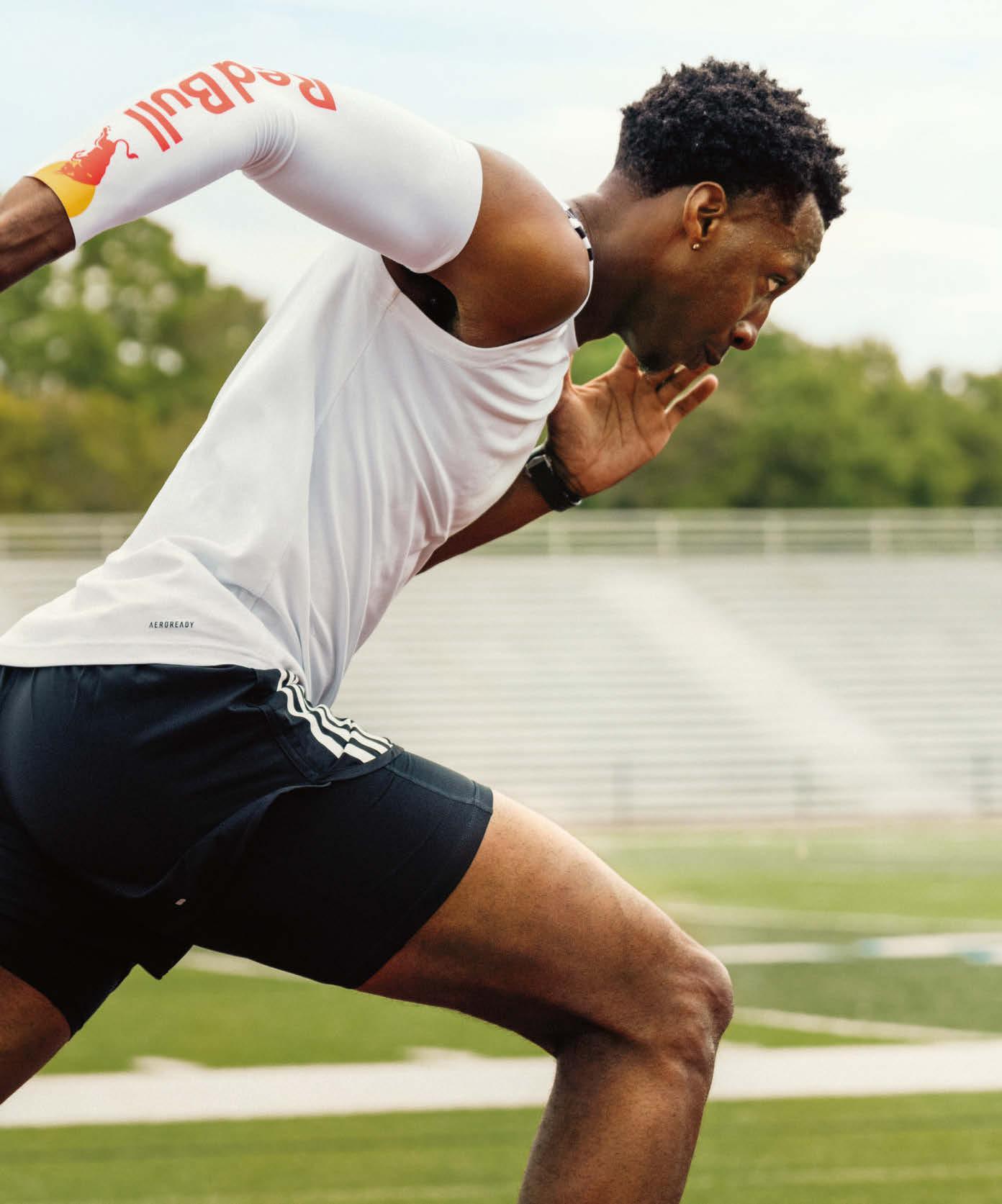
Young and bristling with world-class talent, sprinter Erriyon Knighton is having too much fun to take himself too seriously. But don’t be fooled; he’s ready for his moment.
ERRIYON KNIGHTON
WORDS BY PETER FLAX PHOTOS BY HANA ASANO
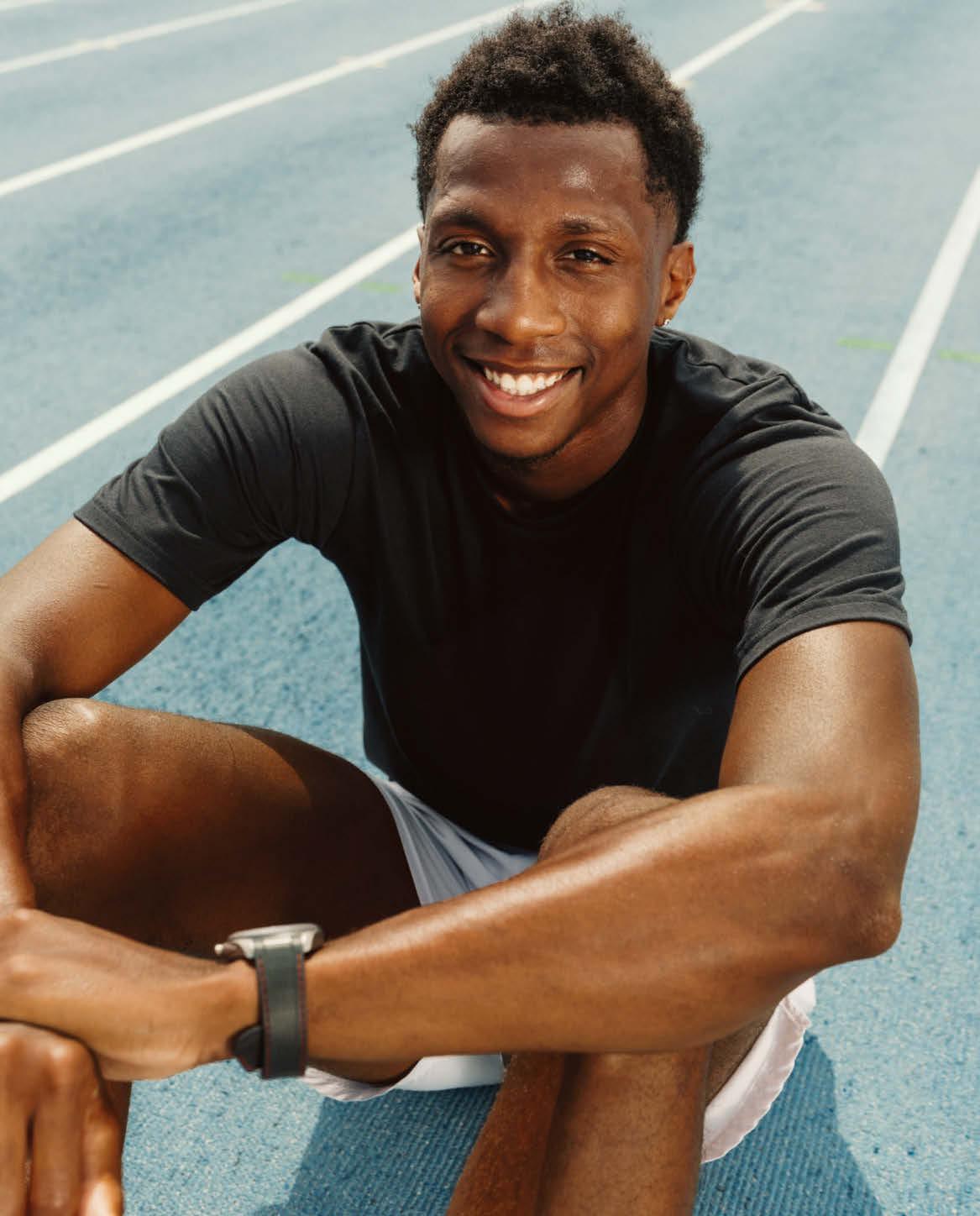
POWER & GLORY 16
It’s hard to explain just how fast Erriyon Knighton is with words. Ethereal world-class speed is like that. Most people have never been trackside to witness a fellow human being run 23 miles per hour. It’s just not normal. Think about it this way: In the time it’s taken to read this paragraph, Knighton can blitz 200 meters and start signing autographs.
Knighton likes to walk on the slow side. Presently he’s moseying on the infield grass at the track at the University of Florida in Gainesville. There’s a practice underway, and college and elite athletes are doing hard intervals. The 20-year-old phenom understands that one of the best ways to train the body to go super fast is to run super fast. The rest of the time, he sees no reason to hurry.
Every athlete present has serious wheels, but Knighton inhabits a different plane. Most top sprinters manifest raw power when they hit top speed; there’s an aggression to the way their feet pound the ground and how their arms pump like pistons. By contrast, Knighton radiates this kind of smoothness that belies just how fast he’s going. It’s not simple for an observer to gauge the depth of his effort but it is quite easy to admire his graceful long stride and see that he’s faster than those around him. After another all-out interval, Knighton walks slowly, looking for shade with an easy smile on his face. It’s got to be fun to uncork that kind of pace on a daily basis.
Many of the world’s top athletes have an obsessively singular focus on perfecting their sport. Knighton is not like that. He trains his ass off, sure, but he doesn’t seem to overthink what he’s doing. He knows that he has a one-in-a-million gift—if we’re being literal, it’s more like a one-in-one-hundred-million gift—and he knows that it’s on him to reach his full potential, but beyond that he’s basically living in the moment, having fun and refusing to make his avocation more complicated than it has to be.
“I don’t focus on anything when I run,” he laughs after being asked about his mental checklist during championship races. “I just step on the track and let my body do the work. I just show up and run. I’m a simple guy. I go get the job done and then leave.”
You have to admit—he makes it sound simple. But the young man has been getting the job done in a manner that boggles the mind. Erriyon Knighton is presently the fifth-fastest 200-meter sprinter in the history of humankind. Only Usain Bolt, Michael Johnson, Noah Lyles and Yohan Blake—all icons who have won world championship and/or Olympic gold—have covered the distance faster than the astounding 19.49-second performance Knighton laid down in 2022. And as we’ll recount soon enough, he has seemingly come out of nowhere to race at that level.
The level of youthful, angst-free cool that Knighton brings to world-class sprinting—a discipline that is famous for huge egos, overworked sports psychologists and endless mind games—is off the charts. Given that he’s again on the verge of competing for glory on the world’s biggest stage, it seems reasonable to ask him how he deals with the seemingly unavoidable weight of expectations. “I don’t feel any pressure. I’m just out here having fun,” he says. “The best advice I have about dealing with pressure is just not to think about it.”
Knighton, a specialist in the 200-meter dash, won the event at the 2023 USA Outdoor Track and Field Championships with a time of 19.72 seconds.
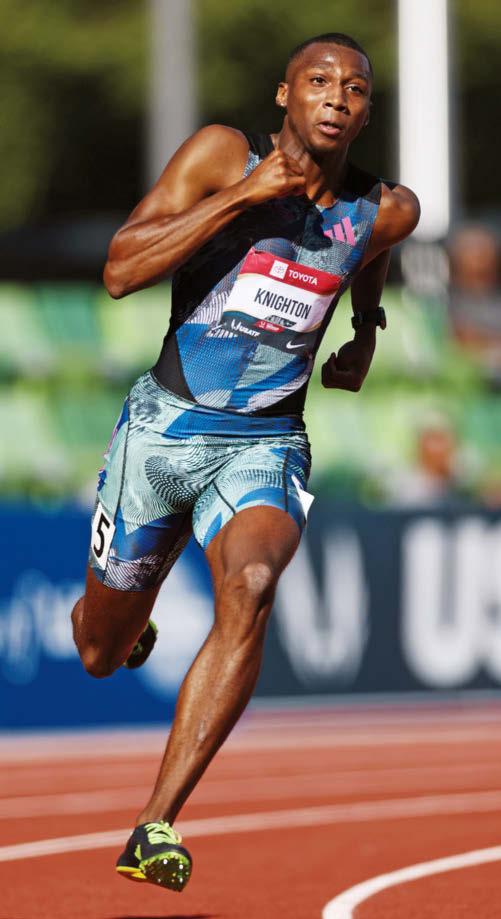
ERRIYON KNIGHTON
THE RED BULLETIN 17 Getty Images
POWER & GLORY
Most world-class athletes have a pretty familiar origin story—they showed outlier talent as a youngster, did their 10,000 hours of apprenticeship and eventually validated their obvious gift. You’ve heard that one a million times.
Knighton has a different story. His is the tale of a phenomenal athlete who discovered his specific gift by accident and then instantly transformed it into results that typically take years to cultivate. He essentially went from being a teenager who’d never run track to being a sponsored pro on the international stage in a couple years. The kind of thing nobody does. This likely explains that easygoing smile that often resides on his face.
Let’s go back to 2019. Five years ago, Knighton was a freshman at Hillsborough High School in Tampa. He was a terrific basketball player and a superlative football prospect. With outstanding speed, finesse and instincts, he was good enough at wide receiver to get a four-star ranking from 247Sports—an assessment that projected he’d be likely to get drafted into the NFL—and already had scholarship offers from top-tier college programs like Alabama, Auburn, Florida and Florida State. Anyway, one of his football coaches suggested he walk on for the track team in the spring. “I just did it because I wanted to stay fit during the off-season,” Knighton admits.
It was a decision that would change his life. He was instantly great, and the velocity of his development doesn’t resemble
something you’d normally read in a work of nonfiction. In the summer of 2020, just 16 and with only one season of track under his belt, Knighton destroyed an elite junior field in the AAU Junior Olympics, winning in 20.33, the world’s second-fastest time ever for an-under 18 sprinter (the first is some guy named Bolt). In a video of the race on YouTube, Knighton runs so fast that the rest of the stellar field isn’t even in the frame when he finishes.
That was just the warm-up act for 2021. In the span of several months, he turned pro with a flashy Adidas contract, ran 20.11 to break Bolt’s under-18 world record and then finished third in the Olympic trials, becoming the youngest American track athlete to go to the Games in any event since the legendary Jim Ryun did it 57 years earlier.
Think about that last sentence—in two years, Knighton went from a total track newbie to breaking Usain Bolt’s junior world record en route to the most important track meet on earth. But true to form, he just kept training and sprinting, refusing to lean into the hype of his improbable ascension. “I’m aware no one has done it on this level,” he says with a shrug. “I was playing football and made the Olympics just training with my high school coach.”
In Tokyo, Knighton would finish fourth, missing bronze by less than two tenths of a second. His trajectory has hardly stalled from there. In the 2022 World Championships, Knighton won the bronze medal in the 200-meter dash. And last year, he came back
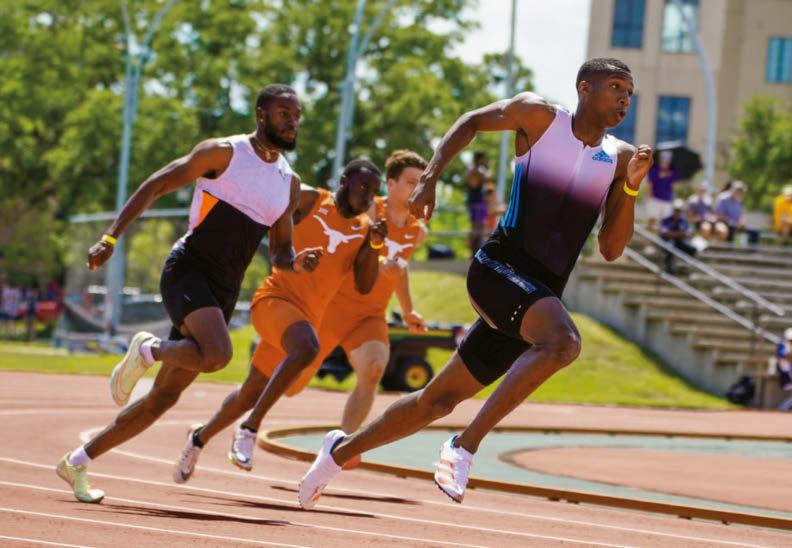
At the 2022 LSU Invitational, Knighton—who was still in high school— won the 200-meter dash in 19.49, a world junior record that makes him the No. 5 performer in history.
“I think people should make goals that seem out of reach—and then go chase it.”
18 THE RED BULLETIN
C
Bryan
Wayne
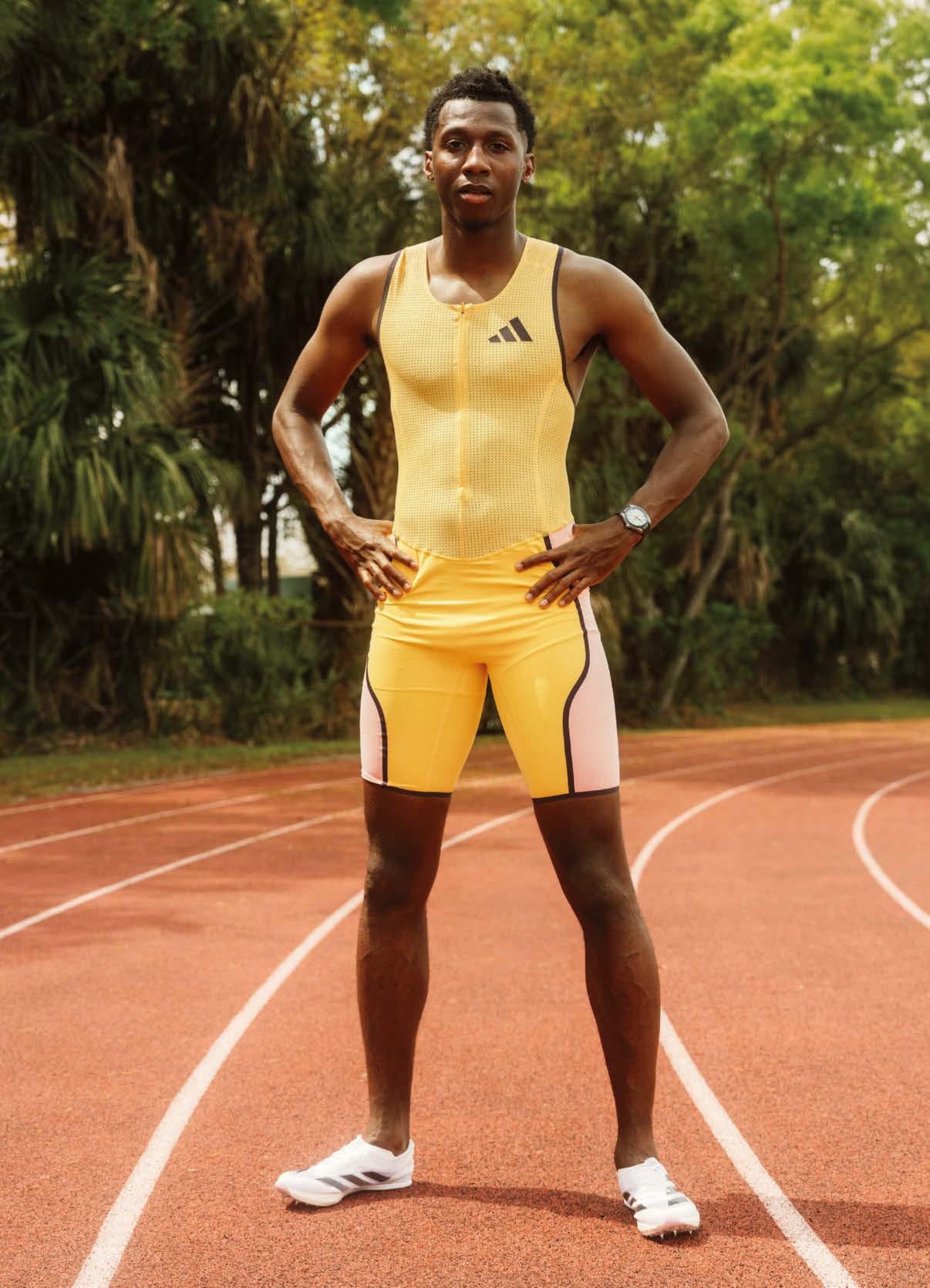
ERRIYON KNIGHTON

POWER & GLORY 20 THE RED BULLETIN
Images
Getty
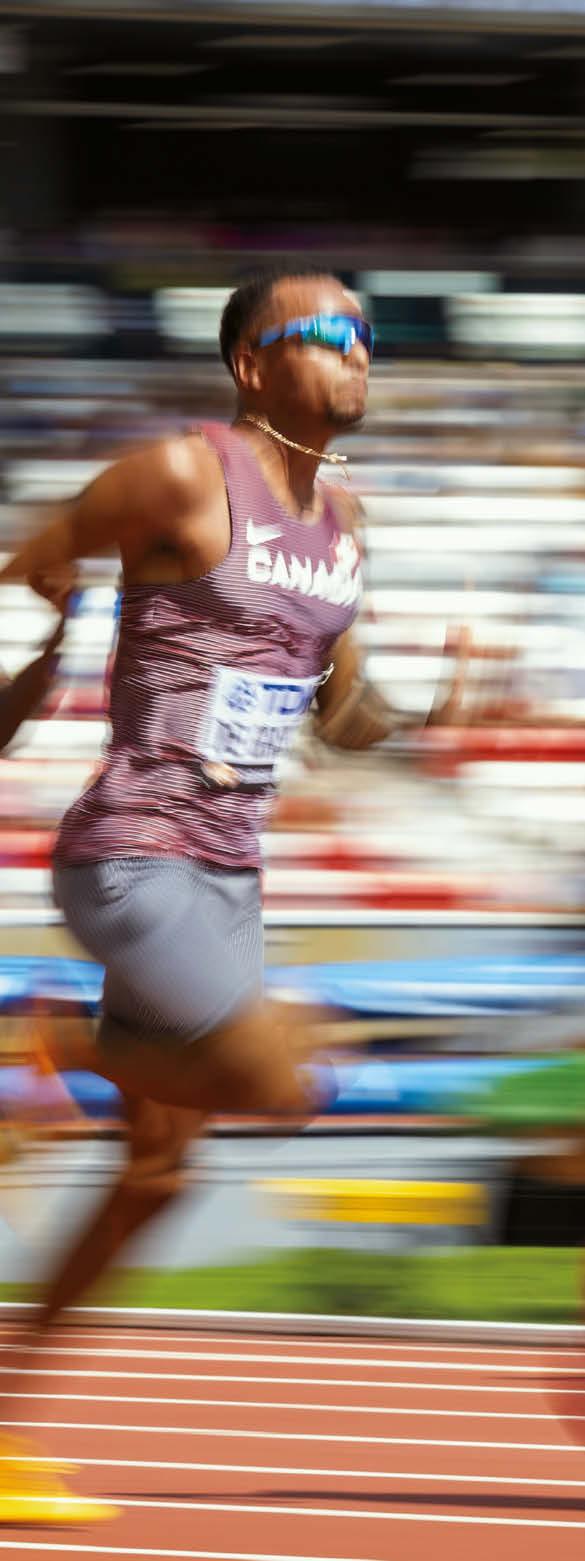
to Worlds and cruised to a silver medal with a 19.75 performance. He’s aware that there’s only one more step to climb.
In conversations attempting to deconstruct the components of his success, Knighton playfully declines to take his process too seriously. Beyond doing his prescribed workouts and managing his sleep and diet, he refuses to treat his profession like some kind of a complicated science project. He doesn’t have mantras and he doesn’t journal and he doesn’t break his best event into a series of subcomponents that require dissection. “I don’t understand exactly why I’m so fast,” he says. “But I know I can hold my top-end speed longer than other people. And I just like running the turn.” (If you’re not familiar with track and field disciplines, the 200-meter dash is half a lap on a regulation track, favoring sprinters with a bit of endurance and an ability to reach top speed while arcing the turn.)
Just a few years after walking on to his high school track team, he walks through stadium tunnels into giant, sold-out arenas around the world for Diamond League meets. There, he goes head-to-head with the fastest veterans in athletics, many of whom turn their prerace rituals into a made-for-TV peacock exhibition.
But again, Knighton just takes it all calmly in stride. “The only thing I pay attention to is how many people are in the stadium,” he says with a grin. “So as soon as I get on the track I just look around.” One of Knighton’s favorite things about his blossoming pro career is the way it has allowed him to travel the world. His favorite Diamond League and world championship stops so far are Budapest, Brussels and Rome.
Knighton is uncomplicated but the young man is not naive. He is aware of the head games being played and the pressure his competitors feel. Knighton is just a conscientious objector. “I am not at the age where I literally have to take it seriously,” he says. “And I put more pressure on everyone else because I’m just out there having fun. It makes it harder for other people who just don’t want to get beat by someone so young.”
On the day after the track workout in Gainesville—he trains there these days under the expert tutelage of veteran coach Mike Holloway, who has led the University of Florida’s track and crosscountry programs for more than 20 years, helping athletes net All-American honors a couple hundred times—Knighton is a couple hours south in Tampa, not far from where he grew up. He splits his time between the two cities, and when he’s in Tampa, he works out at Jesuit High School.
Knighton is willing to indulge questions about his training but loves to talk about his other passions. He says he has not yet run a perfect race and believes the best way to get faster is to get stronger. “Every day that I train, I lift weights,” he says. And though he gives off easygoing vibes, Knighton and his coach make it painfully clear that honing his mountain of talent requires dedication and suffering. Pondering 90-second sprint intervals on hot Florida mornings, he says, “That’s the hardest thing I’m doing right now.”
Knighton (far left), shown here on his way to victory in a 200-meter heat at the World Athletics Championships in Budapest last August. He went on to earn a silver medal in the fnals.
ERRIYON KNIGHTON
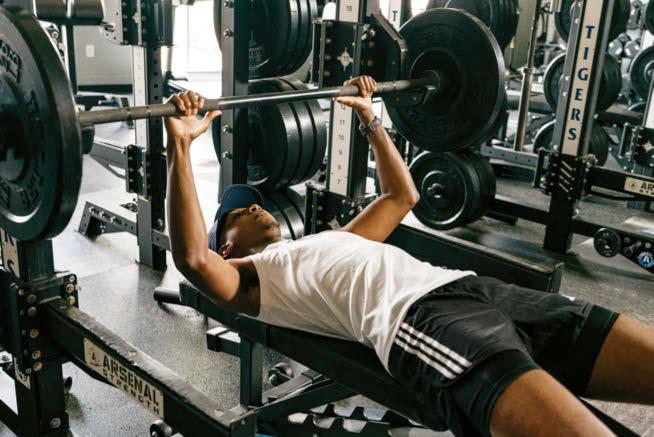
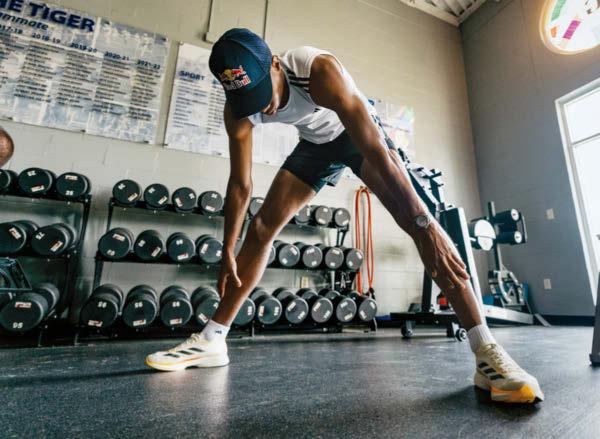
His coach adds some texture. “Erriyon works very hard at this,” Holloway says. “He works hard on running the turn and he understands that the little things produce greater results. We talk constantly about having a ‘no days off’ mentality, and he definitely gets it.”
But if you want this young man to light up, ask Knighton about his hobbies. “I’m interested in fast cars and trucks,” he says with a sly smile, boasting how he’s about to trade in his totally loaded Ram 1500 TRX for something even sportier. Knighton loves to fish (“mostly off docks on Florida lakes”) and to ride dirt bikes and go four-wheeling in the mud and try out every conceivable extreme sport. He has suggestions of the best spots in Tampa to get a Cuban sandwich or a guava pastry. He doesn’t consider himself a serious gamer but he does like to lay around after a workout and play Call of Duty: World at War— Zombies.
Knighton is not particularly interested to talk about his early life or challenges he faced to reach where he is today. It’s as if he’s too engaged with the present to sit around and reflect about the past and the future, at least publicly. Many top elite athletes like to maintain a chip on their shoulders because it can help fuel their competitive fire, but if Knighton feels that way, he plays it close to the vest.
His coach offers a clue. “He’s gone through things in his life,” Holloway says. “When I used to line up on a track, there was nothing scary about a track compared to things I went through in my everyday life. I think it’s like that for him.”
In any case, Knighton wants to keep chatting about his other interests. He’s been to a few NFL games, but honestly he’s more hyped about seeing Formula 1 or motocross events like Red Bull Day in the Dirt. When asked if he’s ever jumped out of a plane, he sits up and says “No—but I’d do that right now if we could.” He says he’s going to swing by a local dealership after the interview to look at a truck.
He shakes his head from side to side when asked if he feels any regrets when he goes to an NFL game, seeing the hoopla and knowing he’s faster than anyone else in the league. Nope. “There are lots of young NFL players who’ve never left the U.S. and I’ve gotten to travel the world,” he says. “And anyway, there’s nowhere I go where I’m not the fastest person.”
After two full sessions of wide-ranging questions and funloving answers, I finally tap into Knighton’s serious side when I ask him a question that seems certain to be deflected: Does he have any big life goals he’d care to express?
“I don’t think people should make goals that are easily in reach,” he says philosophically. “I think people should make goals that seem out of reach—and then go chase it.”
He pauses for a moment and then says the quiet part out loud. “The goals I’ve got for myself are setting a world record and winning championship races,” he says. These are extremely bold objectives for a fun-loving 20-year-old to express, but it’s probably not wise to bet against Erriyon Knighton, who has one more goal he’d like to express on the record. “I also want 30 acres, with pigs, horses and goats.”
POWER & GLORY
Knighton, shown here training at the gym at Jesuit High School in Tampa, says he integrates lifting into every day he works out. Knighton splits his time between Tampa, where he grew up, and Gainesville, where his coach is based.
22 THE RED BULLETIN

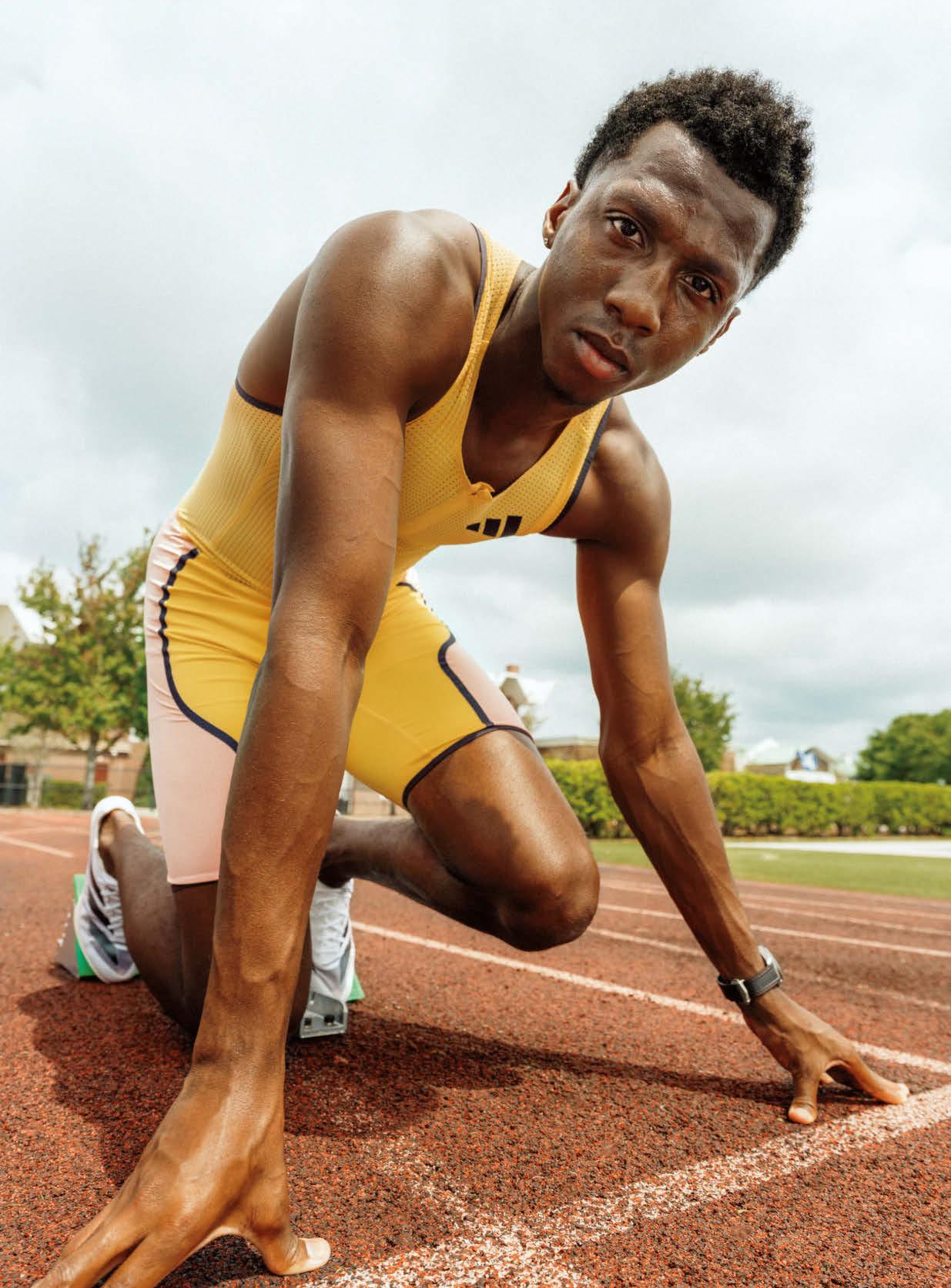
ERRIYON KNIGHTON
POWER & GLORY Secrets of Success
Rabil has curated the wisdom he has gained about winning, both on and off the feld, in a new book.
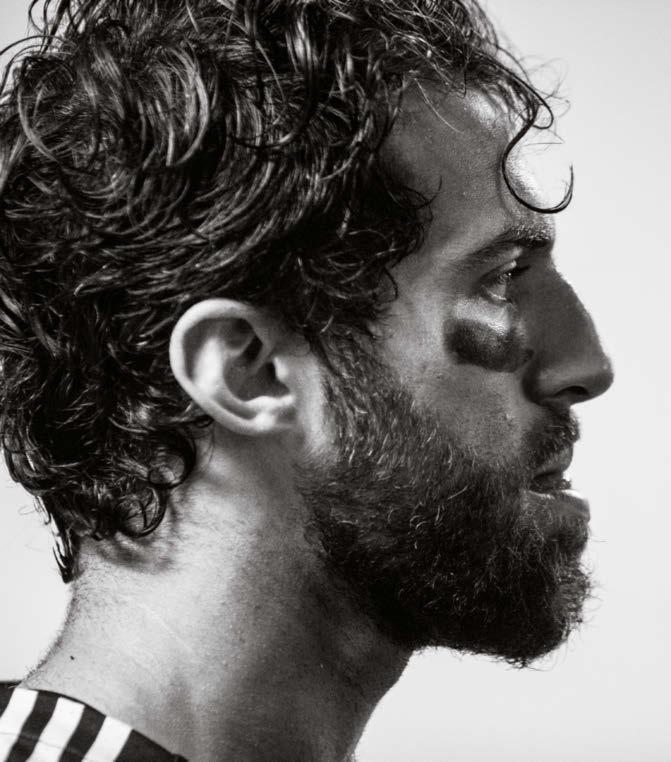
EVERY TRICK IN THE BOOK
Lacrosse legend, budding sports mogul and frst-time book author Paul Rabil shares some of the secrets of his success. and his dreams to introduce his sport to a global audience.
BY PETER FLAX
Paul Rabil has always been serious about winning. He’s acknowledged as the greatest lacrosse player in modern history—described as the “LeBron of Lax”— and has gone on to score big wins of the playing feld, co-founding the Professional Lacrosse League and leading the campaign to bring the sport back into the Olympic fold. Along the way, he has absorbed lessons from a wide range of generational pro athletes and public fgures. The highlights of this education have been distilled into a new book, The Way of the Champion. Here, Rabil answers questions about the book and his vision to grow the sport he loves so dearly.
Do you think the book accurately refects how you approached your sporting life?
Yes. It’s a manual of different lessons, some of which intentionally contradict each other. If anyone tells you there’s one blueprint to becoming a champion, they’re full of shit. We all come from different walks of life, with unique skill sets, mannerisms, maturity levels and approaches. As an example, I always point out the contrasting ways two all-time great footballers, Pelé and Tom Brady, approached competition. Before a game, Pelé would lay down on bench, put a cold towel over his eyes and meditate, thinking about the ball touching his foot and then going into the goal. Meanwhile, Tom prepped for big games by manifesting anger, raising his level of intensity and heightening his senses to play at the highest level. So I think people can read the book and pull the lessons that will work for them.
Many of the lessons you cover in the book seem to apply to endeavors beyond sports. Was that intentional?
That happened more organically than I planned. But now it seems obvious. When you look at the business world, many top companies have an affnity for hiring athletes. That’s because a lot of the lessons people learn as student athletes transfer to the rest of their lives. You see that the more you practice, the better you perform, whether that’s for a game or a big test or an entrepreneurial pitch.
But the book also teases out some discoveries you’ve gained on how sports and business require different skills, right?
Sports is binary—it’s all about whether you win or lose. In business (or in romance or life in general), if
ON THE RECORD
24 THE RED BULLETIN PLL Media, Shawn Hubbard/Red Bull Content Pool
you make everything about just winning or losing, you’re probably going to lose. I’ve found that the after-sport life is actually about compromise. That was a big transition. It was like, oh shit, I’m in the boardroom and I need to create a solution that’s good for my board members, the company, our employees and the players. This means everyone has to give a little. That doesn’t really exist in sports.
The book shares wisdom from so many successful people in and out of sports. Can you name a few who have impacted your journey?
On the sporting side, I’ve learned a lot from Steve Nash and Sue Bird. Steve, who played at the highest level until he was 40, shared tons of insight on how to thrive in the last third of my career. That sometimes, no matter how much you try to sleep, eat, work out and recover perfectly, that you can show up to train and be off. His input was to shut it down in that case—and, if you’re older and feel great when you hit the gym, to double down on your workouts. Sue has been a mentor for a long time, and she really helped me react to slumps. Her advice was one of recall—to remind myself that I had reached this level because I’d hit shots a thousand times. So if I missed my last fve shots, I’d remind myself, who gives a shit? I’ve hit tens of thousands of shots like this and I just need to get back out there.
Outside of sports, two mentors have been Tom Cruise and Dwayne Johnson. When I was building the PLL, I spent time with Tom and his team to study how he juggled being the producer and the star of a flm that grossed $1.5 billion. I aspire to that kind of duality. And from Dwayne, I observed how a mega star of the highest level always retained an ability to connect with athletes from any discipline at any age.
A lot of Americans don’t yet know that lacrosse will be back in the Olympics for the frst time in more than a century in 2028. Can you explain why this matters?
Since I turned pro and began playing with Team USA, people have asked me if lacrosse is an Olympic sport. And that’s because the Games are a universal language for fans of sports—representing the ultimate competition and global unity. The history of lacrosse matters—that it’s an indigenous game with North American roots. And now we have this chance to highlight those roots while exposing a global audience to the beauty of the game.
Are you at the point in your life where you spend time thinking about your legacy?
Not exactly. Fittingly, the last chapter of my book is entitled “Forget Me.” I realize that I will have succeeded in many of my most important goals if I am forgotten. Because this means that the sport has taken off and more stars have emerged to advance the conversation. Right now, my big goals are success for the PLL, to create bigger stars, to get the sport on bigger platforms, with more distribution and coverage, and to expand the demographics of people who want to play and watch the game. Those things matter more than my personal legacy.
I think a lot of people perceive lacrosse as a sport for privileged suburban folks. But I suspect you see it differently.
Yes. The history of the sport is amazing. It’s a Native American game that originally was played for miles on end with hundreds of people per side. It had a spiritual component and was also used to solve confict. These roots are important.
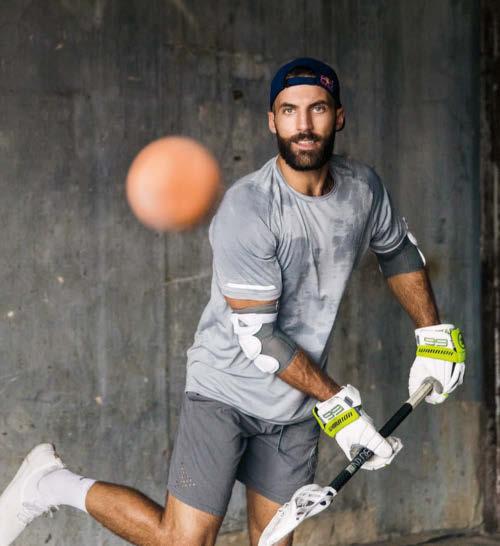
That said, the version of the game we have today runs in parallel to a caste system in society. Sports like lacrosse, hockey, golf and even football are expensive to play. They require helmets and pads, ice time, green fees. So lacrosse has been associated with elitism or privilege because it is not inexpensive. But the paradigm is already shifting. We actually have far greater diversity in our sport at the pro level than what most people think. In fact, we have more Black and brown and indigenous players than the NHL and the PGA tour. And that momentum is picking up speed. In 2022, there were 72 Black Division 1 lacrosse players. And in 2023, there were 159. That’s a 120 percent increase year over year. That’s unbelievable progress.
What’s the thing that you love most about lacrosse that you want people to appreciate.
For me, it has always been its artisanship. It’s the only team sport where athletes can construct their implement by hand. You can string your own lacrosse head. You tape your handle the way you like it and then you use it like a brush and make the feld your canvas. The game is beautiful in that way.

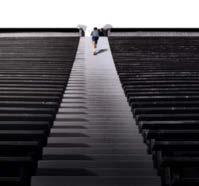
The Way of the Champion is in bookstores now. Follow @paulrabil on Instagram.
The Way of the Champion PASS # Emboss CMYK Jen Heuer Kathryn Ricigliano PROD MGR: Please include live files in case major changes are needed on press PDF FILE TYPE: Jen Heuer ART DIRECTOR: F PAUL RABIL FROM LACROSSE PAUL RABIL, ON BECOMING CHAMPION—IN BUSINESS, Long before Paul Rabil had acclaimed player, the sport’s the cofounder of the Premier strove for greatness. Te problem was he lacked it—so he set out to create one Belichick about how to prepare, to practice, Sue Bird about how Mark Cuban about how to build From the wisdom of these and his own—often painful—trial manual he always wanted. Te Way of the Champion is Rabil learned on his path to lacrosse players of all time. But book. It is also a guide to embodying set—in coaching, in business, According to Paul, “No one It can only be earned—through execution, and sheer determination. championships, business deals, learned that our best moments most devastating defeats—when unwavering resolve. Tat’s the Paul Rabil is former professional lacrosse player and cofounder of the Premier Lacrosse League, the 2020 Sports Business Awards Breakthrough League of the Year. Rabil holds the all-time scoring record in professional lacrosse; has won championships and MVP awards as a college, professional, and international athlete; and is a two-time World Lacrosse Champion with Team USA. The New York Times called Rabil “the LeBron James of Lacrosse,” and he was named Top 40 Most Entrepreneurial Athlete by Entrepreneur magazine. In 2011 he started the Paul Rabil Foundation, with the mission of helping children with learning diferences through the power of sport, and in 2019 he founded PLL Assists, which is focused on lacrosse accessibility, diversity, equity, and inclusion. He lives in Los Angeles and New York. Jacket design: Jennifer Heuer Jacket photographs: Matt Woolverton, PLL Media Author photograph: Brett Roberts, PLL Media ADVANCE PRAISE FOR The Way of the Champion “Paul Rabil is an inspiration—ft, soulful, and concerned with the greater good.” — Scott Galloway, Professor of Marketing at NYU’s Stern School of Business and author of THE ALGEBRA OF WEALTH “Invaluable stories on leadership, resilience, and the unwavering pursuit of one’s goals.” —Sue Bird, WNBA, NCAA, FIBA, and Olympic champion “I thought knew all the keys to winning and losing, success and failure. Tis entertaining, insightful, inspiring book taught me that I still have so much to learn.” —Tom Rothman, chairman and CEO of Sony Pictures Motion Pictures Group “Quick-hitting and poignant. Paul understands the mettle and grit it takes to go from amateur to pro, from pro to elite, from elite to executive—and the need to occasionally slow down to take care of the things in life that matter most.” — Paul “TRIPLE H” Levesque, fourteen-time world champion and chief content officer Of WWE “Paul Rabil unveils the secrets to achieving peak performance and resilience—not only for athletes but also for anyone striving for excellence in their chosen feld.” —Arianna Huffington, author, cofounder of HuffPost and CEO of Thrive Global “Rabil isn’t just lacrosse player, he’s savvy entrepreneur who knows how to win in the business arena. Te Way of the Champion reveals the strategies and mindset that have propelled the greatest athletes to victory, both on and of the feld.” —Gary Vaynerchuk, bestselling author and entrepreneur “In Te Way of the Champion Rabil shows us that it’s about more than just the process; it’s about falling in love with the process. Tat’s the true diferentiator.” —Jay Williams, Former NBA guard, NCAA champion, and ESPN analyst
PAIN, PERSistence, AND THE PATH FORWARD PAUL RABIL Foreword by Bill Belichick 6.125 9.25 SPINE: 0.875
The Way of the Champion
TRAIN LIKE A PRO
Two extraordinary athletes share insights on how they get into championship shape and prepare to perform to their full potential with the whole world watching.
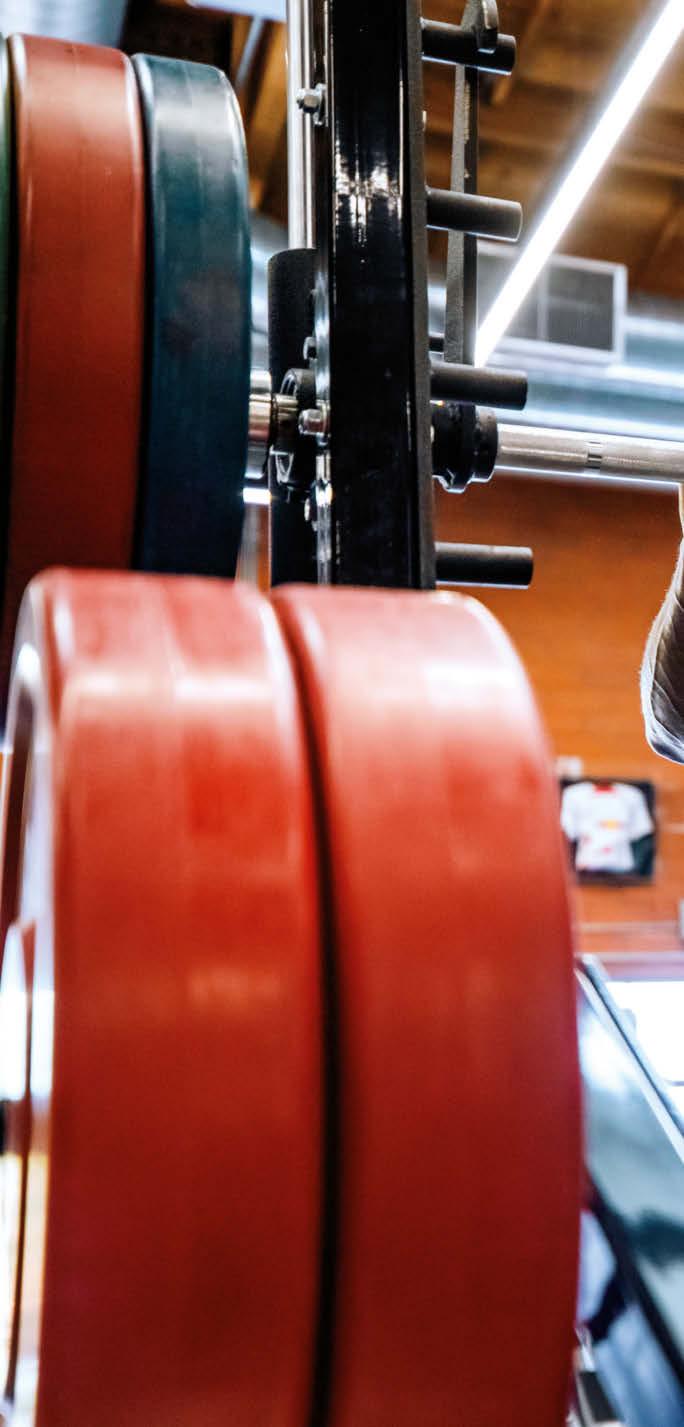 WORDS BY JEN SEE PHOTOS BY MARÍA JOSÉ GOVEA
WORDS BY JEN SEE PHOTOS BY MARÍA JOSÉ GOVEA
POWER & GLORY

THE RED BULLETIN 27
Will Claye Track
The two-time world champion triple jumper, 32, has been at the top of his game for more than a decade—and he’s determined to vie for glory in the biggest championship events.
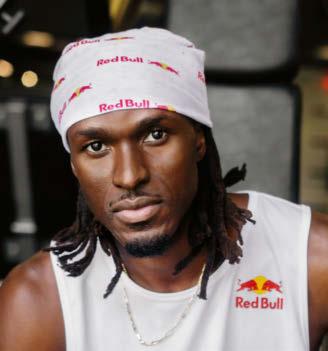
As a young athlete, Will Claye dreamed about an NFL career—until one day a track coach saw him play.
Impressed by Claye’s elastic, long-legged gait, the coach convinced him to give track and field a try. “Triple jump found me,” Claye laughs now.
Fortunately, he hit his stride quickly. In 2012, at age 21, he competed at the London Olympics, where he won a silver medal. Since then, he’s remained among the world’s best, and Claye has come to love his unique speciality.
“When you do it right, it feels like magic,” he says. “It feels so easy and effortless. It just flows when you do it right.”
The journey hasn’t always been easy. In 2019, a ruptured Achilles tendon threatened to end Claye’s career. He spent the subsequent season grinding through the rehab process, hoping that he could return to the top level. It was by no means a sure thing. “When someone has an injury like that, it’s like a horse that’s down and they just take it out,” he says. “That’s what it felt like everyone was trying to do to me.”
The experience gave Claye a renewed appreciation for the sport. “I wasn’t able to train for a while and I missed that,” he says. “I missed competing.”
Against considerable odds, Claye made it to Tokyo, where he finished fourth by a small margin. The result might have been a disappointment, but instead it opened his mind and refired his imagination. “I felt like if I could do that, there’s so much left,” he says. Since his injury, Claye, now 32, has paid closer attention to the details. “It has made me work on the smaller things more,” he says. “When you’re younger, everything just comes to you.” As an example of his new and improved routine, he uses bands daily to strengthen each toe individually and to work his ankles through their full range of motion.
Despite his long career, the first day of practice each season still feels the same to Claye, as it did way back in high school. “It never gets easier,” he says. “Sometimes, I’m like, dang, I don’t know if I still got it.” But each week, he can feel his body respond to the training he’s doing. Claye attributes his longevity to the satisfaction that slow evolution gives him. “It’s about loving the process of seeing your body transform into a high-caliber athlete.” As the weeks pass, he turns up the speed and dials in the precise footwork the triple jump requires. “Four or five months later, it’s like, oh yeah, it’s time to go get them again.”
TRAINING FOR SPEED
High-end speed is critical in the triple jump. To prepare for the discipline’s running start, Claye does hard 200-meter repeats on the track. “Those sprints are long for me, because our runway approach is only 40 meters,” he says. As championship events approach, he increases speed and intensity, doing all-out 30- and 50-meter sprints. “I also do overspeed work,” he says. “It turns my nervous system on and exposes my body to faster speeds.”
“It never gets easier,” says Claye, whose longest triple jump— an astounding 59 feet, 6 inches— ranks him third alltime in the world.

POWER & GLORY
28 THE RED BULLETIN
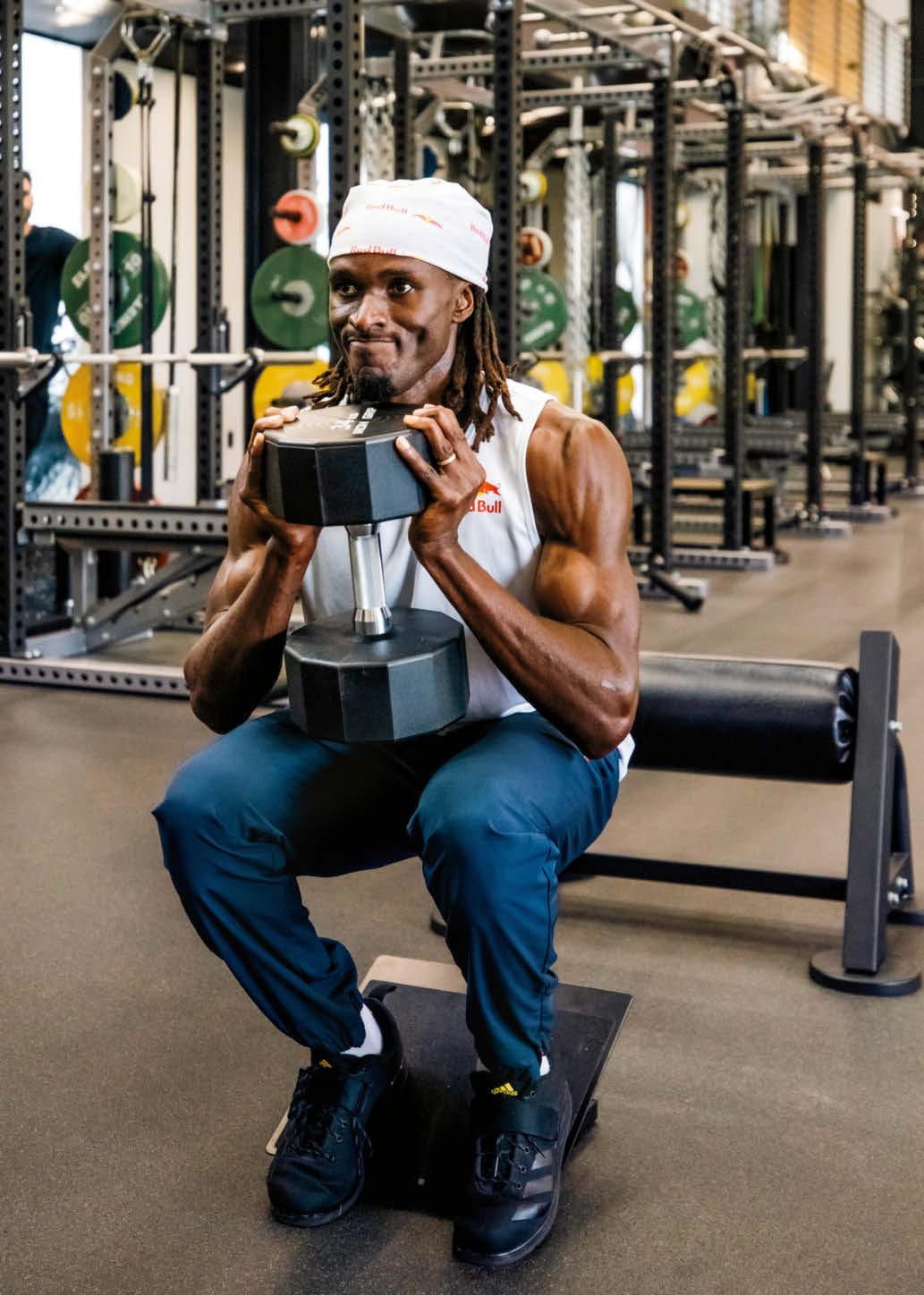
PERFECTING RHYTHM
“I like to put pressure on everyone early,” says Claye, who gets to execute six jumps in a competition round. Dialing in his rhythm and stride length is key, because he has to launch from a precise spot at top speed. “There’s a line, and if I cross it, my jump doesn’t count,” he says. “So I have to be positioned perfectly.” He marks his shoes with chalk to check his stride and tweak his approach. “I work on that to be so precise that I don’t have to look at the board.”
BUILDING STRENGTH
In competition, Claye hits the ground with a force 15 times his body weight. He does squats, lunges and cleans to build strength, and isometric exercises for early-season power. “It’s a maximum effort against something that doesn’t move.” Using a squat rack, he pushes against a bar loaded with more weight than he can lift. To keep his lunges as precise as his jumps, he fnds a mark on the foor. “That way I know where I’m at for each rep, so they’re all the same.”

WILL CLAYE
Victor Montalvo B-boy
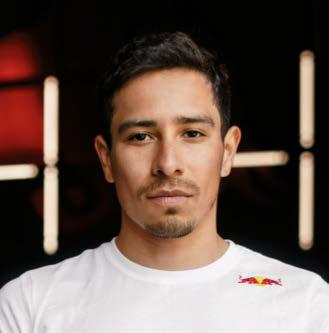
B-boy Victor Montalvo can still remember trying to learn the windmill at age 10.
“I just couldn’t get it,” he says. It frustrated him, but he refused to give up. “I felt like, ‘This is a challenge I need to beat.’ ” After spending years playing video games all day, Montalvo had found a new passion in breaking. With stubborn determination, he began to tick off one power move after another. And along the way, he discovered that he possessed a natural gift for breaking’s dynamic acrobatics. “When I first started learning, I didn’t know much about breaking,” says the 30-year-old Florida native, who won his first Red Bull BC One World Championship in 2015. “I learned the hard stuff first.”
Then, at the height of his competitive success, Montalvo fell out of love with breaking. He believes now that he’d become too focused on training and competition. “I got so stuck on the moves that I forgot about the movement and the music,” he says. In pursuit of renewed inspiration, he turned back to some of breaking’s original innovators. “I’ve learned the art of it,” he says. “The essence of breaking is having your own individual style.”
Of course, building strength and flexibility is still important for Montalvo, and to that end he hits the gym daily. But the dance comes first. “I want to go all out,” he says. “I used to work out in the gym first, but I wasn’t able to do the moves I wanted to do.” So now he dances first and trains later.
Montalvo has 30 to 40 signature moves and rehearses multiple entry and exit moves for each one, because he never knows how he will piece them together in competition. There’s no routine to his practice. It’s all spontaneity and flow. “I try not to organize myself too much, because then I start looking robotic,” he says. “Breaking is about being unpredictable and in the moment.”
This summer, with breaking making its debut on the ultimate world stage, Montalvo will represent his sport—and the U.S.—in front of a new audience. “I feel like it’s up to me to show this audience what breaking is all about,” he says. When he hits the stage, he’ll dance in an intense 30- to 50-second burst of movement. Then he’ll watch his opponent try to match him before it’s his turn again. Each one-on-one duel lasts roughly five minutes. Breaking is fast-paced, high-intensity art, and for Montalvo, the dance is everything. “I want to be innovative,” he says. “I want to create my own path and inspire others.”
“Everyone feels pressure, so I try to stay in the moment,” says Montalvo, who won Red Bull BC One in 2015 and 2022.
RECOVERY ROUTINE
After a workout, Montalvo hits the ice bath for fve to seven minutes. Then he heads to the sauna. “I feel like it relaxes my muscles and it helps me recover faster,” he says. Living near the coast means there’s a natural ice bath readily at hand. “There’s times when I go to the beach and go swimming for a bit.” Montalvo likes to eat protein after workouts, which sometimes means a stop at In-N-Out. “I’m burning so many calories, I just eat as much as I can.”
THE QUEST FOR POWER
In the gym, Montalvo focuses on bodyweight workouts that mimic breaking’s movements. “I do a lot of moves where I go from my back to a handstand to a onehanded spin,” he says. To build that kind of strength, he does lots of push-ups. Breaking requires a strong core, especially the external abdominal obliques, which support twisting and provide balance. He hangs from a bar and does twisting leg raises to work those muscles.
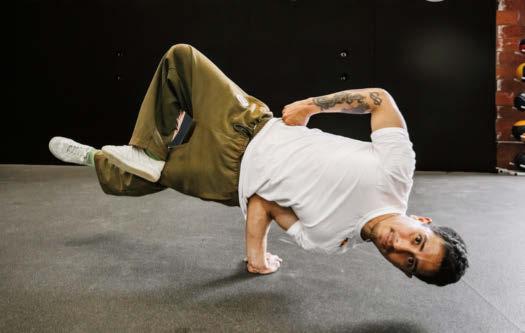
POWER & GLORY
The champion B-boy is melding scientifc training and a devotion to his art to prep for breaking’s debut before a worldwide audience this summer.
30 THE RED BULLETIN
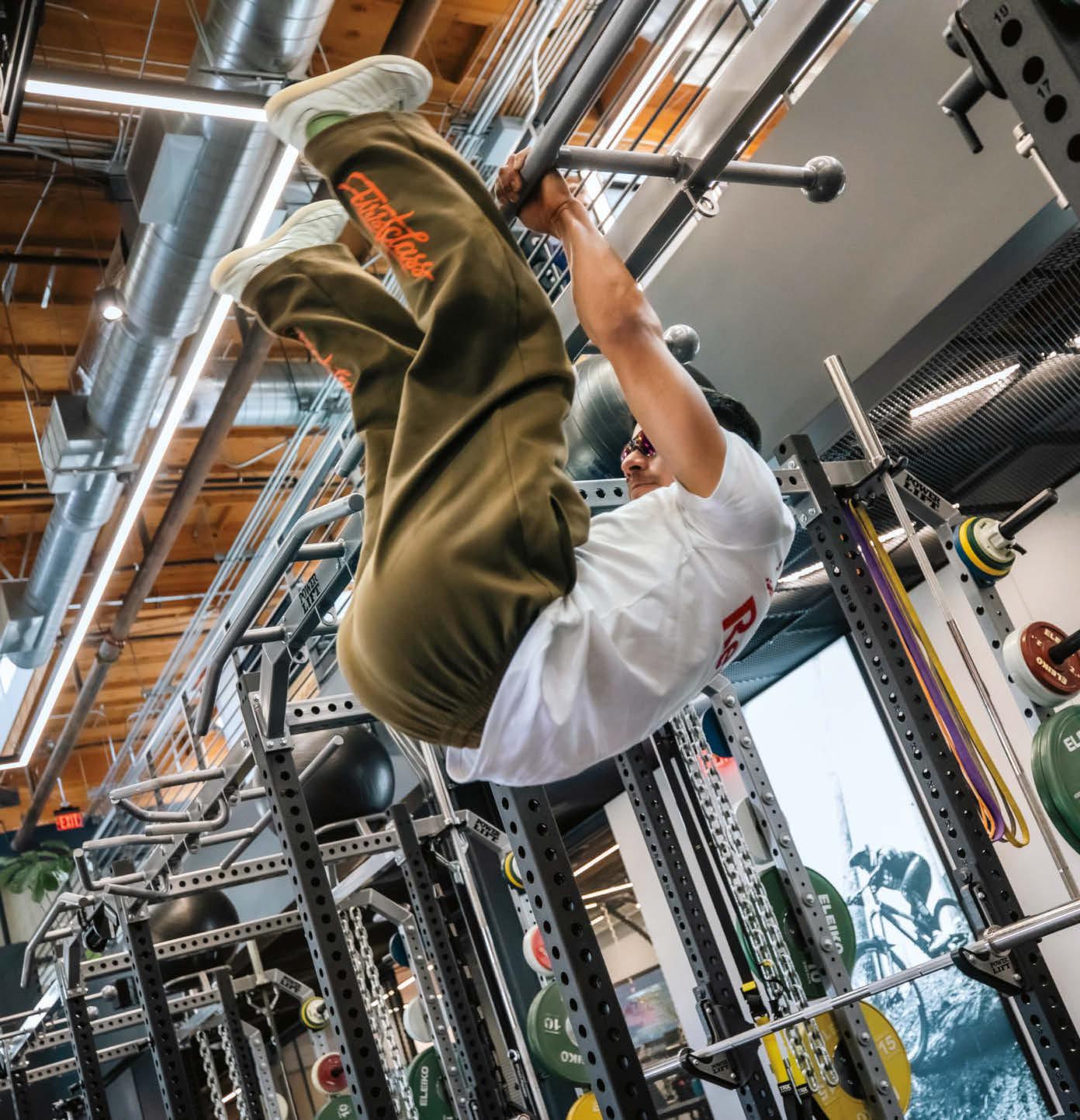
HONING MENTAL STRENGTH
Breaking requires massive concentration. If Montalvo makes a mistake, he needs the poise to play it off and improvise. “Breaking is super physical, but I feel like it’s more mental,” he says. “I try to get into a fow state and stay in the moment.” Before each round, he talks himself up. “I give myself this crazy confdence boost, so I believe in myself.” Listening to the music, he creates each dance spontaneously. “I don’t do it for the crowd. I do it for myself.”
VICTOR MONTALVO
Claye and Montalvo were photographed training at the Red Bull
Athlete Performance Center Los Angeles on April 11. Both athletes expressed admiration for the other’s athleticism and soul.
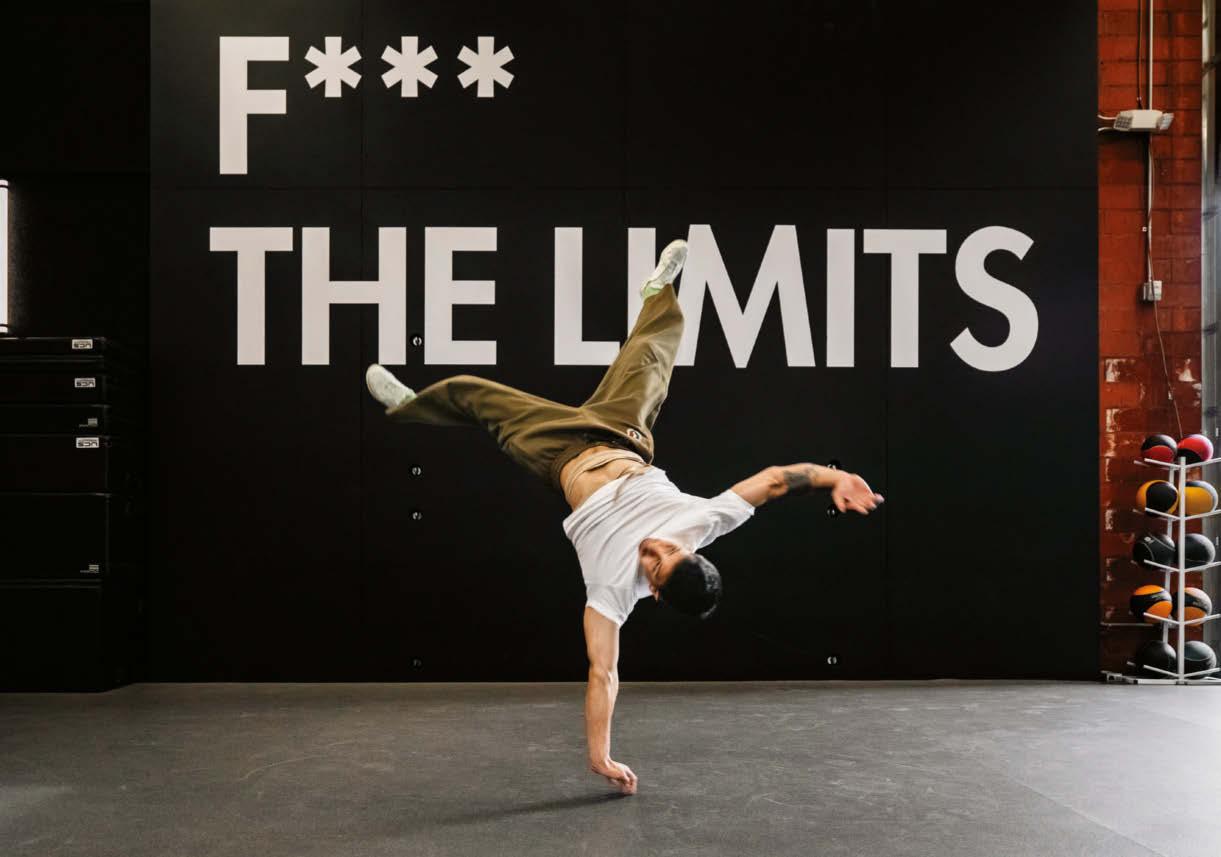
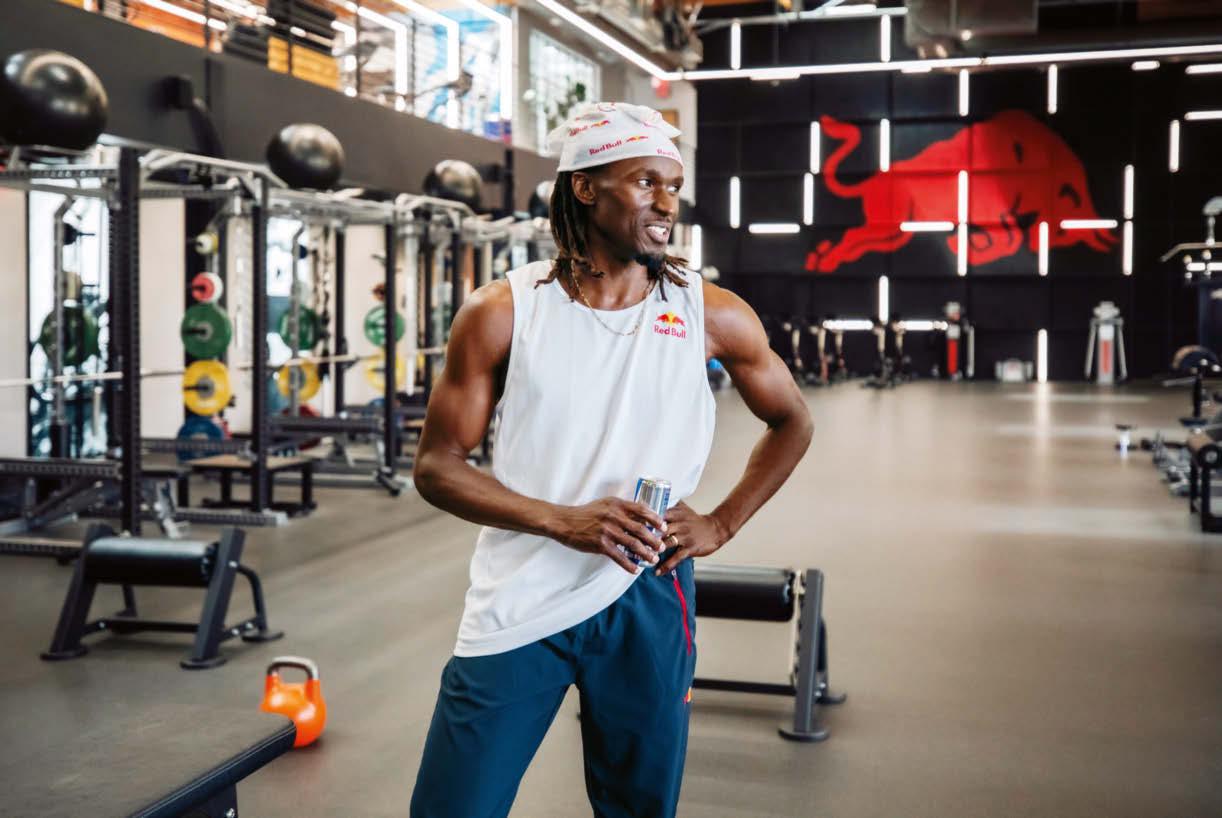
POWER & GLORY
A PRO 32 THE RED BULLETIN
TRAIN LIKE

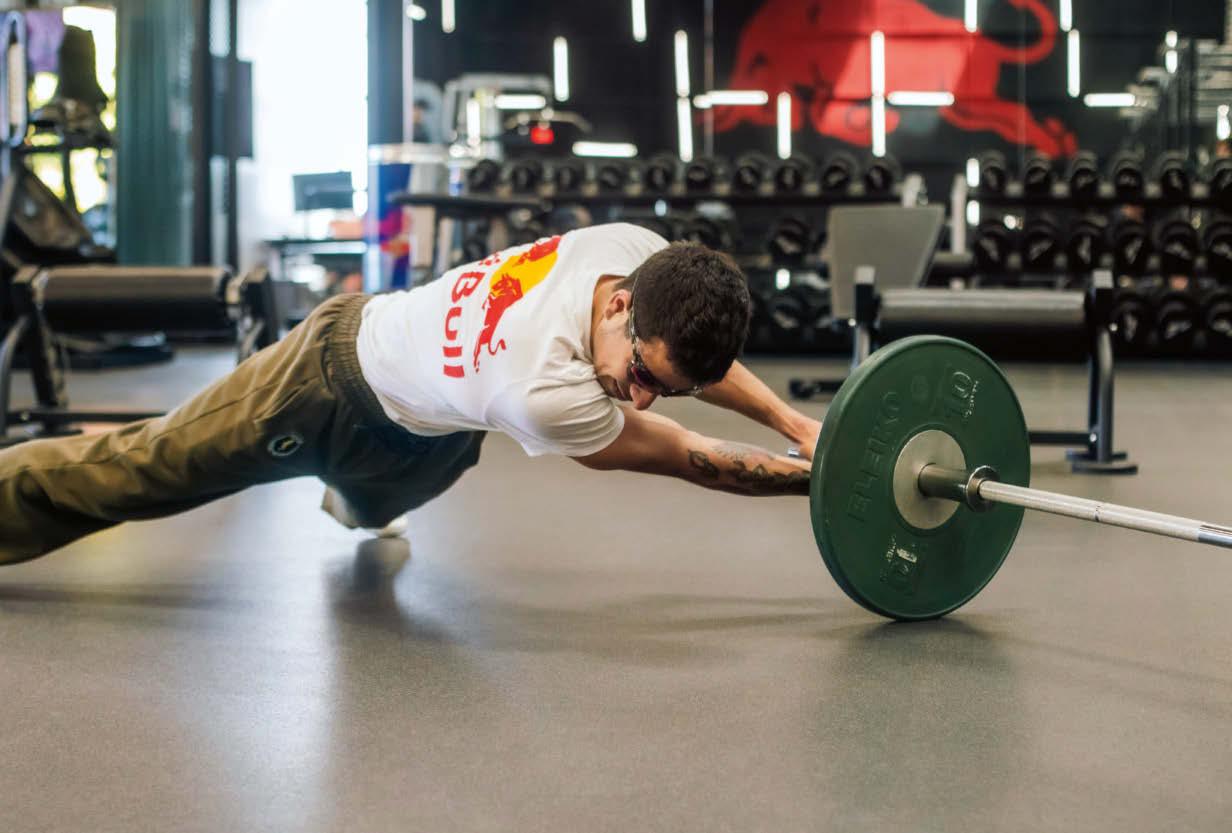
It’s not every day that a professional breaker starts performing moves in the APC.
“That guy is amazing,” says Claye, taking a break from lunges executed with surgical precision.

LIFE OF THE PARTY
With dusk heralding a picture-perfect Saturday night on the first weekend of Coachella, Blxst performs before a massive crowd. More than 200,000 fans attended the festival that weekend, and a decent chunk of them were partying on the lawn facing the Outdoor Theater to see the L.A.-based artist and his band crank out a euphorically soulful set and share the stage with Feid for an energetic performance of Blxst’s newest single, “Rewind.”
Blxst, who admits this was surely the largest audience he’s ever performed for, says now that seeing a photograph of this set gives him chills. “Thinking back on this moment, it felt like an endless crowd out there,” he recounts. “As far as I could see, people were dancing. It was like I connected with every person out there to some degree. Even if you didn’t know who Blxst was, the music alone probably made you move.”
POWER & GLORY In the Moment
34 THE RED BULLETIN
Getty Images
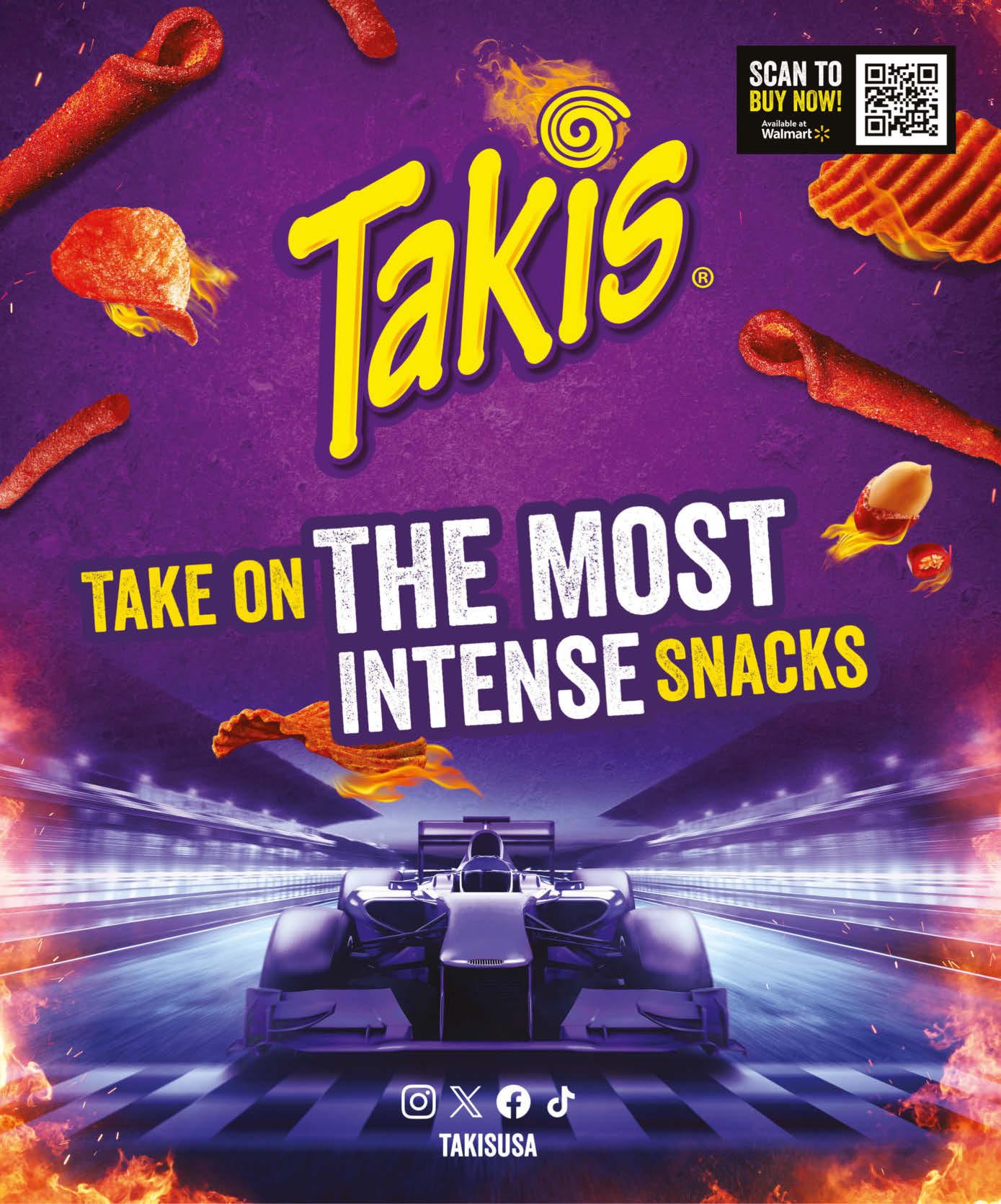

POWER & GLORY
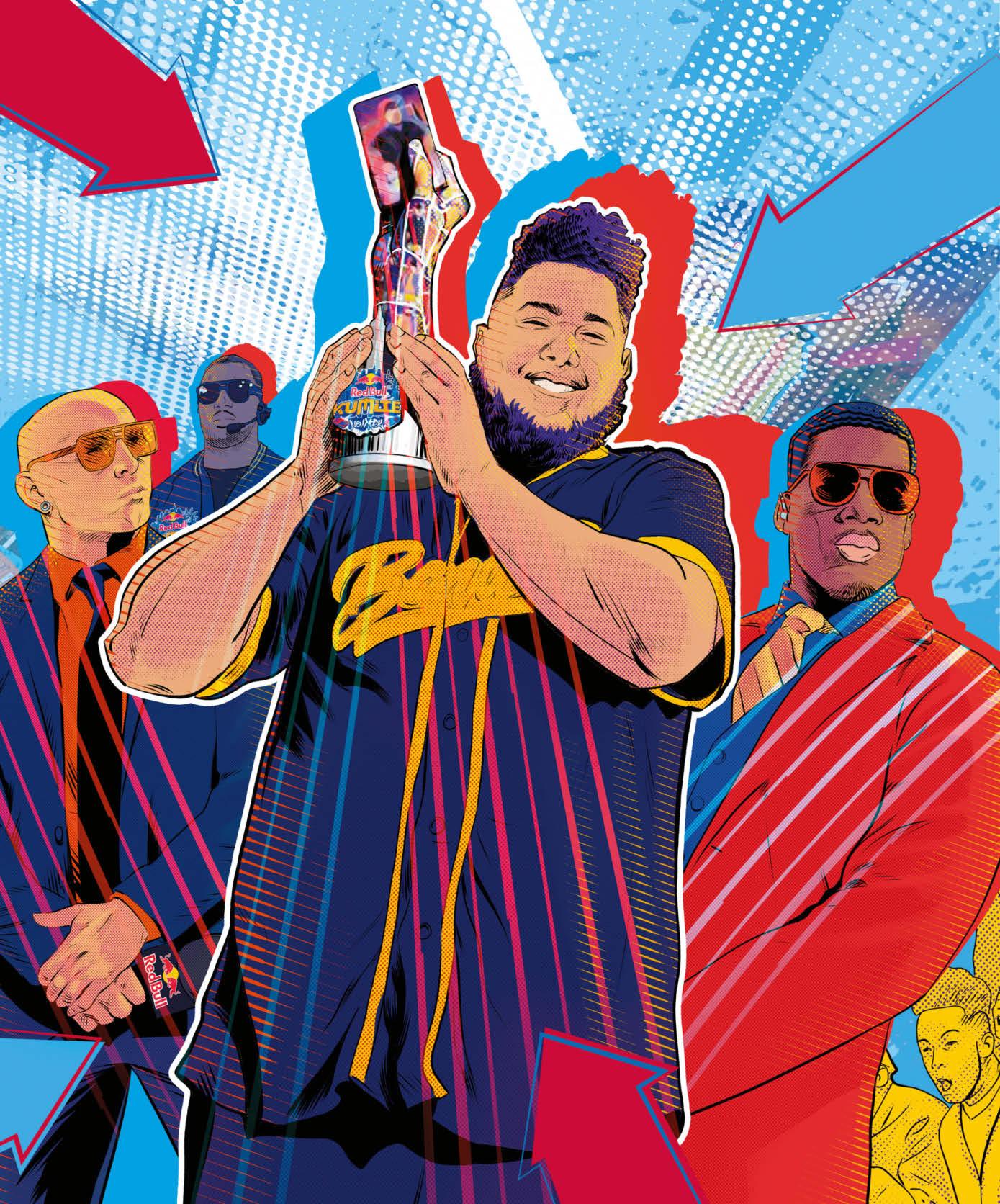
MENARD IS EXTREMELY GOOD AT STREET FIGHTER, BUT HE’S EVEN BETTER AT WINNING HEARTS.
WORDS
BY
TIMOTHY LEE ILLUSTRATIONS
BY
DAVID GROUSSET
MENARD THE RED BULLETIN 37
Before the final knockout finishes playing on the screen, he jolts up from his seat and stretches out his arms in an embrace to the crowd.
His eyes scan the audience for a familiar face and then he’s smothered by the excitement of his friends, who drape him with the Dominican Republic flag. The simultaneous chants of “Mena” meld with the roar of thunder sticks as the champion shakes hands with all the fans who came to a warehouse in Greenpoint to watch him play—and win. On this day, New York City, which has the largest Dominican community in the U.S, feels like a second home.
His name is Saul “MenaRD” Mena, and for the 24-year-old Street Fighter player and two-time Capcom Cup champion, winning Red Bull Kumite in New York isn’t just another competition to take down—it’s his way to repay the people who’ve supported him, by dominating the field and representing his country.
MenaRD doesn’t know about 85 percent of the crowd shouting his name, but he knows that if you do things right as a role model, all the DR will have your back like family. His influence goes beyond playing Street Fighter because he represents success through work, persistence and faith.
“I don’t know if he knows the impact he has on Dominicans,” says Michael “Yipes” Mendoza, one of the commentators for Red Bull Kumite and a New Yorker of Dominican descent. Mendoza is also a former Evolution Championship Series winner—
MenaRD, pictured here in New York ahead of Red Bull Kumite, is the only two-time Capcom Cup champion in the competition’s history.
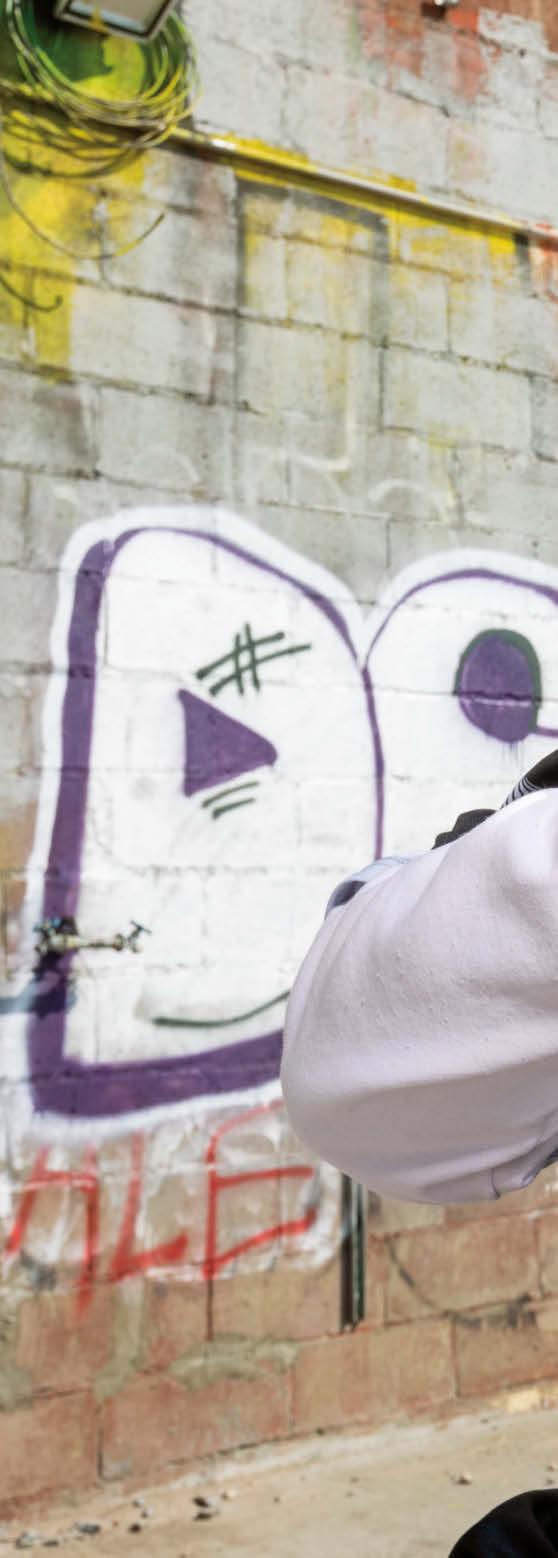
POWER & GLORY
38 THE RED BULLETIN
Daniel Weiss / Red Bull Content Pool
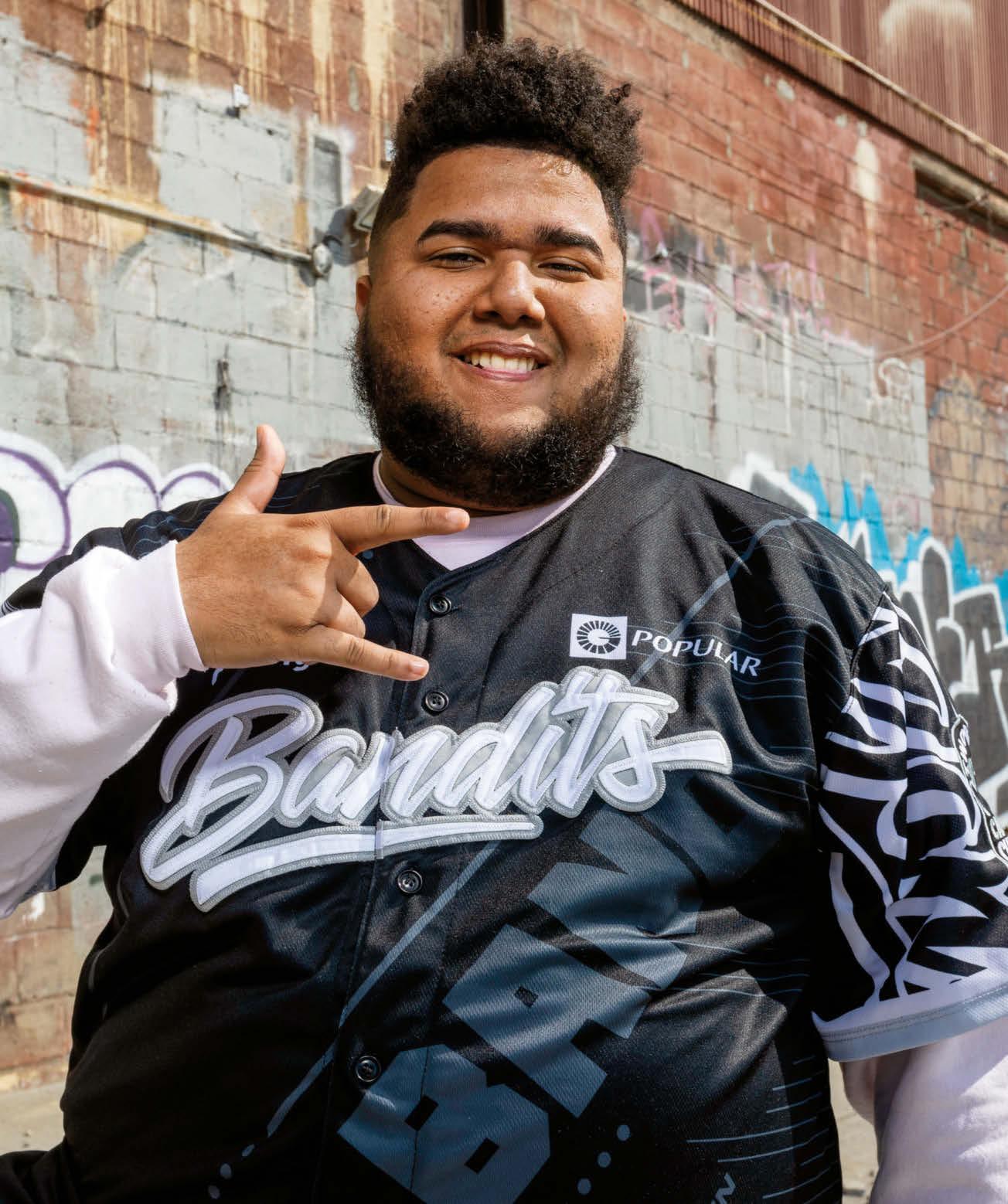
MENARD
“MENA IS THE FIGHTING GAME AMBASSADOR, SO WE CALL HIM THE PRESIDENT OF THE DR. THEY GOT A KID THEY CAN CHAMPION.”
arguably the most prestigious fighting game tournament ever—but on that particular day in March, he’s simply a proud fan of his fellow countryman.
“All our beautiful people were there to watch him play—friends of friends and people that didn’t know fighting games, were there to support,” Mendoza continues. “Mena is the fighting game ambassador, so we call him the president of the Dominican Republic (DR). They got a kid that they can champion.”
Today, MenaRD is an unstoppable force on the Street Fighter scene, but his path to victory didn’t come without a few obstacles. “It took so many things to go right to have the privilege to have this blessing,” Mena says. “I’m just grateful.”
Growing up in Santo Domingo, Mena lived in a neighborhood heavily affected by crime. In school, he had friends who dropped out because they were caught up in something. His parents shielded him and made sacrifices to provide for him as best they could. Playing fighting games alongside his older brother and his friends became his haven. Sometimes they’d lose electricity, a common occurrence in the DR. Still, Mena’s talent was clear from an early age. As the dream to pursue gaming began to grow, it took a village to make it possible.
The Dominican Republic has one of the weakest passports in the world, meaning its citizens need a business or work visa to travel to many countries, including the U.S. When Mena was 15, his small gaming community sponsored him to attend his first tournament. Then, at the 2016 Fighting Fest in Santo Domingo and the 2017 Northeast Championships in Pennsylvania, he placed second.
Those early successes gave Mena the confidence to keep going, but his parents expressed their hesitation, hoping he’d attend college instead. In that moment, he took a leap of faith and chose gaming.
“I was upset because I thought they didn’t understand what I was trying to do,” Mena explains. “But they still supported me. Every time I left the
country, they needed to sign documents and pay a fee to let me travel, and they did it every time regardless of what they would say. I’m thankful for my parents for guiding me.”
When Mena won his first Capcom Cup in 2017, he officially put his country on the map in the fighting game scene. (“I cried when I saw him win,” Mendoza admits.) With his $250,000 in prize money, Mena invested in his local gaming community by sponsoring other Dominican players, forming his own team and upgrading their gaming facilities with monitors, consoles, faster internet and a bigger space.
Over the years, Mena traveled and trained with his best friend, Cristopher “Caba” Rodriguez, who is like a brother to him. Their relationship rapidly matured as they grew into a commanding force in their field, but nothing was guaranteed. For Caba, his life forever changed when his father, who raised him, passed away in 2021. Caba played through his grief at a world-class level in part thanks to the support of his best friend, who helped him build an independent lifestyle.
In December 2022, Mena moved to Boston, where his mother had established residency, but he maintains a strong bond with Caba. “He’s the most special case of a brotherhood to me,” Mena says of his friend. “If we stopped playing right now, I would be there for him for the rest of his life. We became each other’s strengths and grew together, and it happened because of Street Fighter and because of the community.”
A few months after moving to the U.S., Mena won his second Capcom Cup in Los Angeles, becoming the only two-time champion in the competition’s history.
Today, Mena and Caba are considered favorites to take down any competition, but when Street Fighter VI released in June 2023, Mena struggled with the game. After his monumental success in competition with Street Fighter V, the newest iteration of the iconic series arrived as a complete overhaul. For Mena, something wasn’t clicking in the game’s mechanics and design, and he contemplated quitting before things became
POWER & GLORY
In Brooklyn, fans rooted for Mena at Red Bull Kumite 2024 by waving Dominican Republic fags, banging thunder sticks and screaming his name.
40 THE RED BULLETIN
/
Todd Owyoung
Red Bull Content Pool
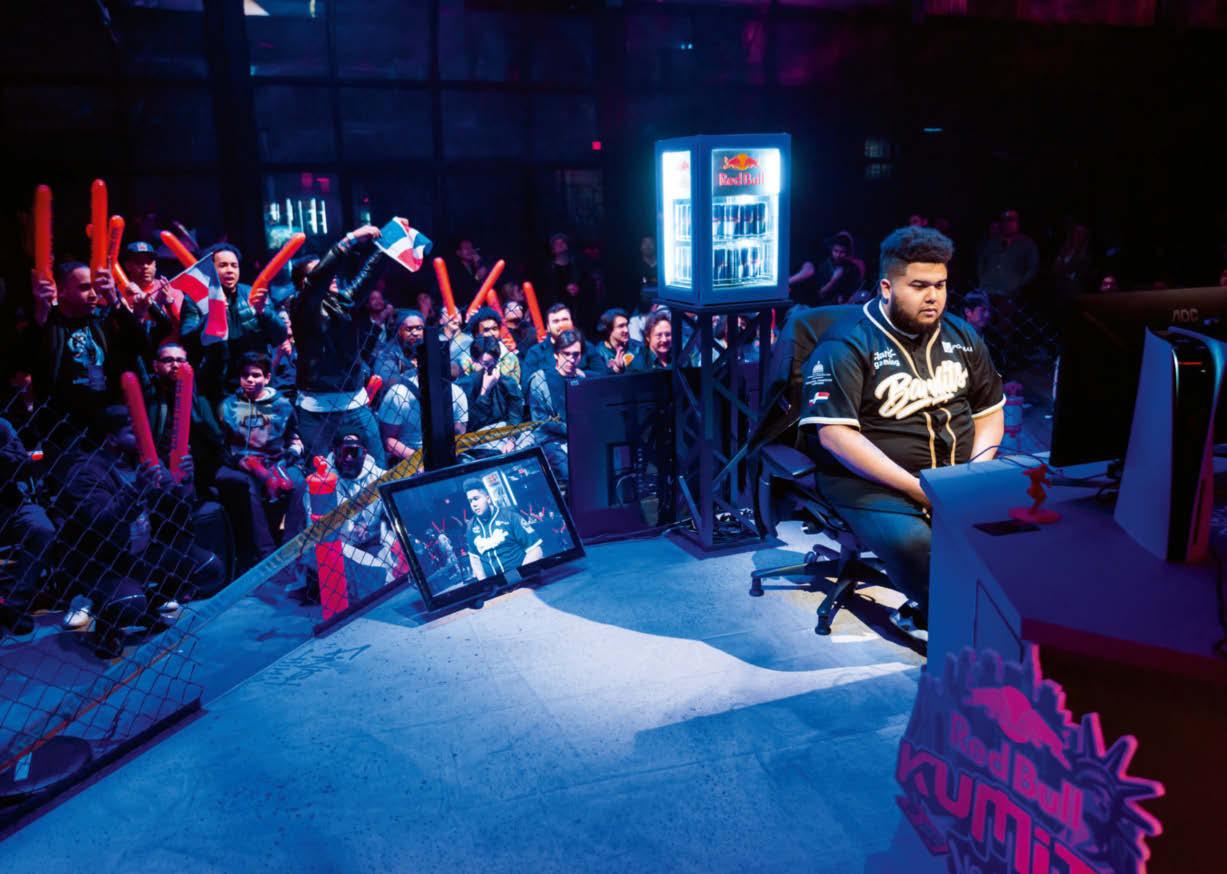

MENARD

POWER & GLORY
too frustrating. But he didn’t just struggle with results. At the time, he mentally lacked focus and the motivation to play, which didn’t sit well with his team, so he decided to figure out the root of the problem.
The simple answer was he lacked drive. With the help of sports therapist Ruben Aybar, Mena discovered his motivation had dwindled. After becoming the only player in history to win two Capcom Cups, what more did he have to prove? He needed to believe again.
Therapy allowed him to see the mental hurdles and pressures he’d inflicted on himself, and as a result, he changed his overall approach to professional gaming.
Now he had the tools to just breathe and be aware of factors that affect his mood in competition—things like crowd noise or even the temperature of the room. Putting a name to everything allowed Mena to create solutions, and that empowerment reinvigorated his drive to succeed.
“Therapy was not my decision,” Mena admits. “When the pandemic happened, my mom and my brother got COVID, and it was dangerously close. I was losing my mind.”
In therapy, he realized he needed to focus on what he could control. “If how I played took me to victory, that’s good, but it doesn’t mean I should be satisfied or that it was guaranteed,” Mena explains. “Just do your best with what you have and that’s all you can do.”
Ultimately, Mena credits everyone in his support system for giving him a sense of stability. “I was putting a lot of pressure on myself,” he says. “My team saw that and helped me become the best version of myself.”
These days, MenaRD is arguably one of the best Street Fighter VI players in the world. He influences strategy and trends for character selection in tournament play. Because he plays two main characters, Luke and Blanka, at an absurd level—and both characters are interchangeable—top competitors are now taking a second look at Blanka’s potential. And while there are plenty of tapes to study for his habits and decisionmaking, no one can really predict or counter the nature of MenaRD’s play. For years, Japan heavily influenced the ebbs and flows of the Street Fighter scene, but today, the Dominican Republic is leading the way, with Mena at the forefront.
“The game’s options and mechanics allow the player to condition the opponent better,” Mena says of Street Fighter VI. “I can deal with a lot of the chaos, and all the things you need to counter or react are all risk and
At Red Bull Kumite, which featured some of the best Street Fighter VI players in the world, Mena dominated the fnal bracket of competition.
rewards that benefit my intuition. If I don’t know [my opponent] is going to do something, raw reaction won’t help, but if I know what you’re trying to do, I can stop it. Because I can confuse and condition people, I can play around people’s reactions and prevent them from stopping me more.”
Mena’s ability to outpace other players makes him the most dangerous player to go up against in competition. “When it’s a setting where you play sets, my money is on that guy,” says Mendoza. “He’s young and super consistent, and every victory he gains, he just proves he’s real and pushes the culture forward. You can tell when someone isn’t here for the right reasons, and I never get the impression from Mena’s body language. He’s there to showcase what the fighting game community is about, win or lose.”
Although he’s in a good place now, Mena admits that first year playing Street Fighter VI was extremely difficult—the travel, the long training hours, the lack of motivation. He had to remind himself that what he was doing wasn’t a gimmick or an illusion. His recent wins at Red Bull Kumite and EVO Japan 2024—the latter of which happened as this issue went to press— affirm he’s the real deal.
“Seeing a kid that’s inspiring the culture, I’m so proud of him,” Mendoza says. “He’s the classic case of what the fighting game player represents—he won’t complain and moves on even in tough losses. He’s the embodiment of the perfect player. What I love about Mena is that he never changes as a person. Everyone that roots for him sees a piece of themselves in Mena.”
At the end of the season, with the most important people in his life around him, Mena is feeling good again. “When I see my family at a competition, I’m just grateful,” he says. “It doesn’t matter how I do, my mother and family will never take it for granted. I’m doing what I love all the time. It’s the best life I can imagine. It makes me play without pressure. I’ve already won, and I need to enjoy the moment.”
“HE IS THE EMBODIMENT OF A PERFECT PLAYER. EVERYONE SEES A PIECE OF THEMSELVES IN MENA.”
MENARD
THE RED BULLETIN 43
MOTION
ARTINMOTIONA NARTINMOTIONA INMOTIONARTINMOTIONRTINMOTION INNARTINMOTION AMOTION
ARTINMOT
INMOT
RT
A
ION 2024 ISSUE 2 THE RED BULLETIN QUARTERLY 46 Caitlin Simmers 56 Portfolio: Ted Grambeau 64 Carissa Moore 68 Jagger Eaton 78 Phil Wizard Leaning into the intersection of selfexpression and sports THE RED BULLETIN 45
MOTION ION MOTION
A ION
At 18, Caitlin Simmers has risen to surfing stardom with dizzying speed—and she’s doing it with a style that’s all her own.
Calm in the Chaos
WORDS BY JEN SEE
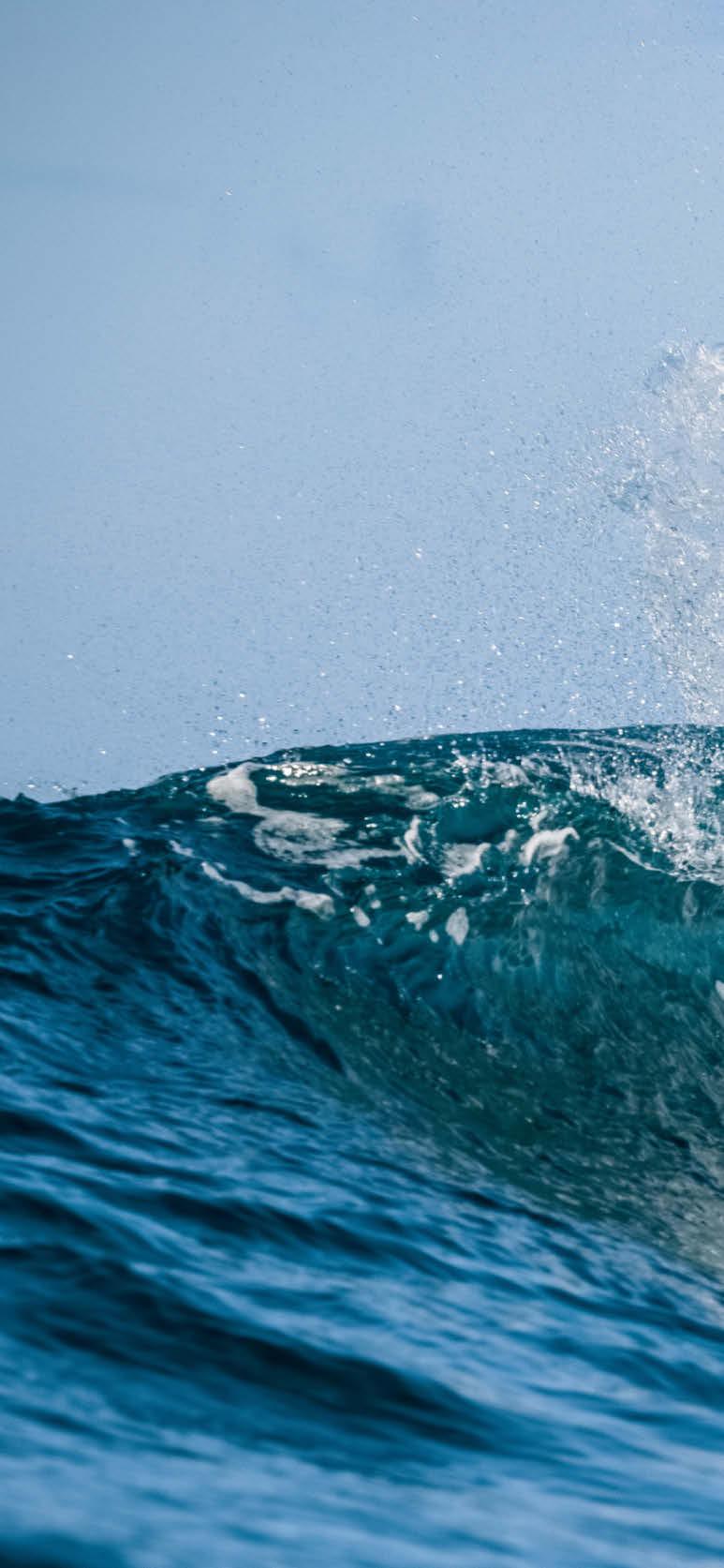
ART IN MOTION 46 THE RED BULLETIN
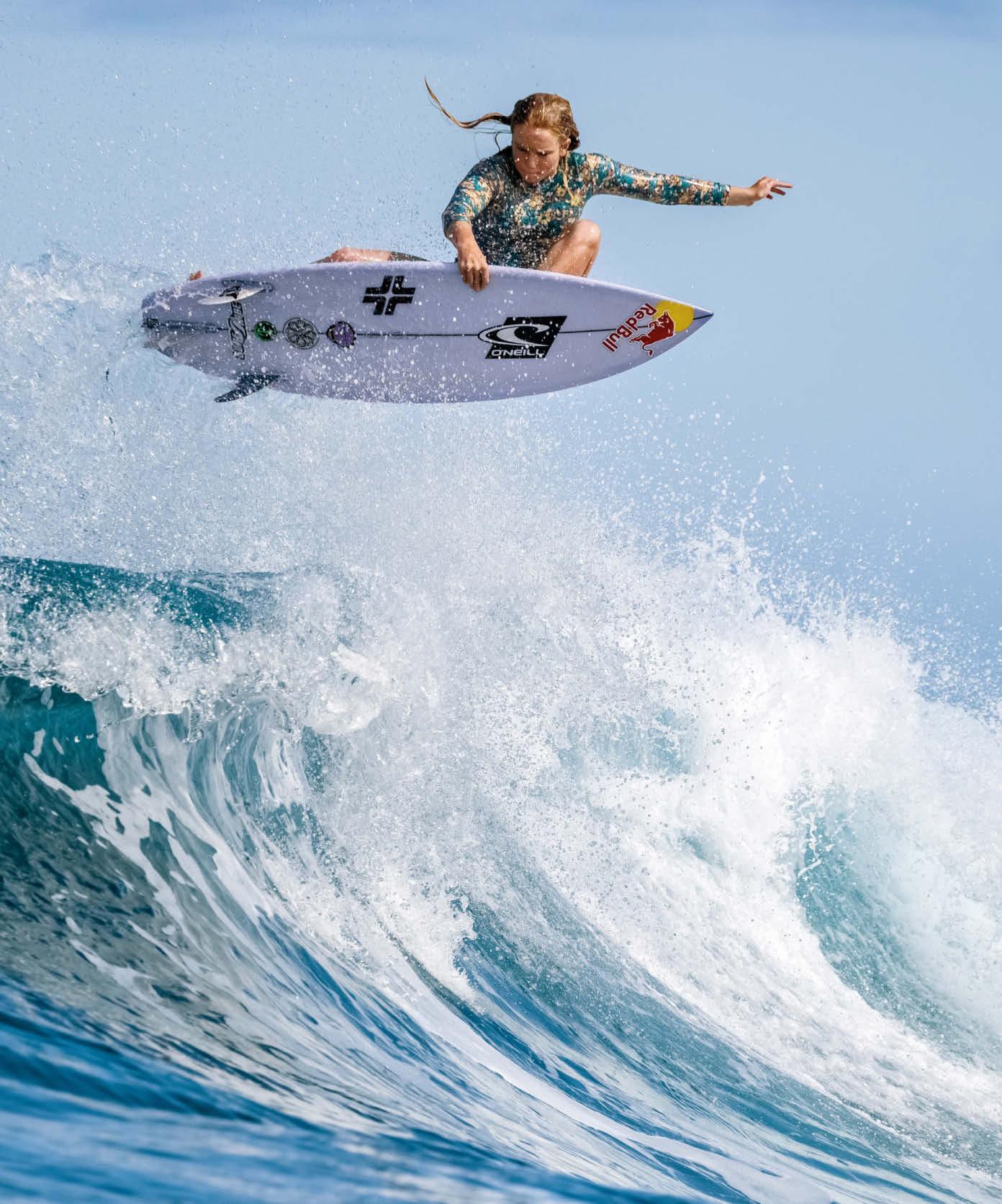
CAITLIN SIMMERS Domenic Mosqueira/Red Bull Content Pool
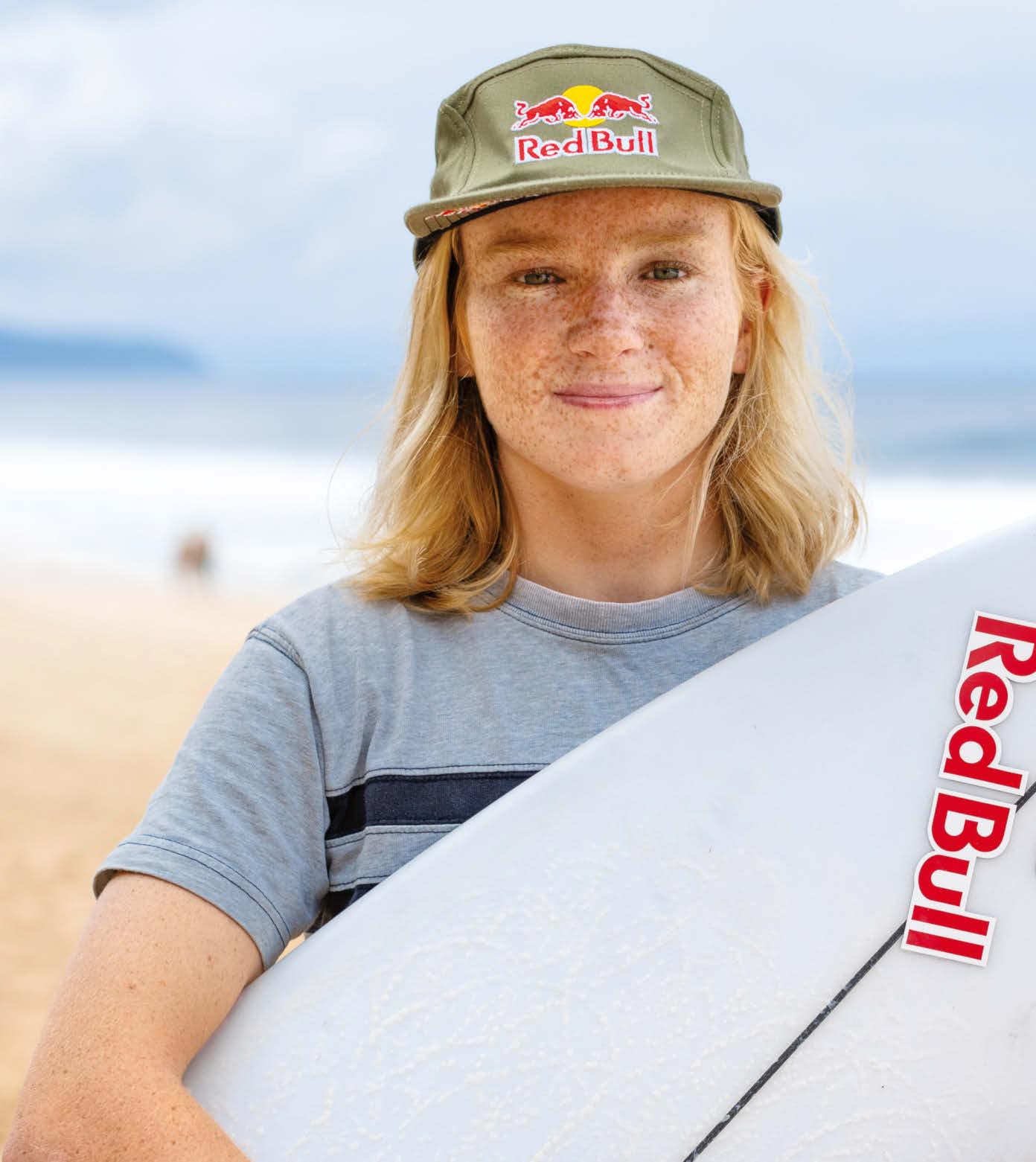
ART IN MOTION
“I really just have to do what works for me,” says Simmers, who knows she has plenty to fgure out—and lots of time to do so.

There’s an image of Caitlin Simmers sliding through a dark-blue cavern at Teahupo’o in Tahiti. The wave towers over her with a face that’s easily 8 feet tall, maybe more. She looks perfectly poised. She folds her 5-foot-3-inch body over the thin fiberglass of her board and grasps her outside rail as she holds a precarious balance against the ocean’s force. Simmers looks at home there, slipping through a dream, deep in the embrace of one of the world’s most dangerous waves. She is where she’s meant to be. And she hopes to be right back there, gliding through that mesmerizing tube when the very best surfers return to Tahiti this summer with the whole world watching.
Growing up in Oceanside, California, Simmers never expected to become one of the best surfers in the world. She spent weekends playing in the waves at the end of Cassidy Street and ate tacos at Primos. She imagined becoming a professional boogie boarder. She tried BMX, hip-hop dancing and skateboarding, but her family gravitated to the beach. Her father, Jesse, surfs, and soon Simmers learned. Eventually, a friend suggested she sign up for a contest. Simmers only made one heat that day, but it didn’t matter. The lure of competition hooked her.
Since that first contest, Simmers has made a stunning ascent through surfing’s ranks and developed a dynamic, expressive style. At 15, she won the prestigious U.S. Open of Surfing at Huntington Beach. By the end of the year, she had become one of the youngest surfers ever to qualify for the Championship Tour, which is surfing’s highest level of competition. After delaying her Tour debut for a year, Simmers won two events and finished an impressive fourth in the world in 2023. She also found time to release a creative video edit that she called Bell Jar.
Then in February came her biggest accomplishment yet when Simmers opened her 2024 season with a win at Pipeline. On what’s widely considered to have been one of the best-ever days of women’s contest surfing, Simmers beat hard-charging Australian Molly Picklum in a hotly contested final. Her defiant and triumphant cry—“Pipeline’s for the f*cking girls”—ricocheted around the internet. Women had only competed at the fearsome North Shore wave for three years. Simmers made it clear that they were there to stay.
When The Red Bulletin caught up with Simmers late in April 2024, she stood at the top of the world rankings. She spoke candidly about both the challenges and joys of competing, about the fear that waves like Pipeline and Teahupo’o inspire, and about how she came to name a surf video after a Sylvia Plath novel. Simmers is creative, funny and thoughtful by turns. For her, surfing is more than contest heats and more than world rankings. Surfing is art and selfexpression, and Simmers is determined to carve out her own path, one wave at a time.
CAITLIN SIMMERS
THE RED BULLETIN 49 Christa Funk
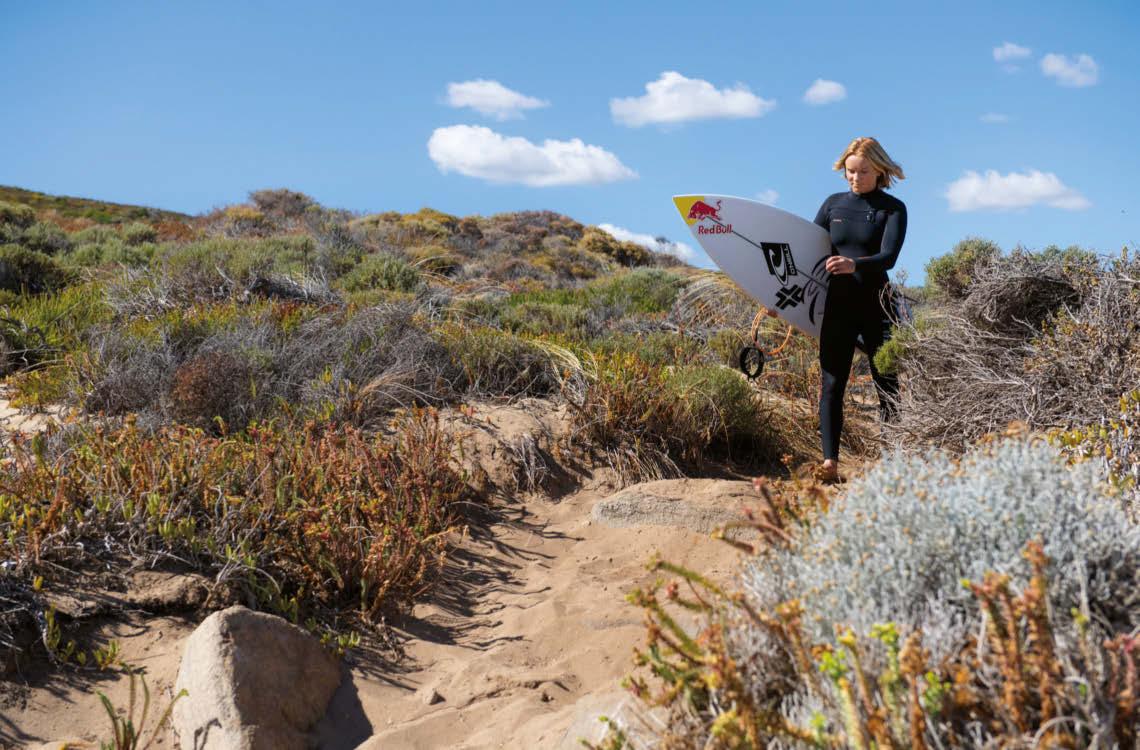
“It’s hard for me to surf big waves because I’m small. But I know I can do it.”

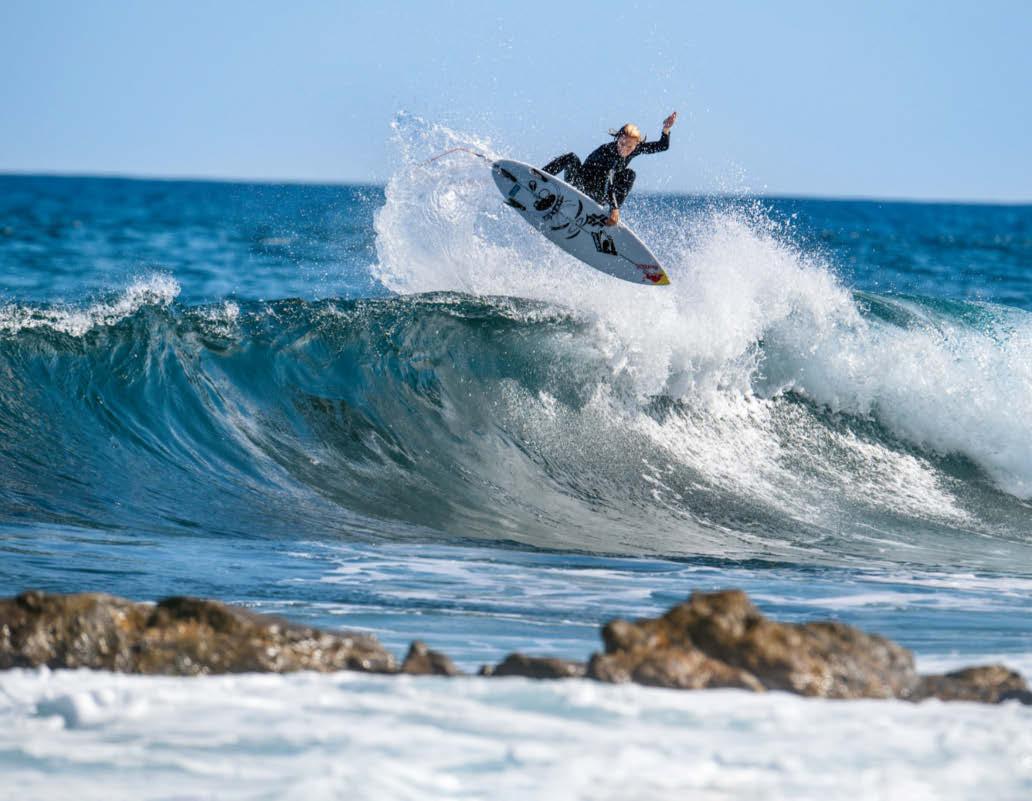
ART IN MOTION
50 THE RED BULLETIN
Simmers, pictured on this spread in Australia in April, won two of the frst fve WSL events of 2024 to sit No. 1 in the world.
For Simmers, surfing is art and self-expression.
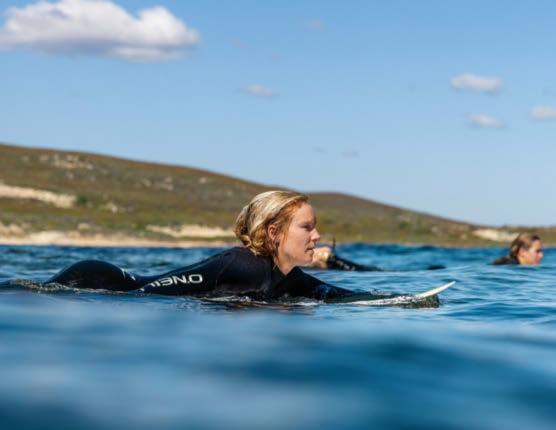

THE RED BULLETIN: What are your first memories of surfing?
CAITLIN SIMMERS: My dad, Jesse, and my mom, Ali, loved the beach when my brother and I were kids. Just thinking about the sand, the itchiness of the sand, and the coldness of the water, we weren’t that into it. They would have to bribe us. “You get a Slurpee if you come to the beach.” I would boogie board with my brother Timo and that’s the first memories I have of riding waves. My dad surfs, so my brother and I started surfing. Then my mom started when I did. We would all go as a family on weekends. We all loved it.
Your parents both have full-time jobs. Your dad’s an electrician, and your mom’s a hospice nurse, which are both demanding jobs. Have their experiences influenced you?
I think knowing that my dad’s had to work all day every day gives me perspective about what I do and how lucky I am to be where I am. I know what I have. And my mom is one of the wisest people I know. She’s amazing. I’m really grateful for my parents. They’re super hands-off about my career. Obviously, they’re proud of me, but they’re never going to try to push. I feel like honestly, if they tried to force me into being this girl surfer or for me to do anything, really, I would not want to do it. In fact, I’d probably do the opposite.
So you’re a bit stubborn, then?
It would be hard to find a professional athlete who’s not stubborn. I was playing chess last night, because I’m super into the show Queen’s Gambit. It was the first time I’ve ever played, and I was so overthinking it and freaking out. I wanted to win, but I lost every time. I was so bummed and I was like, “Why do I even care about losing this game?” It’s literally because I’m so competitive. I definitely realize how much I want to win, even if it’s stupid board games. To a certain extent, the only reason that I’m where I am is because I’m so stupidly stubborn.
Did that competitiveness draw you to contest surfing?
My friend was like, “You should do a competition,” so I did. In the first one, I didn’t even get close to winning the whole comp. But I was so pumped on it. I just got addicted to that feeling. If I can do this thing I love and beat other people, then that’s the best thing ever.
What’s it like if you and Timo are in the lineup together?
It’s a little more mellow now. We’d always just have a good time, and sometimes we’d fight if one person burned the other. Mostly, I feel like we’ve always just been at each other’s throats in the best way possible. I would see him doing something good and I would just want to do it better. We push each other.
Growing up skating and surfing, you watched a lot of videos. What did you have on repeat that you feel has influenced you?
When I first started getting super inspired by surf video clips, I was watching Dane Reynolds. I watched a lot of his videos for a long time. Then in the last couple years, I got really into skate and snowboard videos as well. My favorite snowboard video is Evergreen, and I really like what Frog Skateboards does. I love how they make it look like they’re just doing it simply to enjoy themselves and making lighthearted videos.
How did you come up with the name “Toasted” for your video projects?
It’s honestly the dumbest name ever for anything! I wanted something with different meanings. It could mean you’re tired or sunburned. Or you’re toasting to something, like a celebration. It could mean you’re toasting a piece of bread. I didn’t want it to be serious. If you sit around and you think too hard about it, you’ll come up with something that doesn’t have any life.
You’ve already put out a couple of sick edits. What are you psyched to do with Toasted?
The idea is for it to be an outlet for videos I make. I didn’t want it to be just under my name, because I want to include other people. I enjoy my brother’s surfing, and I like putting him in my videos. He’s so creative and helps me come up with ideas. I want to start putting more up-and-coming girls in my videos.
CAITLIN SIMMERS
THE RED BULLETIN 51 Ryan Miller
ART IN MOTION
“To a certain extent, the only reason that I’m where I am is because I’m so stupidly stubborn,” says Simmers.
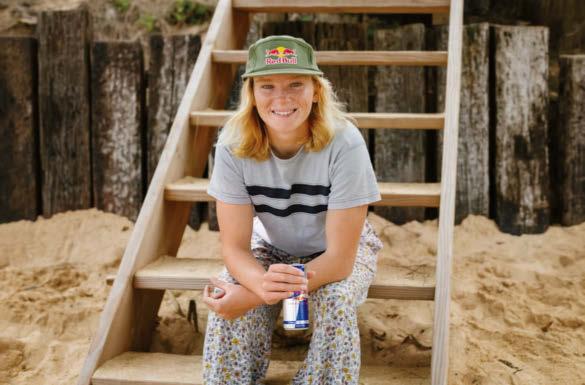
You always seem to find the perfect music for your edits. How do you find the music and put the edits together?
The most fun part of editing is figuring out what type of music works best with the surfing. I’m always listening to different kinds of music. I’ve been into older country music by women singers lately. I put aside songs I think will be good for edits. Sometimes, it’s a song I really like. Sometimes it’s a song that’s super weird, but I think it might work for surfing.
You have to be the only pro surfer ever to name an edit after a Sylvia Plath novel, The Bell Jar. What’s the story behind that choice?
I was reading Sylvia Plath and I really like her. The book is pretty dark but it’s also beautiful. My friend Coral who I work with loved it, too. We were sitting at this desk and the book was there. We were just like, oh, it sounds cool, The Bell Jar. And it has meaning to us, because we both loved the book. We loved these quotes, like “I felt wise and cynical as all hell.”
At the end of the edit, you have that beautiful, massive barrel at Teahupo’o. What do you remember about that wave?
I don’t really remember the actual wave. It sucks, but I’ve talked to a couple of other surfers about it, and it’s
Simmers is determined to carve out her own path.
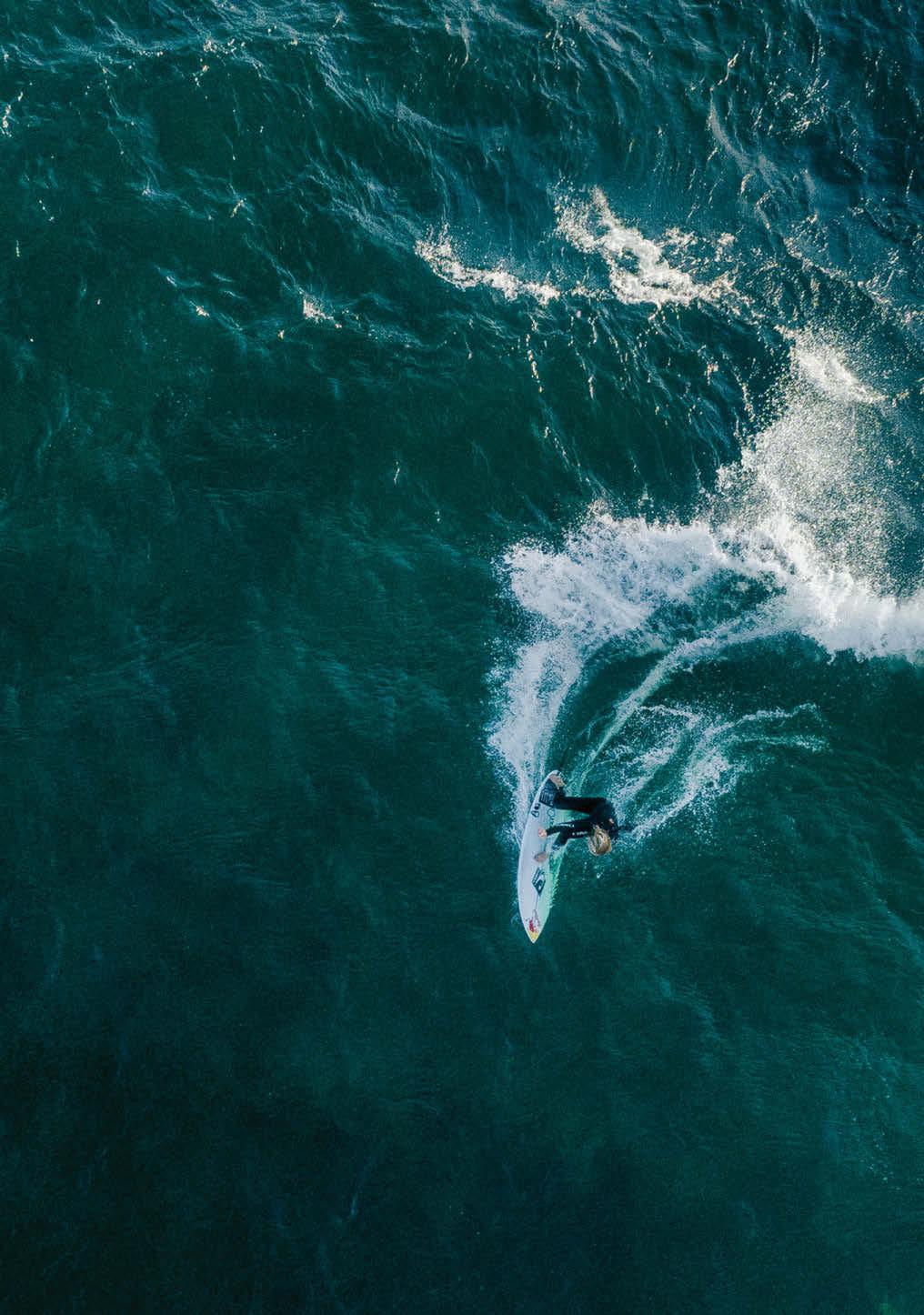
52 THE RED BULLETIN

“Competitive surfing is such an individual sport, so I don’t really get many team experiences.”
CAITLIN SIMMERS THE RED BULLETIN 53 Ryan Miller, Christa Funk/Red Bull Content Pool
“You can go into a heat with a strategy, but the ocean ultimately decides your strategy.”
like your mind just blacks out. I had been out for like five hours and I was paddling back to the boat when this wave came that swung pretty wide. Everyone was screaming at me to go. It was like, “Well, I guess I have to go.” I remember dropping in. Then I remember knowing that it was the best wave of my life as of that moment. I also got pounded by two waves after it. It was pretty brutal.
Is that the only wave you rode that day?
I got a bunch of waves, but I fell on all of them. I was out there for something like five hours and I didn’t make a wave, so it was pretty fricking amazing when I made that one. I was falling, because I was just trying to wrap my head around the wave. It’s one of the most perfect waves in the world in that sense that it breaks in the same place every time. You’d think it would be easier to surf, but it’s not, at least for me. The way it bends and the speed it comes at you—there’s a lot of factors. I felt like I had to forget everything I’ve ever learned.
How would you characterize your relationship with Teahupo’o at this point?
We have a good relationship, I think. We’ve had some ups and downs. I’ve hit the reef pretty bad there. One of my worst reef scrapes ever was there. I hit the reef so hard that I couldn’t even feel my legs. I was in shock, and it was crazy. But I also got the wave of my life there. It’s one of the most powerful, crazy, scary, picture-perfect waves ever. I don’t know if it thinks I’m beautiful, but I think it’s beautiful.
What do you find especially challenging about competing?
There’s just so many things to think about. You have to figure out how to beat the other person. You’re also competing against the ocean. You can go into a heat with a strategy, but the ocean ultimately decides your strategy. You can have this plan, like I’ll wait for the good wave, and then the good wave never comes. It’s so weird to try to fit surfing—this artistic wave-riding thing—into this criteria where somehow you have to try to get a score.
How did it feel to win at Pipeline earlier this year?
Pipeline is a dangerous, scary wave, and just thinking about it makes my heart race faster. I’m super scared of big waves, but I obviously love surfing big waves, too. It draws so much emotion out of me. Before the event, I was worried that they were going to run it when it was super big. Pipe’s one of the best waves in the world and the most dangerous. It’s always been a goal to win there. It was pretty amazing.
How important is it for women’s surfing to have an event at Pipeline?
I think it’s super important to throw the girls out there and force them to do it for the sake of pushing the sport. It’s pretty easy to be like, yeah, I’m just not going to surf Pipe. But if there’s an event there, it’s like, well, shit, if I want to do good at this contest I have to surf here. I would probably still surf Pipe even if there wasn’t an event there, but I’m surfing it way
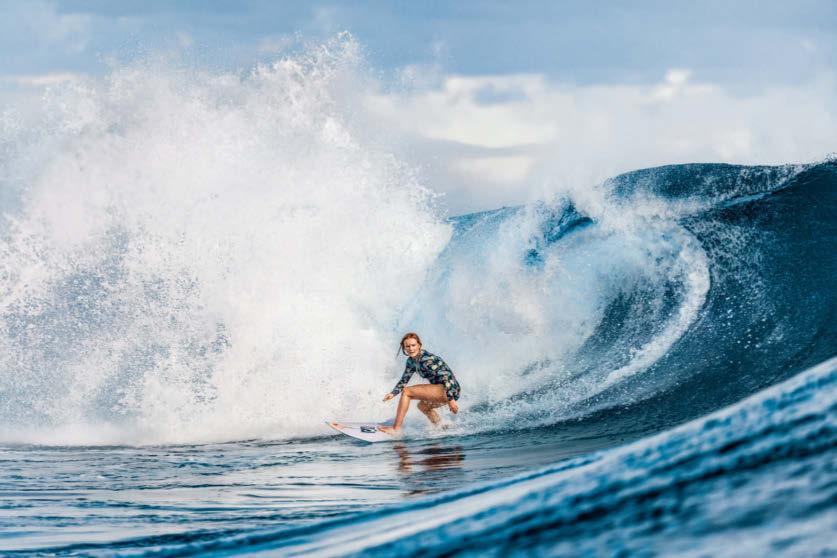
ART IN MOTION
54 THE RED BULLETIN
Simmers catches a ride on a mellower day at Teahupo’o. The Tahitian break will be on everyone’s mind this summer.
“I’m looking forward to being part of a team.”
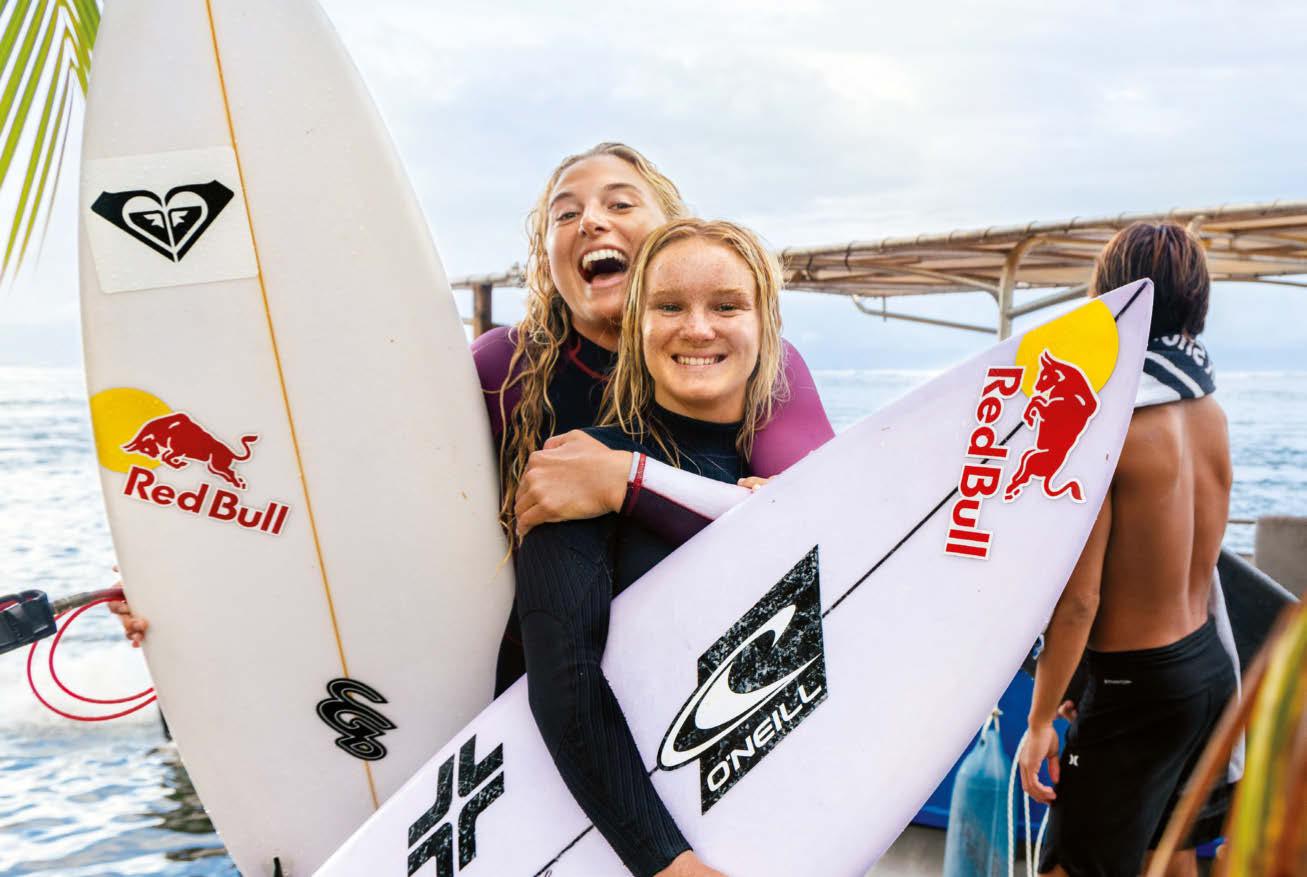
more and trying to learn about it and study it. It definitely pushes me. It’s been super amazing to see the number of girls out there multiply each year.
What’s something you’re looking forward to experiencing this summer?
The main thing that I’m looking forward to is being part of a team. Competitive surfing is such an individual sport, so I don’t really get many team experiences. But those team experiences I’ve gotten with the ISA World Surfing Games, it’s the best part about it, for sure. I get to cheer on other people and it’s great. I think I’m so aware of how selfish surfing is, and I really don’t like that part about it.
Is there anything you’d like to improve as a contest surfer?
I want to improve in bigger waves. I grew up in Oceanside, where every day the waves are like one foot. So when I go to places like Hawaii I feel so out of
my comfort zone. It’s also super hard for me to surf bigger waves, because I’m so small. But I know I can do it. I want to figure that one out.
What do you feel like you’ve learned in your career so far?
I’m always in different places and different surroundings. I’m forced to be around all these different people and I’m always in a different place at a different time, a different bed, different sheets, a different pillow. So my mind’s always just like, “What are you even doing to yourself?” I guess I’ve learned to try to find consistency in my life, even when there’s none of it there. And maybe a simpler thing I’ve learned is how much I appreciate home. It’s so easy to overthink things. There are a lot of people trying to tell me what works and how to succeed. I can try those things, but I really just have to do what works for me. There’s no cookie-cutter way to succeed. I feel like at my age, I still have so many different things that I have to figure out.
CAITLIN SIMMERS
Simmers enjoys a lighter moment with fellow pro and SoCal talent, Izzi Gomez.
THE RED BULLETIN 55 Domenic Mosqueira
ART IN MOTION

It’s every surfer’s nightmare: not being able to make it over the crest of a wave. Thankfully, Peruvian surfer Rodrigo Reinoso came out of his ocean tumble with only minor cuts and bruises in 2022. “This shot makes the hair on the back of surfers’ necks stand up,” says Grambeau. “A wave that takes you backwards into the whitewater is always terrifying. And this is like a normal wave on steroids.”
56 THE RED BULLETIN

TED GRAMBEAU
The Australian photographer captures the beauty—and the beast—that is Teahupo’o, the iconic surf spot in Tahiti that’s in the spotlight this summer.
Portfolio
GRAMBEAU
WORDS BY RUTH MCLEOD AND NORA O’DONNELL TED
ART IN MOTION
Despite suffering from seasickness, Australian surf photographer Ted Grambeau has spent a lot of his career aboard boats in some of the world’s biggest swells. And, after 40 years in the game, he’s a master of his craft— meaning his incredible images capture the spirit of surfng, the power of the ocean, the drama inherent in the pursuit of catching the perfect wave. “I do whatever it takes to get the best shot,” he says. “When I’m swimming, I’m literally in the impact zone of the waves, inches away from the surfers. It’s
thrilling, but with the biggest waves, I’m more productive on a jet ski or in a boat. These surfers are searching for the ultimate limit in terms of them versus wave. And, like them, I’m constantly looking for ways to show things in a different way and push the limits.”
Perhaps one of the best places to push those limits is in Tahiti. On the French Polynesian island’s southwest coast is the village of Teahupo’o, made famous by the gigantic swells that attract the world’s best surfers. Although nearly
10,000 miles from Paris, this location will host the most important surfng competition of the year. “For me, Teahupo’o is like a mistress that reveals a beauty like no other. The morning light dances up the wave face as the swell heaves and explodes upon the shallow reef,” says Grambeau. “Sometimes, in search of those feeting moments, the allure of capturing a brief portrait of nature that attempts to translate into an emotional experience is what I am trying to achieve as a photographer.” Instagram: @tedgrambeau


In May 2022, Grambeau documented a series of perfect swells at Teahupo’o, which resulted in a memorable incident: “Five of us were ejected from our boat when a large wave caught us in the impact zone,” he says. “Major loss of camera gear, but no one was hurt, thankfully.”
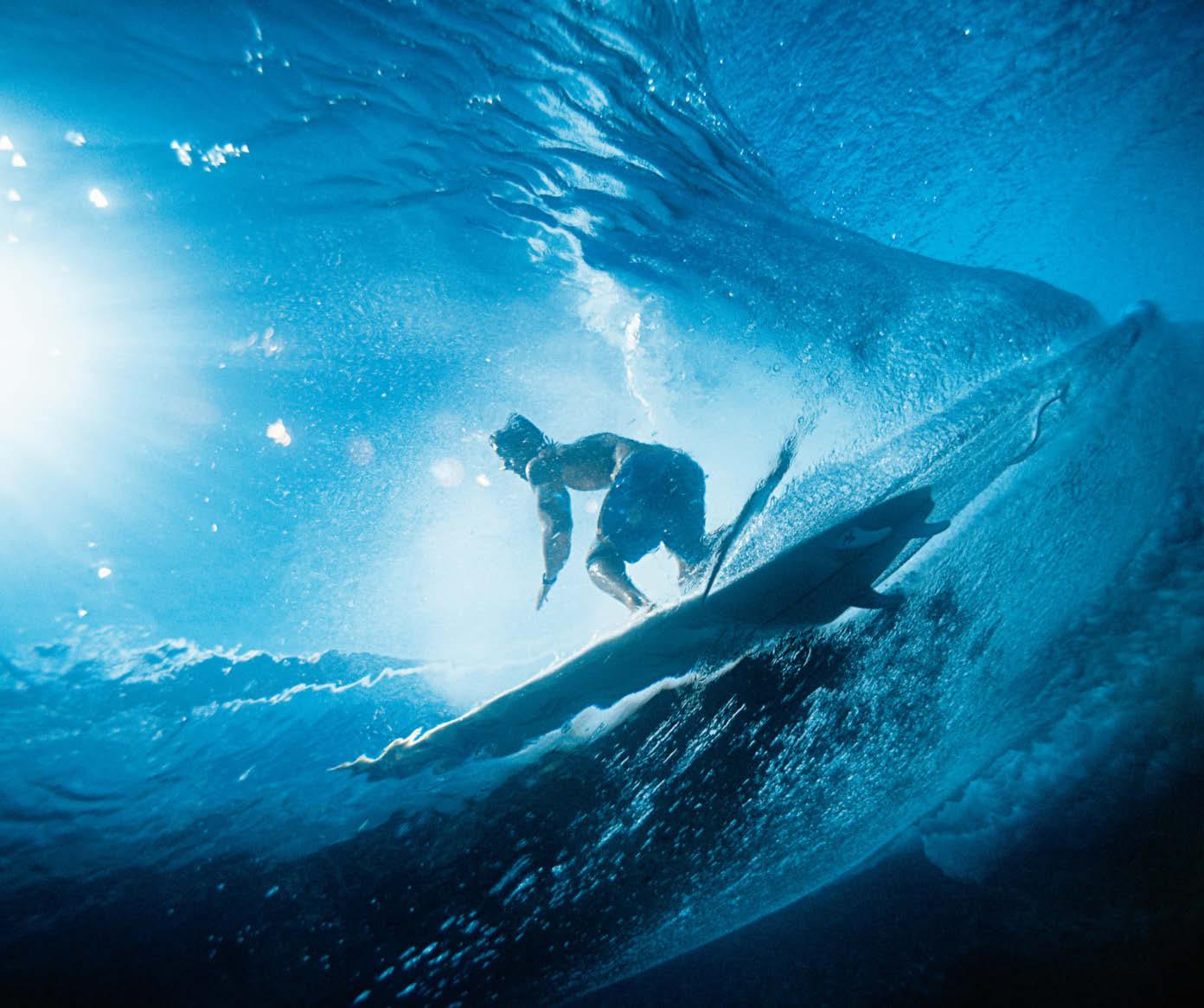
To capture legendary Tahitian surfer Manoa Drollet in the blue interior of a wave, Grambeau freedived below the surface, wearing a weighted belt to stabilize himself. “I’m inside the wall of the wave; you can literally see an internal perspective of the wave breaking,” he says. Even more remarkable is that this was shot on a flm camera back in 1998. “When I saw the image, I fell in love,” Grambeau adds.
TED GRAMBEAU
THE RED BULLETIN 59
ART IN MOTION
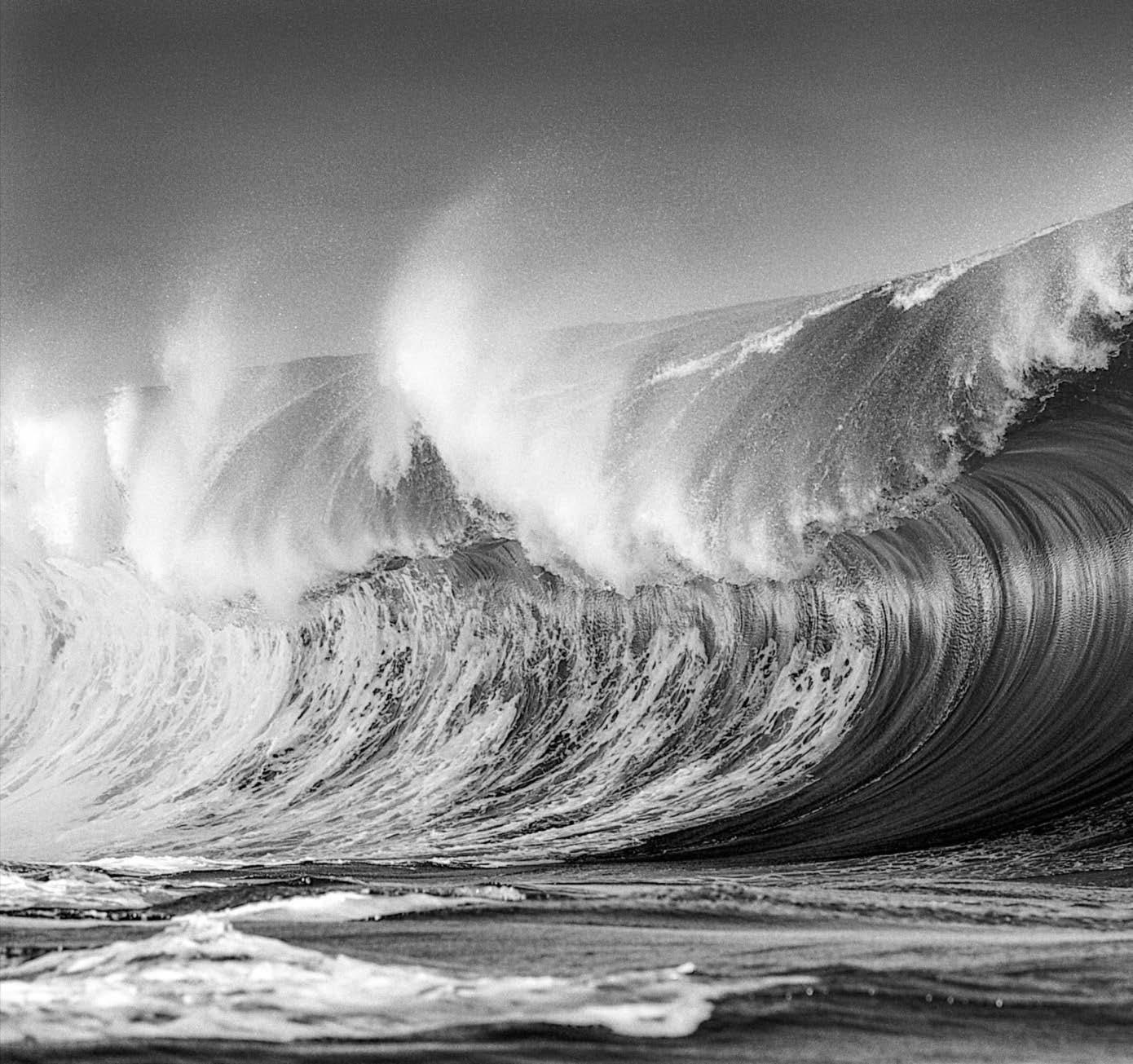 In 2014, Grambeau captured the true art of Teahupo’o in black and white. “Those moments speak to the power and beauty in awesome tones,” he says.
“It has a mesmerizing beauty of energy that is almost seductive in nature. For some 35 years, I have been repeatedly drawn back to this sacred reef in the Pacifc, where no two swells are ever the same.”
In 2014, Grambeau captured the true art of Teahupo’o in black and white. “Those moments speak to the power and beauty in awesome tones,” he says.
“It has a mesmerizing beauty of energy that is almost seductive in nature. For some 35 years, I have been repeatedly drawn back to this sacred reef in the Pacifc, where no two swells are ever the same.”

TED GRAMBEAU THE RED BULLETIN 61
ART IN MOTION
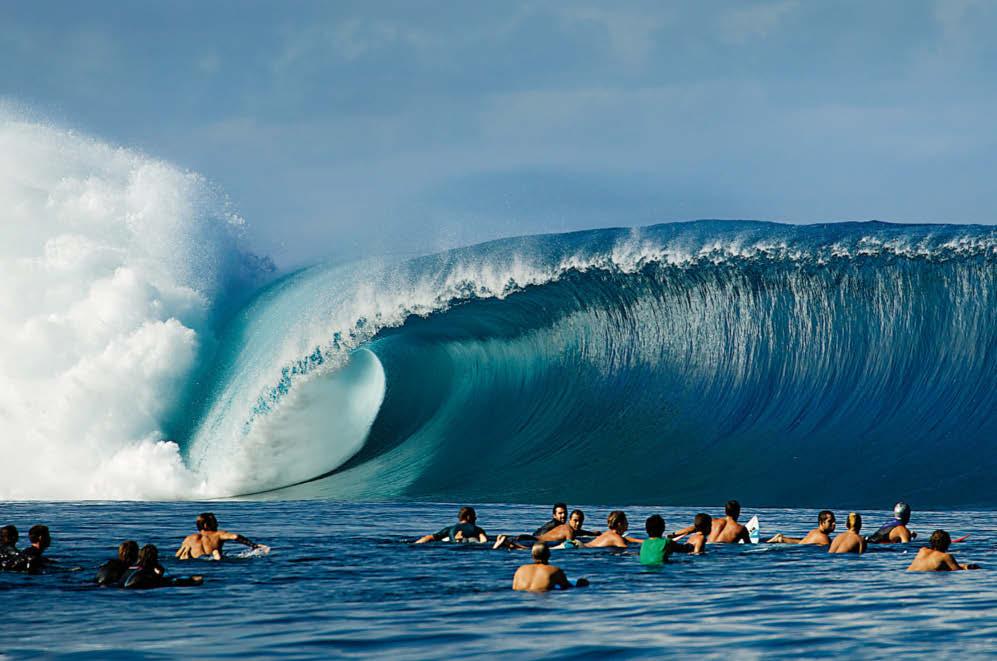
Above: A group of brave surfers wait their turn to tackle one of the most dangerous waves in the world in 2006. “Teahupo’o” roughly translates to “the pile of heads,” a foreboding name for a beast of a break. Right: Big-wave surfer Russell Bierke— who won Red Bull Cape Fear in 2016, when he was only 18 years old—is known for pushing his limits, but even the most fearless souls can meet their match when they drop into Teahupo’o.

TED GRAMBEAU THE RED BULLETIN 63
“This was a last-minute trip to Tahiti to chase a swell. We saw several days of good surf, so my husband and I decided to strike it to do some training, get some content for the film I’m working on and, of course, relax and recharge in paradise.”

ART IN MOTION Postcard from a Pro
64 THE RED BULLETIN Ben Thouard

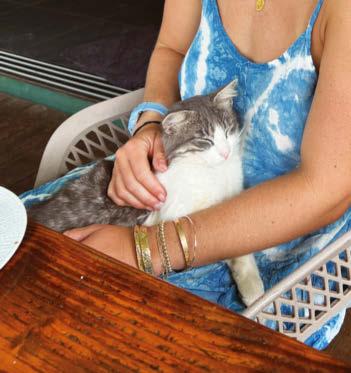
LIFE IS SWELL
Pro surf legend Carissa Moore offers an intimate look at an impromtu getaway to Tahiti.
BY PETER FLAX
This past March, with a big swell forecast in the South Pacifc, Carissa Moore made a quick decision to take a sort of working vacation in Tahiti. It was a perfect opportunity to get some valuable training on Teahupo’o, a fearsome and beautiful wave that will be on everyone’s mind this summer. It was also a wonderful excuse to get some much-needed quality time in paradise with friends and her husband, Luke. Finally, it provided a chance to capture some quality footage for a flm that Moore is working on. Here, featuring photos pulled right of her phone and recollections of the trip in her own words, is a deeply personal look at Moore’s spur-of-themoment adventure to French Polynesia.
MOORE JUMPED AT THE CHANCE TO GET MORE FAMILIAR WITH TEAHUPO’O.

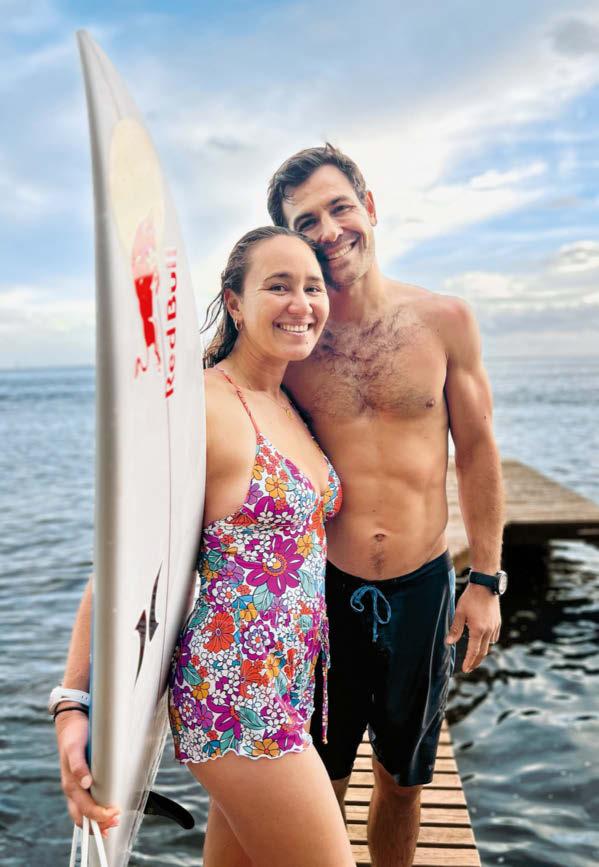
“Working
with a local coach, Tahurai, on my backside tube riding and approach, I’m getting comfortablemorewith lineups and wave selection. This will help me prepare for events coming up at this very special but challenging wave.”
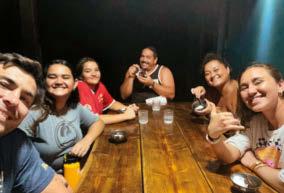

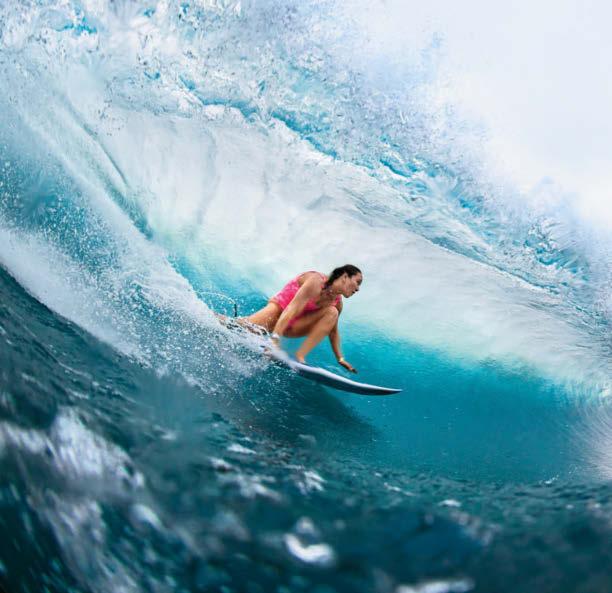




ART IN MOTION Postcard from a Pro
66 THE RED BULLETIN
Courtesy of Carissa Moore (7), Ben Thouard (2)

“These experiences are ten times more meaningful getting to share it with the people I love. I feel fortunate to bring my husband along on most trips. We look forward to showing our future kids the photos and telling them stories of our epic adventures.”



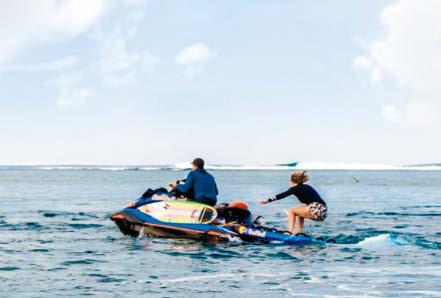




“Tahiti reminds me a lot of home. The feeling of Aloha, warmth, community makes this place special. It feels like living is simple and kindness and respect are the codes to live by. As it should be. Family, friends, good waves, good food. Mahalo to the locals for making me feel welcome.”
MOORE MIXES BUSINESS WITH PLEASURE IN TAHITI.
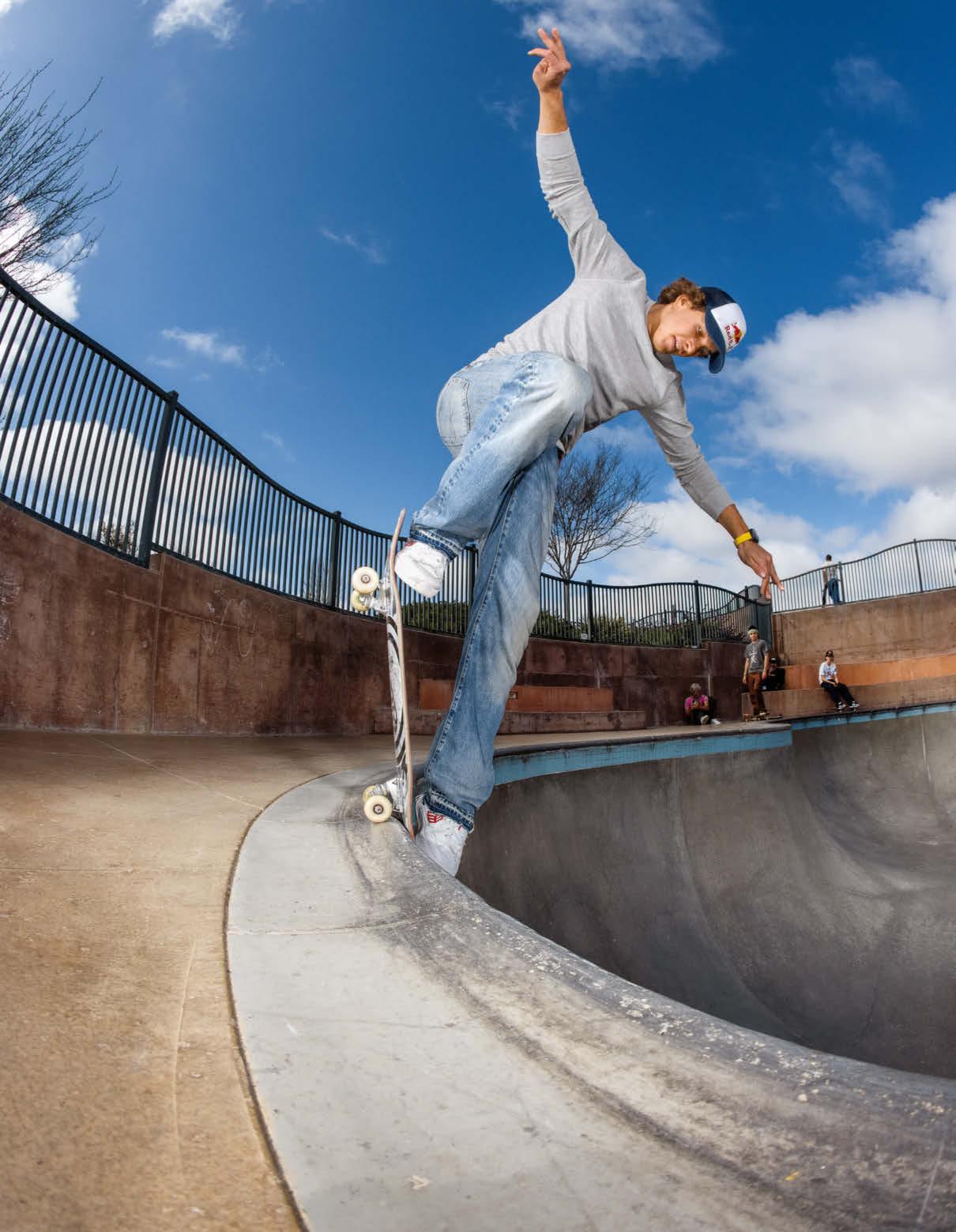
DRIVEN DRIVEN PROCESS PROCESS
ART IN MOTION

Jagger Eaton, among the best skaters in the world in both the street and park disciplines, has completely reengineered his life to reach his full potential.
THE RED BULLETIN 69
WORDS BY COLE LOUISON
PHOTOS
BY ATIBA
JEFFERSON

“Skateboarding is dangerous,” Eaton says. “It forces you to be incredibly present with the action that you’re doing right now.”
ART IN MOTION
70 THE RED BULLETIN
Anthony Acosta/Red Bull Content Pool

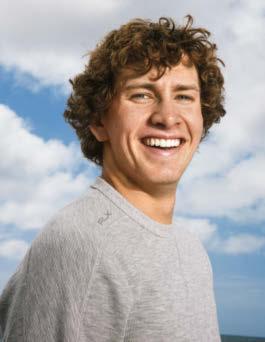
Jagger Eaton starts each day in the Pacific. His alarm goes off at 6:20, and 10 minutes later he’s in the ocean, rain or shine. Yes, it’s frigid. That’s the idea. “To lower inflammation, there’s nothing better than to lower your body temperature,” he says. “I get very cold—that helps keep me in shape.”
Like most elite athletes, Eaton lives every day with injuries and pain, but unlike many pros he prioritizes mental health as a huge part of the treatment. It’s one reason he left his native Arizona and moved to Southern California, to live an ultrastructured life aimed at honing the power of his body, mind and soul.
“The ocean is great for your spirit,” adds Eaton, who abstains from skate culture’s hard-partying cliches. “To be there on the beach in the morning, every day, it’s great for your mentals.”
It makes sense that he lives here, where skateboarding began circa 1960. His home is in Encinitas, in San Diego County—a coastal city whose YMCA boasts a 60,000-square-foot skatepark and Tony Hawk Day is observed on May 29th. Hawk is one of many iconic skaters who came from and still comes from here. But honestly, Eaton didn’t come here as a historical tribute. He came here to train in a more controlled way—and to boost his mentals.
Consider his breakfast, consumed every day at 7 a.m., sharp. Beans, leafy greens, four eggs with cheese and more water than you’d think a human body could hold.
At 7:45 comes an hour of “something positive.” And no, it’s not a TikTok channel or Tony Robbins podcast. Usually it’s journaling or reading—currently The Power of Now by German spiritualist Eckhart Tolle. The phone is off. “It’s to inspire the day,” proclaims Eaton. “And to get ready to work.”
Now seated in an office in a New York City high-rise, in a different universe than coastal California, Eaton looks happy, healthy and relaxed. He’s scheduled for a few structured hours of interviews with general-interest media outlets. With a trip to France looming, reporters want to speak to this 2021 bronze medalist, celebrity and extraordinarily good skateboarder.
He’s had to reenter the spotlight, and everyone seems to be watching: Fans, agents, coaches, sponsors, media and those who control the baffling ranking system for pro skaters. “Pressure’s never been higher,” he says. “And that’s OK. It’s actually a blessing—to be recognized for something I love so much.”
He can deal with the circus better than before, and credits this to his new diet, exercise and mental wellness routines. “For me that’s what this new journey is about,” he says. “To adapt and stay present while going through this process.”
BLXST JAGGER THE RED BULLETIN 71
“Process” is an important word to Eaton these days. He uses it a lot. It’s a reminder that things are ever-changing, that there’s no single reason he got on this new path.
This particular journey started in 2021, when Eaton went from being a top pro athlete to being the Arizona kid who returned from Tokyo with the bronze in street skating. No other American skaters placed, and skateboarding was new to the Games. He was on The Tonight Show.
He reflects now on the impact of overnight celebrity. The sudden spotlight, friend groups, invitations, interview requests— the endless @s on social media, comped drinks and free meals. The meals, he sees now, weren’t the best thing. “I wasn’t eating what was going to optimize my potential each day,” he says.
Thus began a basic watch-what-you-eat approach. But because Eaton rarely takes a basic approach to anything, things escalated quickly. Before long, he’d cut his intake of sugar, empty carbs and “anything that’s not fuel.” The changes felt “dramatic,” he says. “That’s when I realized: It’s not just what you eat, it’s what you don’t eat.” This launched a series of full-on wellness revelations. He could see that the things he’d always done for his mental health were important, but now the things he did not do were just as important.
Greater changes followed: He gave up drinking, social media and hanging out with people who didn’t feel 100 percent positive. Then he moved to Southern California.
In short, he changed almost everything.
Back at home in Encinitas, after a chilly ocean plunge and his mindfully perfect breakfast, the workday begins.
Training starts at 9:30, if one can call it that. “It’s training but it’s not-training,” he says. More of a preworkout, this is new to his exercise regimen and essential to mental health. It resembles a 90-minute yoga class, if the class were taught by Navy SEAL scientists dressed like extras from Point Break
This is breath and stretch work led by strength trainer and pain expert Paul Hiniker. Many of those in alt-sports’ higher circles try to hire Instructor Paul. A 50-year-old SoCal native with a surfer’s tan and a build like the Incredible Hulk, his clients include pro golfer Rory McIlroy and one of Eaton skate heroes, Danny Way, whose trials and triumphs are so legendary that a Harvard professor made a movie about them.
Instructor Paul takes Eaton through a session split in two parts. The first is diaphragmatic breathing. Also called “belly breathing,” it focuses less on the chest and more on the stomach to engage the diaphragm. The result is deeper breathing, and thus more air in the lungs. This increases circulation and better oxygenates the blood, which in turn boosts energy and strengthens the immune system. And like those ocean plunges, belly breathing has another perk: It’s great for the mentals. “Paying attention to each breath serves to quiet the mind,” notes a recent study from the University of Michigan. This has huge benefits: It lowers blood pressure, eases muscle tension and reduces stress hormones.
Next is active flexibility, or active stretching. This takes a collective approach to an athlete’s typical stretch training—the idea that engaging one muscle engages the others around it. The longer-term results are an increase in overall strength and flexibility, something that can improve an athlete’s jab, drive, stroke, paddle or ollie. “It’s all to get my body prepared,” Eaton says. “Prepared for real training.”
This has changed, too, and that’s because his goals have changed. Eaton doesn’t just want to re-medal in the street event. This time, he wants to be the first to compete on the biggest stage in both events: street and park. (Street courses are flatter, with stairs, rails and ledges that cater to flip and spin tricks; park courses are more swimming pool-ish, with big drops and transitions that invite tricks done in the air.)
These dual interests aren’t new to this multitalent, who started skating at age 4. He grew up riding everything. So did his home crew, including nonbinary pro Alana Smith. Eventually most of them branched off, focusing on one discipline or the other. Eaton has never understood this. “I love skateboarding so much,” he says. “So I never saw why you would only compete in one event.”
He kept skating everything, and did it all very well. At the 2012 X Games, Eaton made history as the youngest-ever X Games competitor. He was 11. Five years later, as an amateur, he won in street. Two years after that, he took second in park. Three years later, he won. (In 2012, he also braved the Mega Ramp—basically a ski jump for skaters—created by none other than Danny Way.)
Training to be the best in both disciplines is hard. In fact, what he’s doing right now is arguably twice as hard as his 2021 regimen, since he’s training for two events instead of one.
“On this path, doing both events, everything has to be different,” he says. “Everything has to be structured. Actually, everything has to be regimented.”
No athletes know what the skate courses will look like this summer. But here in Encinitas, the park and street courses have been re-created with almost every variety of drop, rail, kicker, platform, stairset and transition. Navigating so many possible scenarios helps ensure that nothing will surprise Eaton when he rolls onto the biggest stage in the world.
At 11:30 he’s on the street course, earpods in and ready to work. His stree-skating mix has always been “new rap,” like Ken Carson and Playboi Carti, with “old country,” like Hank Williams and the Charlie Daniels Band. (Fun fact: Eaton has western tatted across his chest and rode rodeo as a kid)
He pinpoints a single obstacle on the course, like a flat handrail over a 12-stair drop. Then he works in sets of three: The same trick, attempted three times. If perfected, he might add to it. If not, he simplifies, subtracting a flip or rotation, until he nails it. Then he builds. Once an obstacle is mastered, he moves on.
Street tricks don’t pose the same danger as jumping the Mega at 60 mph or flying 10 feet high over the coped edge of a pool. The risks are more subtle. In this case, he has to fly backwards over 12 concrete points, each one perfect for wrecking an ankle.
“Everything has to be structured. Actually, everything has to be regimented.”
MUSIC
IN MOTION
ART
72 THE RED BULLETIN

“On this path, doing both events, everything has to be different,” says Eaton, who was photographed in Encinitas, California, on April 24.
BLXST JAGGER
THE RED BULLETIN 73
“I love skateboarding so much,” Eaton says.
“So I never saw why you would only compete in one event.”

ART IN MOTION 74

BLXST JAGGER THE RED BULLETIN 75
“I’m obsessed. Obsessed with being the best I can be.”
Asked about injuries, he laughs. “Which ones hurt more!? Well, street’s on the top of the list for nagging injuries. You get more rolled ankles. Knee and hip problems. Skating street you get hurt a lot more, and those injuries are harder to heal.”
At 1 p.m. he breaks for lunch at Chipotle, usually a high-protein bowl or burrito with rice, beans and chicken.
Then it’s time for park. This means Metallica, full pads and a helmet. The course he trains on is a concrete moonscape of ramps and pools and about the scariest thing you’ve ever seen if you’ve ever fallen hard in a pool. “Park’s different,” he says. “Park you can have really serious injuries.”
There’s a note of reserved caution in his voice, as if he might not go on. But he does. “A year ago in park, I concussed myself,” he says. “Hit my head and had a seizure. I was OK. But those-type injuries happen a lot more. Scary injuries.”
He changes tone again, suddenly sounding more like a wellness guru than a kid pouring sweat from his helmet. “Skateboarding is dangerous,” he observes. “It forces you to be incredibly present with the action that you’re doing right now. That mindbody connection, that comes from the fear we face on a daily basis. It’s why there’s so much respect in our community.”
“Look,” he continues, “I’m never not afraid to skate. There’s always something that can happen. My whole goal is to balance— to ride that line to the point of pushing it, then pull back. And keep going further each day.”
In addition to this meta-thinking, Eaton also trains with competition scoring in mind. The two events are different in this way, too: Street’s scored by the individual tricks, but the scores in park are based on the full run. So practicing here in park, he also has to think about each part as well as the whole. “The format in park is very different,” he explains. “Street is two runs, five tricks, and three of those tricks count for your total score. In park, it’s just three 45-second runs, lines. And in each line you usually do three trick sequences. But you get scored for the overall run.” (If it’s not yet obvious, Eaton is an expert on scoring and ranking. Recently he explained the preposterously complex qualification algorithm to listeners on Tony Hawk’s podcast.)
“So for park, we always practice full lines,” he says. “That’s an hour and a half.” Within those lines, however, he applies the same approach that he uses for street: Break everything down. Isolate the variables. If a trick’s not perfect, dial back, isolate, re-think it, then try again. Once a trick’s perfected, enhance it.
In a way, Eaton isn’t perfecting tricks; he’s inventing them. “You can’t really give advice,” he says. “When you’re trying to do something that no one else is doing, obviously, nobody’s done it. So you have to create it yourself. That’s what I’m doing.”
Whatever he’s doing, his micro/macro type of skating has yielded technical tricks akin to street skating but brought into (and high above) the park genre. He did so at the last X Games, in
Ventura, California, flowing, flipping and spinning through the course as if it were a local parking lot. Hawk was announcing, and took notice. “Kick-flip back lip!?” the birdman exclaimed. “There it is!” Hawk was right; Eaton took gold that day.
By 3 p.m., skating usually wraps for the day. As a kid he’d skate his local park for seven hours at a time, but these days he makes himself stop. Instead, most afternoons end with a round of golf, another mind/body meld that Eaton can tell you all about, how it helps him be present and focus, as well as the importance of golf’s social aspect after a long day of solo training. (Is it a surprise that he’s really good at golf?)
These golf outings typically wrap by 6:30, followed by dinner: steak, more leafy greens, vegetables like brussels sprouts and a smaller helping of carbs, like mashed potatoes.
In order to wind down properly and get what he calls “good sleep,” he’s in bed most nights by 9. Yes, the guy who could be anywhere, doing anything, sometimes goes to bed before the sun sets. “There’s sacrifices,” he says. “But now I see the progress.”
“That’s the biggest change since 2021,” he says. “My mental strength. That ability to not just be disciplined, but to see the value in the journey. I’m in love with the journey. And that’s the most common theme with the athletes who I aspire to be like.”
And who would that be? Danny Way? Tony Hawk? “Jordan,” he says. “Michael Jordan was never anywhere but here. He was always so engulfed in the process and the journey of being the best that he could be. That’s what you’re looking at here. I’m obsessed. Obsessed with being the best I can be.”
Will Eaton, like MJ, become a historical figure, iconic in worlds far beyond his sport, and a hero to new generations, like when the teenage LeBron chose his hero’s number, number 23?
This summer, Eaton wants to make history. And his chances look good. As this issue heads to the press, he’s nationally ranked No. 2 in both events. He looks forward to a trip to Paris, and, in contrast to his life of isolation, looks forward to the crowd— which was absent in 2021 due to COVID.
“I love a crowd!” he exclaims, and almost begins to shout.
“Look at Tony doing the 900! I was raised on that video!” he says of a clip viewed 20 million times. “That’s a great example of what a crowd can do!”
“When I got gold at Ventura, my whole family was there, my friends, but the crowd—the crowd was amazing,” he says. “And being an athlete, I’m a very present person, just being in that moment. And it’s like, this is the time. This is what every single day in the park was meant for. I’m meant to be here.”
“That’s what I think athletics is—a chance for humans to show 100 percent of themselves, doing what they love,” he says. “Athletes are all a little crazy, because we train our whole lives for these certain moments. And when those moments happen the way they do, it’s the greatest thing in the world.”
MUSIC
ART IN MOTION 76 THE RED BULLETIN
“Athletes are all a little crazy, because we train our whole lives for these certain moments,” says Eaton, who certainly has a couple big moments looming this summer.
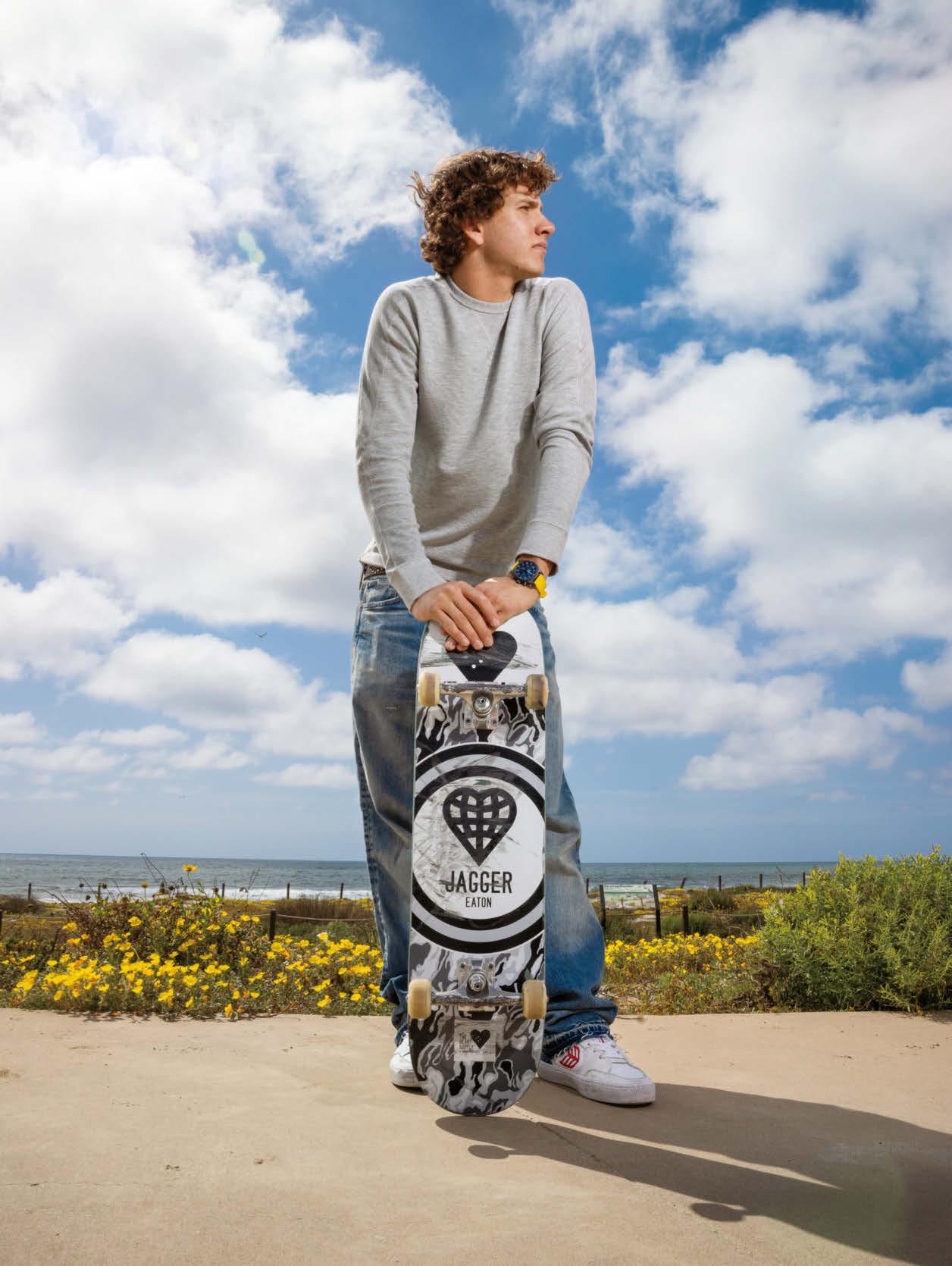
THE RED BULLETIN 77
JAGGER
EATON

ART IN MOTION
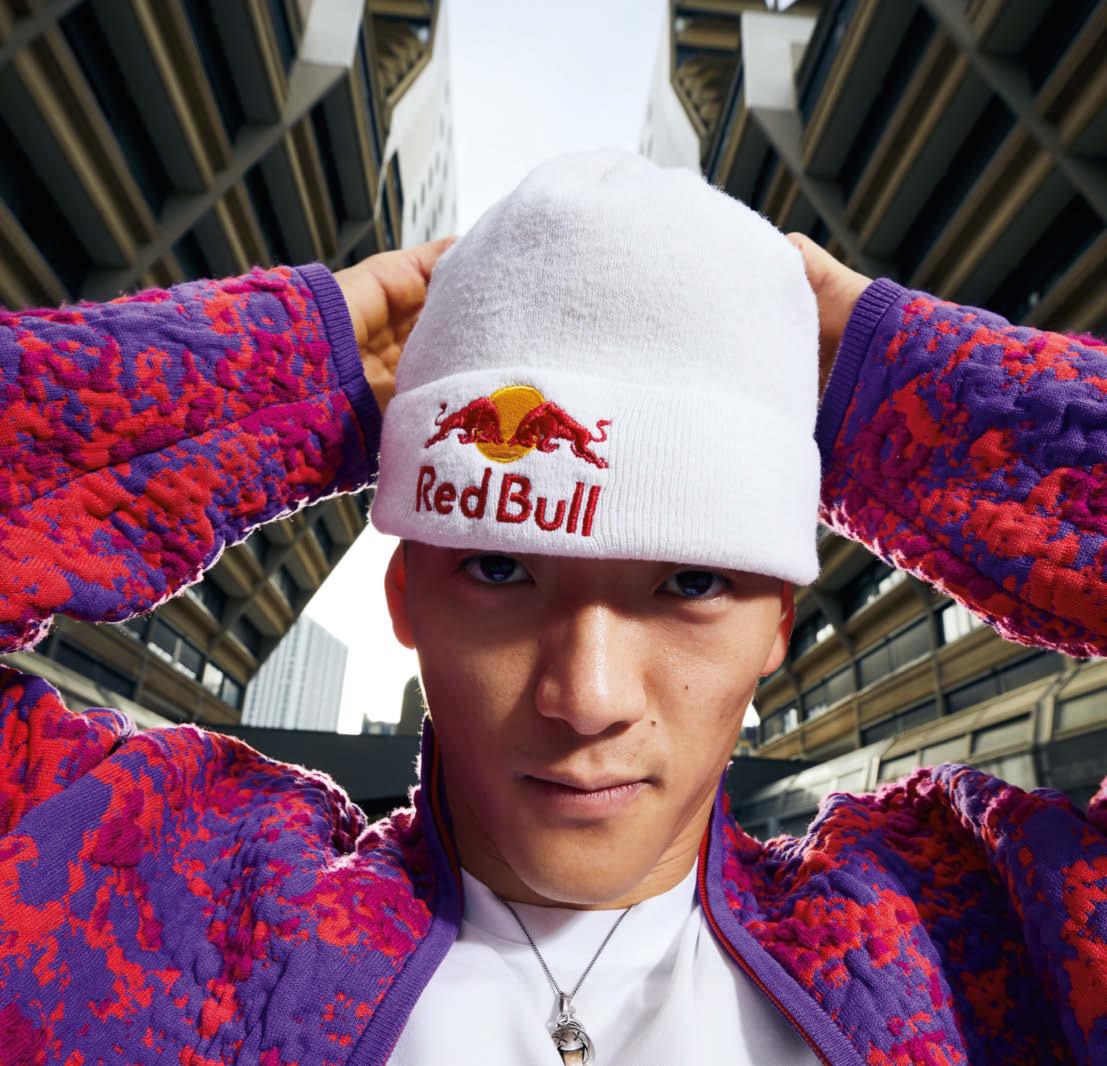
B-boy PHIL WIZARD, whose rare skills have helped him win countless battles on his rise to the top of the breaking scene, possesses a talent for real magic. But to reach even loftier heights, the Canadian first had to face his greatest adversary: himself.
PHIL WIZARD
79 WORDS BY ZOEY GOTO PHOTOS BY CHRIS SAUNDERS
ART IN MOTION
For many of us, genuine success may forever feel tantalizingly out of reach, each accomplished goal quickly replaced by another in a continuously revolving carousel of aspiration. But what happens to those who shoot for the moon and somehow reach it? What motivates them to get out of bed every morning when they’ve already achieved their ultimate ambition?
Recently, The Red Bulletin put this very question to Philip Kim, the 27-year-old Canadian breaker better known as Phil Wizard. In just a few short years, Wizard has gone from crashing out of the first round of the 2019 Red Bull BC One World Final—the biggest international breaking competition—to becoming the scene’s fastest-rising star and a favorite to step onto the podium at the 2024 Summer Olympics. Along the way, in May 2022, he fulfilled a lifelong ambition by joining the Red Bull BC One All Stars, a select dance crew comprising some of the world’s most talented breakers. It’s a moment he emotionally described at the time as his “dream come true.”
When asked to pinpoint how this whirlwind started, Wizard’s official line is that at the age of 12 he saw the Now or Never Crew—a pillar of the Vancouver hip-hop scene—perform on the city’s streets and it blew his impressionable young mind. Shortly after, the stars aligned when one of the crew members visited Wizard’s school to teach a workshop, inspiring him to sign up for dance camps. The other, perhaps less cool inspiration on young Philip Kim was the romantic dance-film franchise Step Up.
“I’m embarrassed to say it, but I loved those cheesy movies. When you’re a kid, you think it’s so sick—they’re dancing in the rain and stuff,” he laughs with mock awe. “I was an active and imaginative kid growing up, watching lots of anime and superheroes, then running around pretending to be those things. It really wasn’t about breaking at first; it was more about the choreography.”
When Wizard entered his teens this changed, and his life became all but consumed by breaking—the acrobatic, highly stylized form of street dance that came to life in the Bronx back in the 1970s. His spare time was spent studying YouTube clips of
well-known breakers and hanging out with local crews, picking up tips on how to walk the delicate line between creativity and commercial success. This blossoming obsession with the breaking scene was out of step with the expectations of the Kim household: Wizard’s siblings pursued more parent-approved careers in fields such as insurance and law.
“I was the odd one out,” he admits. “And there’s an added pressure, coming from an immigrant family.”
Wizard’s mother was still pregnant with the future B-boy when the Kim family, which also included two older brothers and their pastor father, moved from Korea to Canada in search of a new life. “My parents sacrificed a lot to come to Canada, and they really wanted security for their kids,” he says. “Going left-field and choosing breaking as a career was a really difficult call for them, but also for myself,” he reflects.
To appease his family, Wizard signed up to study psychology at university, but he walked away from the course after his first semester. “I dropped out because the Red Bull BC One cypher— the prequalification for the world finals—was happening in L.A.,” he says. “I told myself that if I won the event, I’d drop everything and give dance a serious shot.” The gamble paid off when Wizard took first place, setting him on the path to becoming a professional breaker.
But there was still a major hurdle to overcome: While Wizard had assured others of his talent, he had yet to convince himself. “It was a daily battle, questioning if I should be doing this or going back to school,” he recalls, describing this uncertain time as the darkest period of his life. While he was finding his feet, Wizard returned to living with his parents and hustled a wage from breaking with the Now or Never Crew, sometimes performing at corporate gigs, or as the after-dinner entertainment at weddings. At the same time, he established himself as a fixture on the competition circuit.
“I had a lot of mental struggles figuring out what I wanted to do during that time,” Wizard says. “Looking back, I don’t think I was necessarily the most talented dancer. I certainly wasn’t the kid
“I try to be more present and bring a positive attitude to any competition. . . . My life philosophy is that I can only control what I can control. I try to be freer in the way that I dance and compete.”
80 THE RED BULLETIN

PHIL WIZARD
Philip Kim, the 27-year-old Canadian B-boy better known as Phil Wizard, was photographed for The Red Bulletin in Paris in October last year.
ART IN MOTION
[about whom] everyone was like, ‘He’s going to make it and be the best.’ But I crept up incrementally because I was so passionate about it.”
Breaking was now Wizard’s entire universe. Every time he walked down the street, his mind would wander, choreographing new routines—an ongoing rhythmic dialogue that persists in his head to this day.
The hallelujah moment that freed Wizard from his mental anguish occurred just a couple of years ago and, surprisingly, it had little to do with mastering new breaking moves. Instead, it came down to a shift in mentality: What had been holding Wizard back all those years, he realized, was himself.
“There were points in competitions when I had such bad imposter syndrome that it was really detrimental,” he says. “I’d be in a semifinal but feel I didn’t deserve to win, that I was a fraud, and it would all come crashing down.” It dawned on Wizard that a lack of confidence, combined with a hunger to succeed, had been negatively impacting his performance and his mental health. “I needed to win to progress so that I could eventually earn enough money to make a living from this. Every event mattered so much to me. I was beaten up when I lost. Even when I won, I’d give myself a hard time if I felt I hadn’t given my best performance.”
Wizard realized that he needed to loosen up on all fronts, so he adopted a new way of thinking. “It was about letting go of expectations—both internal and external—and trying to enjoy the moment,” he explains. “I don’t meditate, but now I try to be more present in the moment and bring a positive attitude to any competition. It took a long time to integrate this [into my performances] and even today the imposter syndrome comes and goes. But my life philosophy is that I can only control what I can control. I try to be freer in the way that I dance and compete now.”
Self-doubt may have got the better of Wizard at the BC One World Final back in 2019, but today he’s at the top of his game. In 2023 alone, he notched up four wins on the circuit, and he’s currently ranked No. 2 in the world by the World DanceSport Federation. Life now involves running with a pack of elite breakers who ping-pong around the globe, competing at events as far afield as South Korea, Brazil, Portugal and the U.K. For the past year, Wizard has barely spent longer than a week back home in Vancouver, and when he is there, he stays off-grid, deleting all his socials. “It’s my time to shut down, chill and sleep,” Wizard explains. “Honestly, I’m not a very fun person when I’m at home. I do all the exciting stuff, like cool content shoots, competing and seeing friends, when I’m on the road.”
Breaking is followed by a supportive and tight-knit community, but bring up its inclusion as a contested event in this year’s Games in Paris and things become a little divisive. The fear among breaking purists is that the art form, which originated as a creative outlet for New York’s marginalized youth, many of them
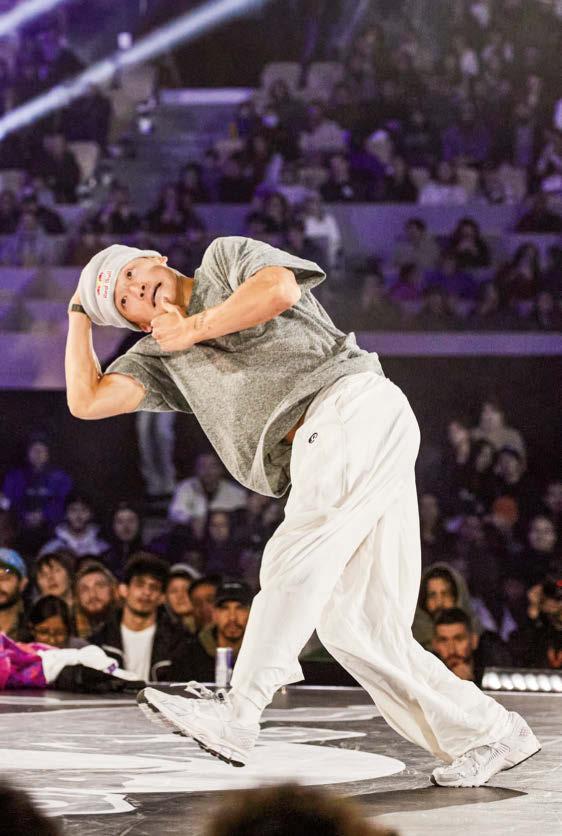
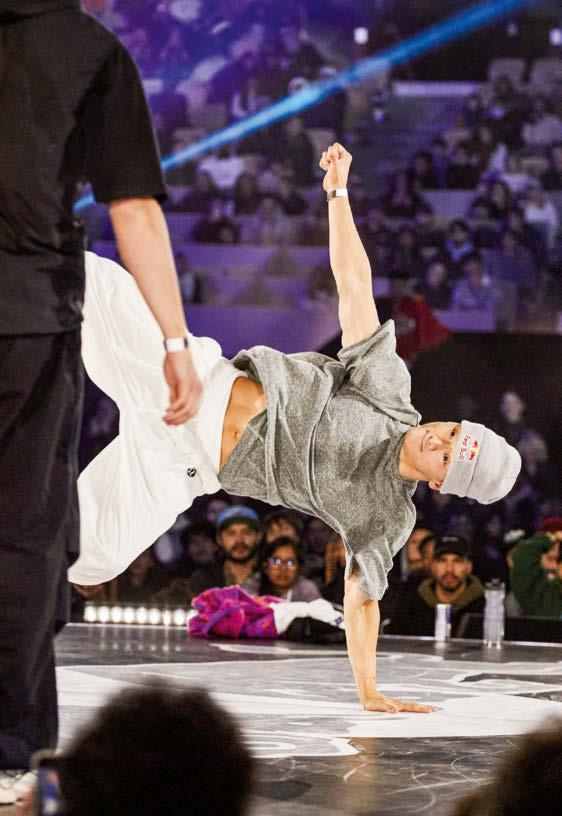
82 THE RED BULLETIN
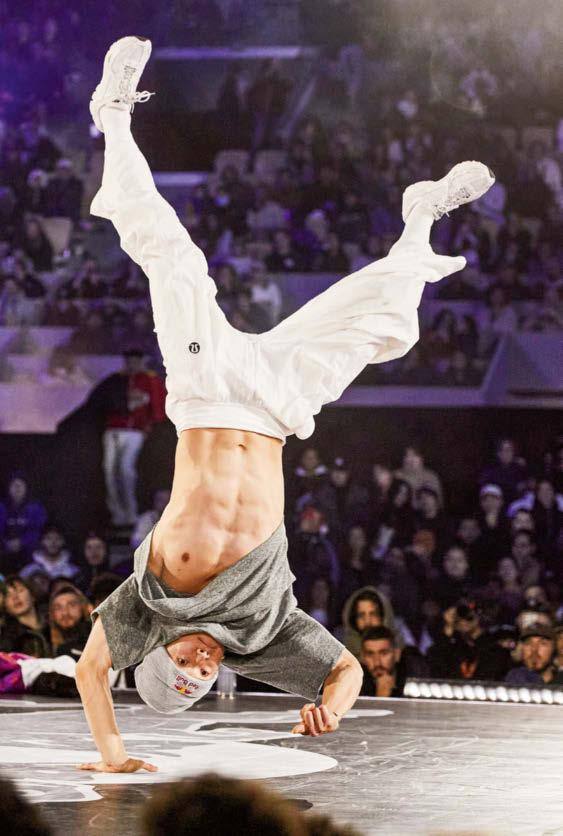
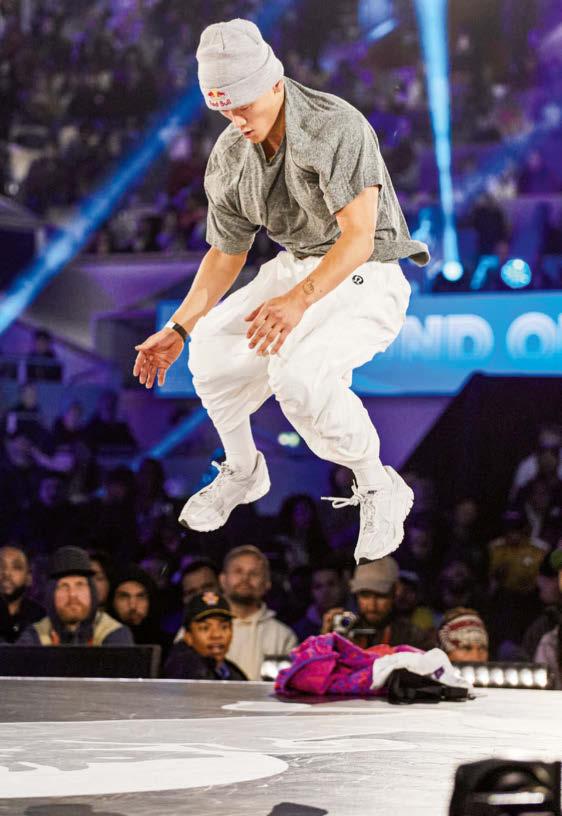
Black or Hispanic, now runs the risk of becoming severed from its countercultural roots.
This is certainly a crossroads moment for breaking, but Wizard sees its inclusion as a mostly positive development. “Of course, things will change, and it’s uncomfortable for people, as change is always unsettling,” he says. “In a way, you can already feel it now with a more competitive atmosphere, the seriousness of the events, and more sponsors coming in. But I don’t think it’s all bad. Ultimately, I think the Olympics will help grow breaking and put it on a platform that introduces it to new people who might not have otherwise had access. Sure, there’s now the ‘sport’ route, but there’s also still a culture. The underground scene will always be there. You can always throw a jam and people will turn up.”
Although steadfast in his opinion that breaking is first and foremost an art form, Wizard notes that long before the International Olympic Committee announced, in December 2020, that it would feature at the 2024 Games, he’d already seen a shift in focus within the community toward the athletic component. “I’ll train for around 20 to 25 hours a week when I’m at home, running my moves,” he says. “Breaking is still so young that people didn’t really used to think about longevity, but I’m part of a younger generation that wants to take care of their bodies so we can do this for longer. Having said that, my diet is still basically just pastries.”
It’s not only breaking that has been going through an identity crisis of late: Wizard himself admits to having experienced a conflict of emotions ever since his lifetime ambition of becoming a member of the Red Bull BC One All Stars was realized two years ago.
“I was quite lost for a while because that had always been the pinnacle I’d aimed for,” he says. “Winning BC One or the Olympics . . . sure, these are great opportunities, but I’ve never cared about them in the same way as being an All Star.” When it finally happened, he lived off the high for roughly a year, before crashing back down to earth. “I had a feeling of, ‘I’ve done everything I want to do careerwise. What’s next?’ ”
Wizard’s answer was to scrap strategizing altogether, instead leaning further into his innate creativity. “Yeah, competitively I’m now at a high level, but I’m nowhere near where I want to be artistically. When I watch myself, I see flaws and moments when I get locked up. It’s now about pushing my craft, developing a sense of freedom and extending my vocabulary to find new movements. It’s the realization that I’m not there yet, that there’s still work to be done.”
More than anything, Wizard just wants to enjoy the process and feel upbeat coming out of every round. “It’s an impossible goal,” he admits, laughing. “But that’s why it keeps me motivated. I’m striving for it while knowing that, on another level, it will never happen.”
During the last round of the 2023 Red Bull BC One World Final in Paris, Phil Wizard battled against Hong 10 of South Korea. Although Wizard lost, Hong 10 said of his opponent: “He is next level. You never know who will win in a battle.”
PHIL WIZARD
THE RED BULLETIN 83
NEWHEIGHTS NEWHEIGHTS NEWHEIGHTS NEWHEIGH TSNEWHEIGH NEWHEIGHTS NNEWHEIGHTS EWHEIGHTS HEIGH
HEIGEWHEIGHTS HTS
S S S HTS HTS S S S HTS 2024 ISSUE 2 THE RED BULLETIN QUARTERLY 86
96
106
Mondo Duplantis
Sasha DiGiulian
Saluting trailblazers who are soaring to new heights THE RED BULLETIN 85
Chasing Darkness
FREQUENT FLYER

The uplifting legend of Mondo Duplantis,
NEW HEIGHTS
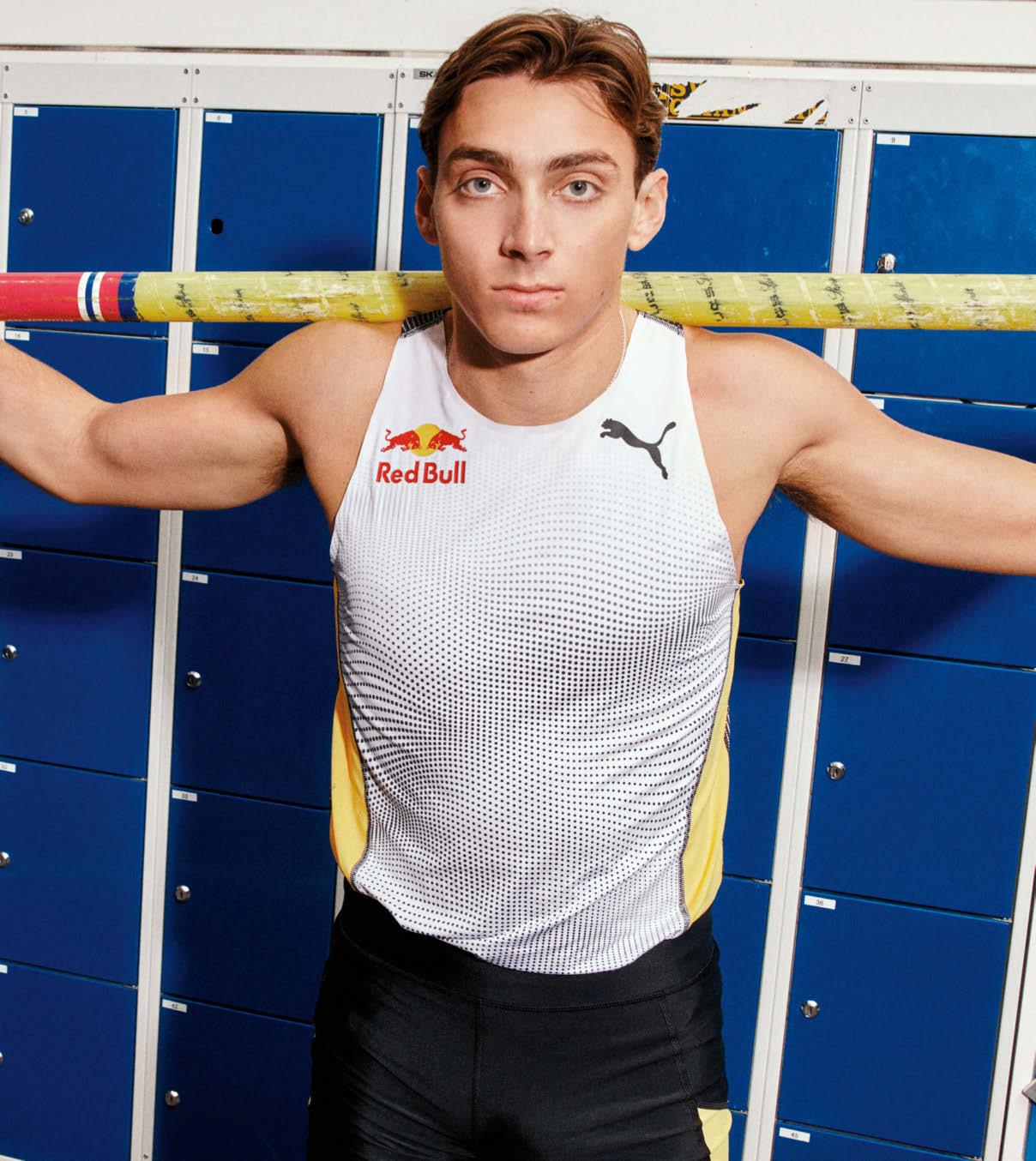
who is well on his way to being the greatest pole
vaulter of all time, is still being written.
BY PETER FLAX PHOTOS BY ADAM KLINGETEG MONDO DUPLANTIS
WORDS
87

The story simply must begin with Mondo Duplantis sailing through airspace. This is what he does—defying the perpetual demands of gravity with verve and joy.
This time the spectacle goes down on a magical Sunday evening in July, as long shadows and golden light fll Hayward Field, America’s cathedral for track and feld in Eugene, Oregon. These are the closing moments of the 2022 World Athletics Championships—every other event in the 10-day program has concluded, and the rest of the feld of world-class pole vaulters is done, too. Armand “Mondo” Duplantis, the Swedish American phenomenon, has already clinched the world championship. Yet he is at the end of the runway, ready to try one fnal jump.
Duplantis has asked offcials to raise the bar to 6.21 meters (20 feet, 4½ inches; a foot higher than the tallest giraffe ever measured), which would eclipse his own world record. He stands at the end of the runway, clapping his hands over his head to get the sellout crowd to bang out a rhythmic soundtrack for his flight.
Then, amid the thunderous applause and the perfect light and the undivided attention of the fans, Duplantis raises his fberglass pole and sprints down the runway at an otherworldly speed. The pole vault is a curious discipline, a physics experiment wrapped around a kinesiologic ballet. Planting the pole at a higher velocity brings more energy to bend the pole—which translates to greater force to propel a vaulter toward the sky. Then comes a mesmerizing sequence of gymnastic contortions to pivot over the bar without touching it. “It’s almost like a circus act,” he later tells me, trying to describe his chosen discipline.
In the span of a few seconds, Duplantis shows the Hayward faithful (and a global audience watching on TV) why he’s arguably the best to ever contest the event. After he plants and lets go of the bar, with his body vertical and his head facing down, he fluidly rotates his legs and then his torso to pivot a few centimeters over the bar. Then he is floating downward, with his eyes fxed on the bar and his arms aloft and a shit-eating grin on his face.
Minutes later a beaming Duplantis will tell a trackside television commentator that he has no memory of the recordsetting jump, that he was lost in a flow state that comes from a literal lifetime of vaulting. Though he’s only 22 on this summer evening, he fnished logging his 10,000 hours many years earlier.
And now, after he lands on the mat, he lets the emotion of the moment pour out of him and fll the stadium. Why wouldn’t you explode with joy at being the best the world has ever seen at the thing you love the most? Totally hyped, he skips and runs down the track, exhorting the crowd to share his transcendence.
And then, as if for good measure, Duplantis plants and lands a perfect front flip, an exuberant reminder that the forces of gravity don’t constrain him like the rest of us.
Without any hyperbole, Duplantis has been vaulting for longer than he can recall. “I can visualize a competition when I was 6 years old that I had one time in Nevada,” says Duplantis, now 24,
NEW HEIGHTS Richard Ström/Red Bull Content Pool

shown here jumping this past February in Sweden, has cleared the rarefed height of 6 meters (19 feet, 8 inches ) more than anyone in history.
MONDO DUPLANTIS
THE RED BULLETIN 89
Duplantis,
“I need to live my life like I’m free and not in a box. To perform at the highest level, I need balance.”

NEW HEIGHTS

sitting inside an indoor track facility on the outskirts of Stockholm. “I can remember that, but that’s about as far as my memory goes. But I’ve seen videos of me jumping when I was 4.”
Perhaps the best way to digest the youngster’s stunning development is a YouTube supercut uploaded by his uncle, Bob Duplantis, that documents the kid’s progression from 2006 to 2016. In a clip from 2007, he’s wearing baggy purple shorts that hang near his knees, and that little squirt clears 7’4” (2.24 m), a world record for a 7-year-old. That’s followed by a relentless montage of more age-group world records and junior championships, as a world-class talent emerges before your eyes.
As track fans know now, his development hardly slowed after that. At the 2018 European Championships in Berlin, Duplantis, 18 and no longer competing as a junior, became the youngest person to clear 6 meters—the vaulting equivalent of the four-minute mile, a barrier that fewer than 30 men have ever surpassed. In the time since that breakthrough in Berlin, Duplantis has jumped 6 meters over 70 times, way more than any vaulter in history.
As the records keep tumbling, one element of his talent is clear: Duplantis picked his parents well. His father, Greg, was an elite pole vaulter from Louisiana who cleared 19 feet (5.80 m) six years before Mondo was born; his mother, Helena, represented Sweden in the heptathlon. (And as if that wasn’t enough genetic frepower, her father once held the Swedish national record in the pole vault.) Helena met Greg after moving to the States to study at Louisiana State University (where she competed in both track and feld and volleyball). They eventually married and had four children—all of whom went on to become standout athletes. Both of Mondo’s older brothers were pole vaulting when he was still in diapers (Andreas represented Sweden as a junior, while Antoine switched to baseball and would ultimately become LSU’s all-time hits leader). These bonds remain intact. Mondo says that he and his brothers trade jokes and updates on a group chat “every day without fail—my ties to the whole family are really important to me.”
The long story short: Mondo has always had jumping in his blood and his family close to his heart.
From the time he was a tot rocking baggy purple shorts through the present, Mondo’s parents have given him invaluable inspiration and instruction. “Maybe I’m a little biased, but I think my father has the best understanding of pole-vaulting technique in the world—and he just loves it,” Mondo says. “And as a kid that just rubbed off on me in a good way.” While other kids he knew might have sat around with a parent watching LeBron and Kobe go wild in the NBA, Mondo and his dad shared a friendly
Born and raised in Louisiana, Duplantis has always had dual citizenship in the U.S. and Sweden. “I genuinely feel like I have two homes,” he says.
obsession with pole vaulting. “We’ve always just watched and talked pole vaulting, discussing who’s jumping well and why. So I was visualizing what the best jumpers do when I was very young.” Fortuitously, Greg set up a miniature vaulting pit in the backyard and the kid started playing out there when he was 3. The focus from the start was on fun.
Now, more than two decades later, Mondo’s parents remain his coaches—and the jumping remains fun. Greg manages his technical development and Helena supervises his physical training. “She writes my training program—the fve days a week I work on strength and speed,” says Mondo, noting that he only practices jumping once a week these days in the name of injury prevention. “I’m trying to have longevity, because it’s a tough sport on your body. The poles that I use, as far as their length and the stiffness, create quite a bit of impact at the takeoff.”
When asked to describe the regimen that his mother prescribes, Mondo outlines an approach that is high in intensity but surprisingly loose when it comes to structure. “If I’m honest, I barely count reps when I do my exercises,” he laughs. “I completely black out when I’m doing a rep, with any type of exercise. Like if my mom wrote down to do something 10 times, I could’ve done eight, I could’ve done 12. I don’t even know where exactly my mind goes.”
But don’t be fooled by that low-key flexibility. When it’s time to train, Duplantis goes all out. “When I am working out or pole vaulting, I am super intense,” he laughs. “I’m 100 percent locked in.”
These days, whether he’s working out or chilling out, Duplantis calls Stockholm home—he lives in the city center with his longtime girlfriend, model/influencer Desiré Inglander. But he grew up 5,100 miles and a world away in Lafayette, Louisiana, deep in the heart of Cajun country. In 2015, after pondering what do about his dual citizenship, he decided to represent Sweden in international competition. “I genuinely feel like I have two homes,” says Duplantis, who maintains strong cultural connections to both countries but acknowledges that fan interest in the pole vault is exponentially higher in Sweden. In 2020, he won the Jerring Award, given annually to the most popular athlete in Sweden—the kind of accolade that simply wouldn’t be conceivable in the U.S.
For a relatively young elite athlete, his achievements are staggering. Following a storied career as a junior, he has amassed eight world records, four indoor and outdoor world championships, three consecutive Diamond League season titles, 70-plus leaps over the rarefed standard of 6 meters and the ultimate honor for a track and feld athlete, Olympic gold.
MONDO DUPLANTIS
THE RED BULLETIN 91
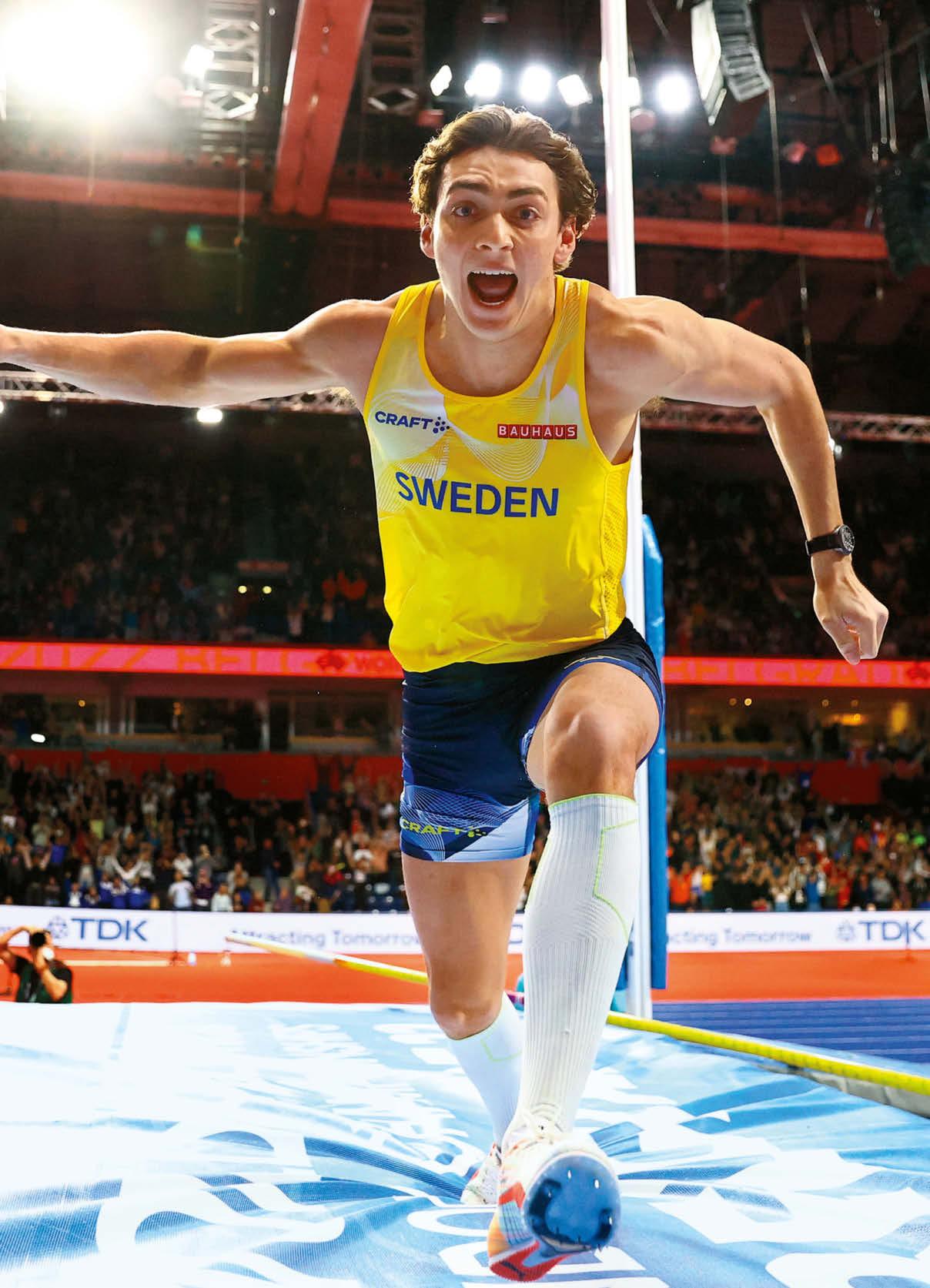
NEW HEIGHTS
Getty Images
Still, Mondo insists, he has plenty of unfnished business. He believes that more records and titles are in reach. And he’s excited to be ramping up for a trip to Paris in July. “In some ways, it feels like this is going to be my frst trip to the Games,” he says, explaining how competing and performing during the pandemic didn’t deliver the full Olympic experience. “No one was there to watch so it didn’t feel complete. This time it’s going to be huge. So I have a lot of fre and motivation going into this one.”
If you spend time with Mondo Duplantis, you start to see how his historic accomplishments, as well as the admiration he gets from fans, cannot be fully explained by his preternatural speed or his lifelong devotion to technical excellence. It’s deeper than his talent or work ethic or consistent performance. There’s something about his mindset and personality, something unassuming and pure, that gives him an air of transcendence. While so many of the best athletes in the world have a singlemindedness about their pursuit of greatness, Duplantis is on an unmistakable and unyielding quest for balance. Even now, frmly in the conversation as the best of all time, he’s still out there trying to have fun.
“I know some athletes are crazy structured but I think being flexible works better for me,” he says, referring to his approach to both workouts and life. “Mentally, I need to live my life like I’m free and not in a box.” Duplantis trains like a beast and exudes world-class competitive fre, but the truth is he’s the farthest thing from a single-minded robot. He’s comfortable talking about the technical subcomponents of his event, but he seems more excited to discuss his passion for hip-hop and golf and how much he loves hanging out with his family, his girlfriend and his circle of friends on two continents. He acknowledges that eating clean is part of his daily routine, but he also concedes he’ll eat a chocolate bar or a burger if he really feels the urge. “I don’t want my life to only be absorbed with my pole vaulting all the time,” he says. “For me to perform at the highest level, I also need to have balance.
Whether he’s sitting down for a long interview or performing in a Diamond League meet, Duplantis smiles and laughs a lot. That’s what he does when asked if he runs through a mental checklist as he’s soaring higher than any other human in history. “No, the truth is that my brain is on autopilot once I’m up in the air,” he admits. “All the real work and planning was put in long before that. And honestly, once I feel the impact of the pole in the box, I pretty much know if the jump’s going to be successful or not.”
Duplantis has a habit of making the nuances of athletic greatness sound uncomplicated. “For me, the best way of learning has always been visualization,” he says, moving on to offer one of the least pretentious explanations of the technique ever uttered by a world champion. “I basically just close my eyes and I try to picture myself just going over the bar. It’s pretty simple. I think if you can’t visualize yourself doing what you want to do, then it’s going to be pretty tough for it to actually happen. I feel like it makes me a pretty optimistic person in general, both in sport and the rest of my life.”
And when asked if he feels enormous pressure to beat his own world record, with fans and reporters expecting the boundaries of physics to be shattered every time he competes, Duplantis shrugs, refusing to frame his mindset in a complicated way. “I really don’t think of the next height as a world record,” he says. “I just think about it as a personal best, something I’ve done so many times just by getting a little bit better. I try not to make things bigger than they need to be.”
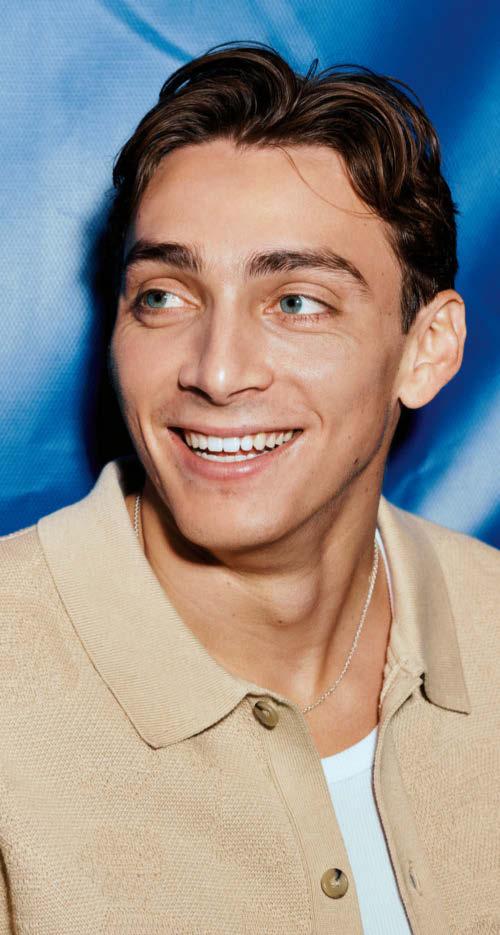
Duplantis, who says he feels “joy and a rush of craziness” as he’s celebrating world records and important wins, is as easygoing off the track as he’s locked in on it.
MONDO DUPLANTIS
THE RED BULLETIN 93
But don’t be fooled by the easygoing, humanistic way he approaches his daily life. “When I’m competing in the pole vault, something happens inside of me,” he says with a sly smile. “I basically turn into a different person.”
This story fittingly should end with Duplantis once again leveled up into hyperfocused mode and sailing through airspace. This time it’s in bright afternoon sunshine on a Wednesday in September. He’s back at Hayward Field in Eugene, at the Prefontaine Classic, the fnal Diamond League meet of the 2023 season. Once again, every other pole vaulter in the competition is done for the day, and Mondo stands alone with a sellout crowd thrumming.
The bar is raised to 6.23 meters (20 feet, 5¼ inches), a mark that would represent yet another world record if he can clear it.
Duplantis tears down the runway and plants his pole, bending the stiff fberglass like an overcooked noodle. He will admit later that he intentionally went with a slightly shorter pole than usual, which is perhaps easier to bend but requires a bit more fnesse to “squeeze over the bar.” The clearance is tight—his left shin grazes the crossbar lightly—but he deftly hinges his torso and then his arms over the wobbling bar. In a close-up replay, TV viewers can see Mondo’s face as he sets his seventh career world record—at frst one of open-mouthed anticipation that melts into ecstasy.
He’s done it. Once again, he’s leapt higher than anyone else ever has leapt. It’s a singular achievement, but he’s hardly alone. The crowd has erupted. And Mondo sprints from the mat to the edge of the track. First he embraces some of his fellow elite pole vaulters, men that Duplantis considers friends. “It’s a brotherhood with all us vaulters,” he says in Stockholm. “We’re all just trying to be the best versions of ourselves—and we see it more as a competition against the bar than against each other.”
After hugging it out with the brotherhood, Duplantis steps to the edge of the track and embraces his entire family. He’ll say later that he can’t remember having the whole Duplantis clan present for a big competition since he was a junior. It’s light years away from Tokyo, where he set a new world standard in an empty stadium, an ocean away from his family.
Mondo bear hugs his dad frst. Then he’s enveloped by his mom, who tenderly pats him on the back. Then it’s on to his brothers, his uncle, even one of his nieces. It’s clear how much these relationships mean to him, how they fuel his quest for excellence.
After he’s done celebrating with his friends and family and fellow jumpers, he gallops down the edge of the track, giving strangers extremely hard high fves, shouting with joy at a stadium full of fans projecting joy back at him.
“When I land a big jump, I feel a lot of excitement and joy and a rush of craziness,” he’ll tell me later. “If everything’s right when I’m jumping, I feel this immense level of control of my body and what I’m doing. It’s a weird feeling, and I cherish it because I know I’m never going to have that feeling again once I stop jumping.”
Ten minutes after breaking the world record yet again, Duplantis remains on the track, still dishing out high fves and jumping with joy.
“I don’t think of the next height as a world record. I just need to get a little better.
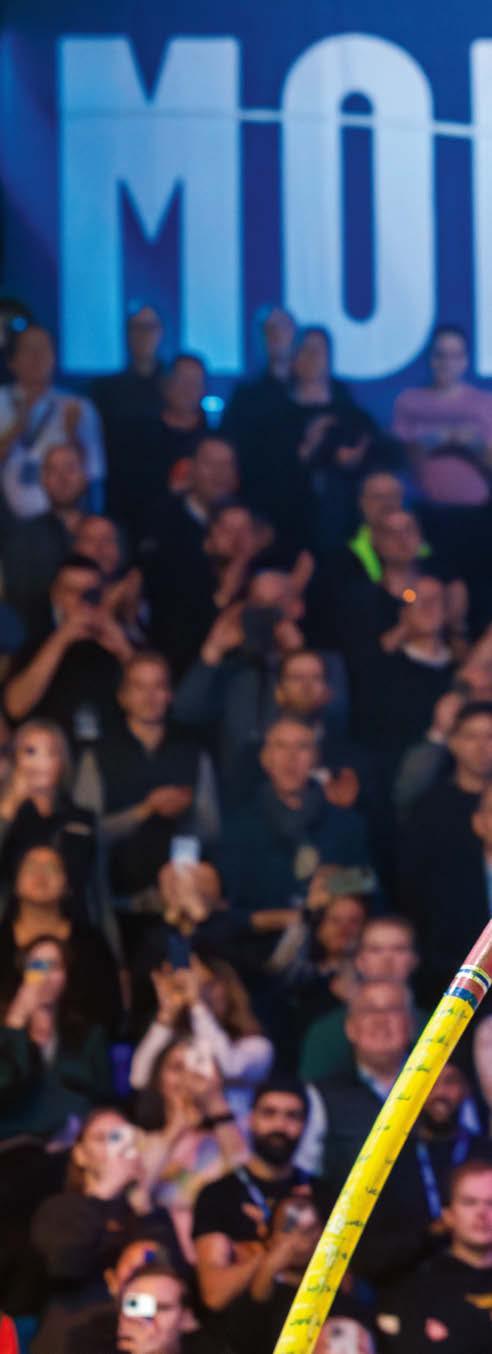
NEW HEIGHTS
94 THE RED BULLETIN Richard Ström/Red Bull Content Pool
better. I don’t make things bigger than they need to be.”

competes at the
this past February. Two months later, he broke the world record for the eighth time, clearing 6.24 meters at the
MONDO DUPLANTIS
Duplantis
Mondo Classic
Diamond League opener in China.
THE RED BULLETIN 95
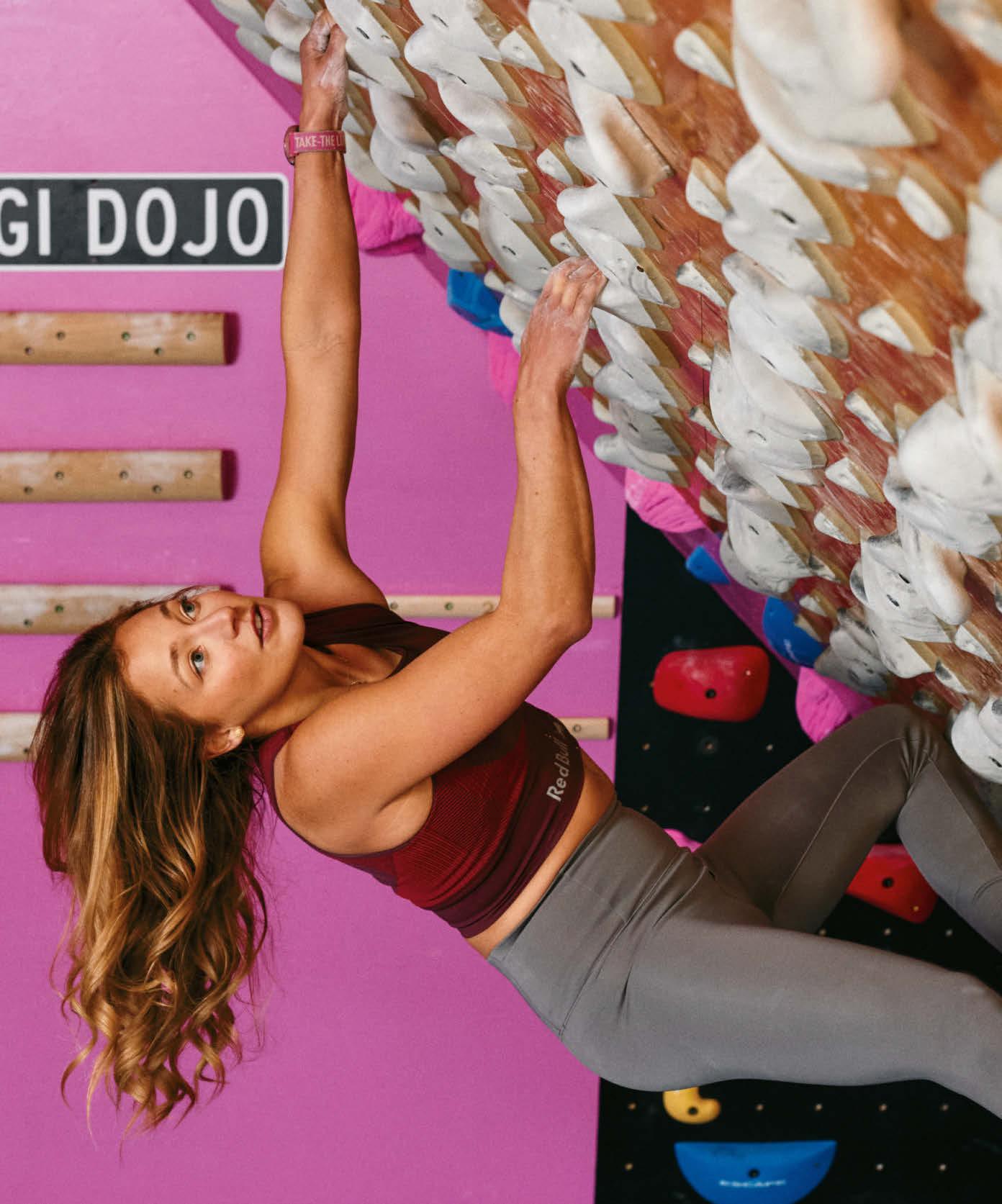
NEW HEIGHTS
THE CONSEQUENCES OF THE CLIMB
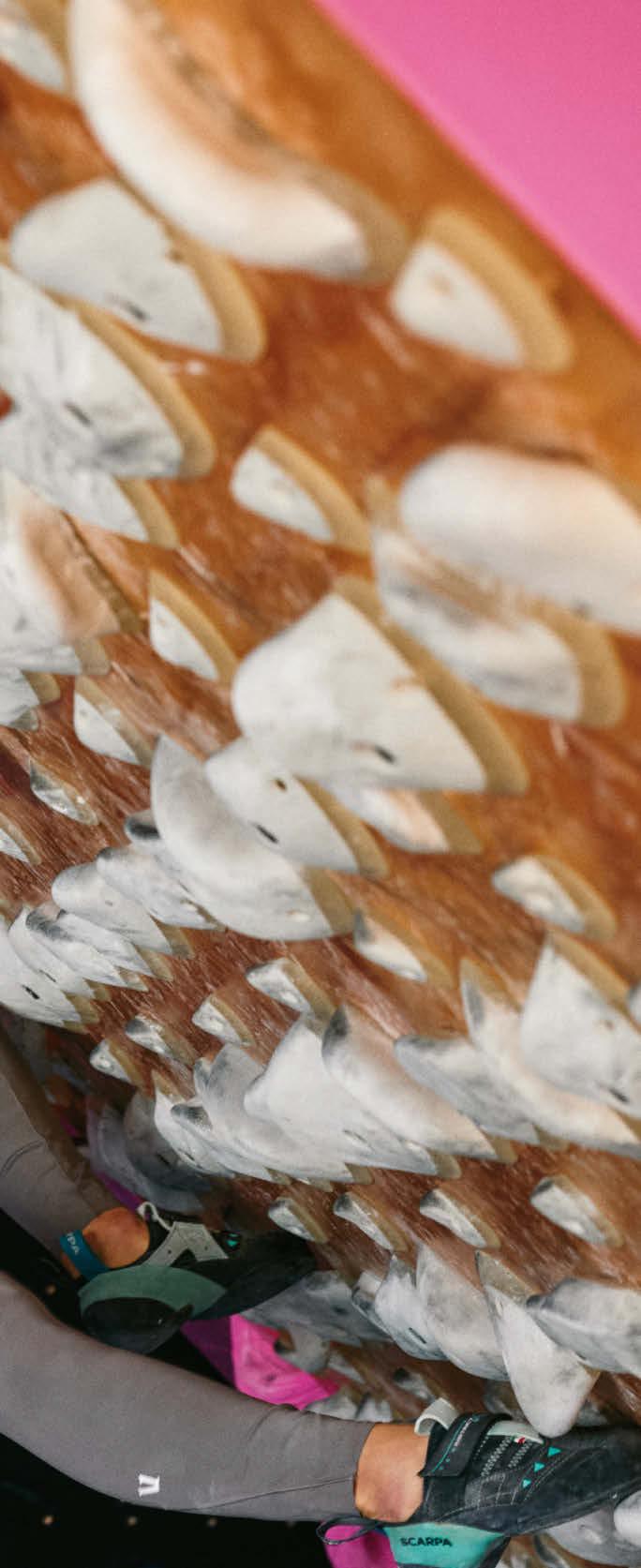
Over the past two decades, Sasha DiGiulian has established herself as one of America’s best-known female professional climbers. But the limelight can be isolating. With a revealing new film looming, the at-times polarizing athlete opens up about the prizes and perils of being unapologetically yourself.
SASHA DIGIULIAN
THE RED BULLETIN 97
WORDS BY GLORIA LIU PHOTOS BY GREG MIONSKE

Let’s start with the little girl.
She was almost 7 years old. It was her brother’s birthday party, and they were at a rock-climbing gym. The gym smelled like stinky feet and pizza. When it was finally her turn to climb, she scampered all the way to the top, pushed off the wall and dangled in the air high off the ground. She looked down. She felt happy.
While her brother’s friends ate cake and ice cream that day, the little girl kept climbing. Eventually, she started competing. At competitions around the Washington, D.C., area, where she grew up, she was not like the other kids, goofing off and socializing. She acted like an adult going to work, a local coach noted. “She was there to win.”
And she won a lot. At age 12, she started attracting sponsorships. She was business-minded as a teen, even writing herself a mission statement. Her sponsorships were small, but she was proud of them because they meant she was a real climber. Things were still simple then. She was the hometown sweetheart. Everyone liked it when she won.
Her house feels secluded, partly hidden by a curving driveway, which peels off a winding mountain road above Boulder, Colorado. She owns four acres of this hillside, including the towering sandstone rock formation that casts shade on the prairie grass and prickly pine. She owns the custom-wrapped pink Tesla in the driveway, too. The little girl who loved climbing grew up, and so did her sponsorships.
Sasha DiGiulian’s home gym, playfully called the “Digi Dojo,” features various programmable walls, including a pinkframed Treadwall that rotates like a treadmill and a Kilter Board with a 45-degree overhang and LED lights that allow her to set thousands of routes. It also sometimes features MooseChaga, her Bernedoodle.
This is the home of Sasha DiGiulian, 31, perhaps one of the most famed female professional climbers of her time. She has nearly half a million fans on Instagram. She’s a three-time national champion and two-time world champion. She was the first North American woman to climb a 5.14d (9a), then one of the hardest sport climbs achieved by a woman. She has more than 30 first female ascents.
But DiGiulian’s significance extends well beyond her athletic achievements. She was among the earliest climbers to recognize and harness the power of social media, and she’s attracted mainstream interest and sponsorships to a historically niche sport. Adidas signed her at 17. Red Bull signed her in college as its first American climber. She co-designed the rock climber in the rock-climber emoji. She’s appeared in advertisements for makeup, tires, Seamless food delivery and even lingerie (for a campaign that aimed to present strength and femininity as being fundamentally compatible, a stance that DiGiulian champions).
She’s also caught a fair amount of shade. Her polarizing nature is central to a new film, Here to Climb, about her career, and her comeback from an injury that nearly ended it. In the film’s opening scenes, members of the climbing community, including free soloist Alex Honnold, recount some of the criticisms and outright abuse that have been levied at DiGiulian: that she’s sexualized the sport, that she’s dumb and anorexic, that she presents a highly curated public persona. “Sasha’s story is amazing,” Honnold says. “That’s why it’s so frustrating when she overhypes some ascents.”
But at the moment, it’s hard to square the image of the polarizing, narrative-controlling influencer with the unassuming
“Sasha chose climbing,” says a friend,
NEW HEIGHTS
98 THE RED BULLETIN
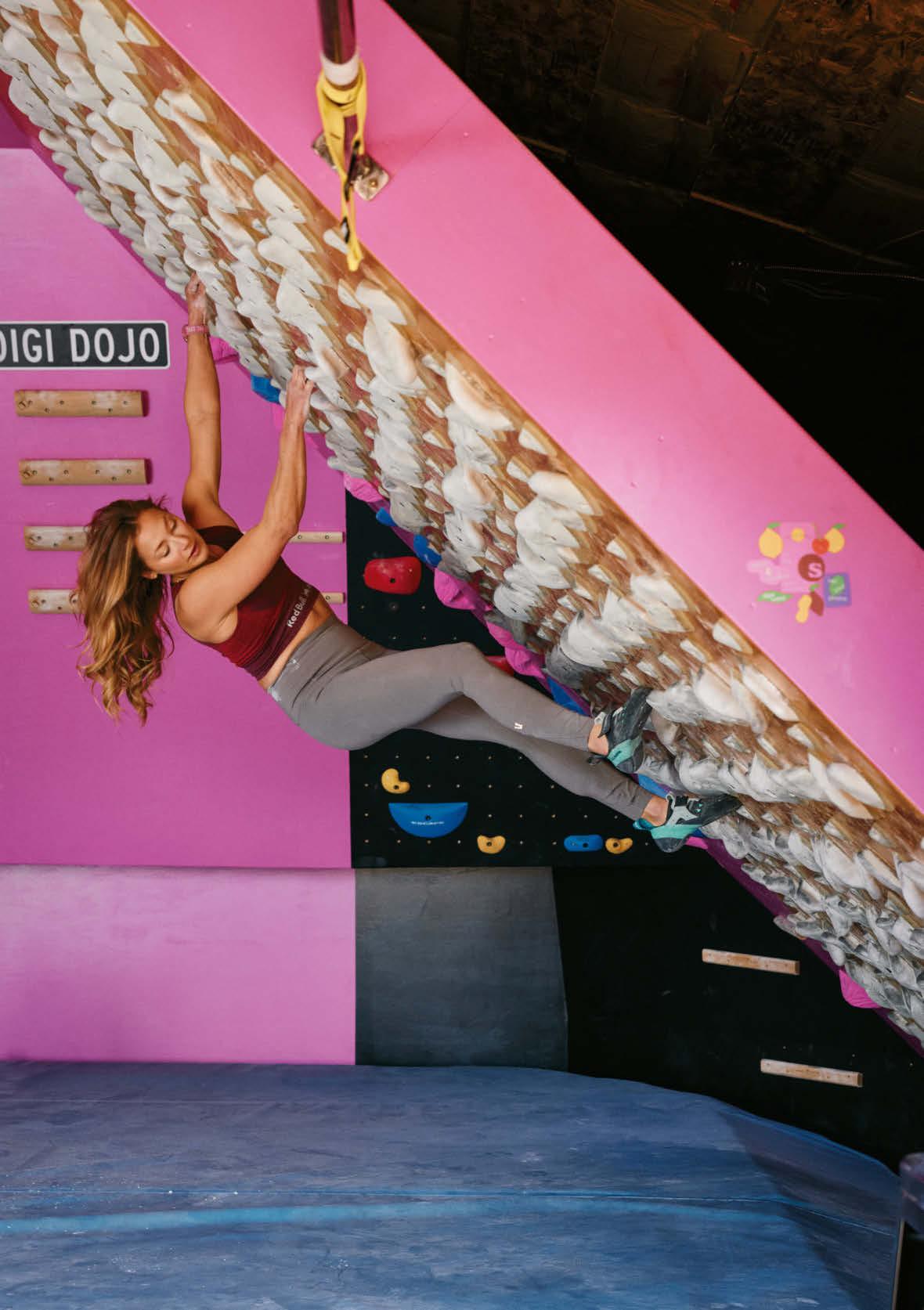
“because she loves climbing.”
SASHA DIGIULIAN
5-foot-2 athlete who’s showing me around her house. “We have a pigeon problem,” DiGiulian tells me, waving at some milky streaks below the rafters over her deck. She wears climbing pants, goldstudded earrings, a shirt smudged with chalk and a Coros fitness watch with a special-edition pink Coros x Sasha wristband that reads take the lead, the title of the memoir she published last fall. Our plan for the morning, hammered out by my editor and her manager, had been for me to accompany her while she trained in her personal climbing gym. But when I arrived, she asked if I just wanted to go for a hike instead. “I feel like it would be easier for us to talk,” she said, tilting her head with a smile.
On our way out, I ask for a tour of the Digi Dojo anyway—that’s what DiGiulian calls her gym—and she gamely demonstrates the workings of the various programmable walls for which the shecave is named: a pink-framed Treadwall, which rotates like a treadmill and is tilted at a 35-degree overhang; a Kilter Board, with a 45-degree overhang and LED lights that allow DiGiulian to set thousands of routes; and a similarly LED-lit MoonBoard with a 40-degree overhang. Boulder has no shortage of climbing gyms, but here, away from the distractions and the scene, DiGiulian can focus. She can have her coaches or other pros over to session uninterrupted.
“But honestly,” she adds, “a lot of the time I’m here alone.”
The girl was by nature independent, a trait sometimes at odds with a sport that requires a partner. When she was 7, her mother learned to belay her so she could climb lap after lap. She went to college even though other pro climbers told her she’d be wasting her prime athletic years. At Columbia University, where she studied creative nonfiction writing and business, she was the only one she knew who attended classes during the week and jetted off internationally for climbs or sponsor obligations on weekends. It wasn’t easy juggling professional climbing and a college education, but she wanted to prove that you could do both.
Though her parents were loving and supportive, she was on her own financially, too. She had to pay her Ivy League tuition with her climbing earnings, so she said yes to every opportunity. Saying yes to one thing often led to another, and soon she was bopping between fundraising galas and the crag, photo shoots and the gym. She wore makeup and pink nail polish on the wall; she climbed in a pink sports bra. She enjoyed being both feminine and athletic—again, she wanted to prove that a woman didn’t have to choose.
By now she had racked up some impressive climbing feats outdoors, including first ascents and first female ascents. She was featured in magazines and on TV. But as her profile rose, so too did the chatter. She didn’t yet know not to read the comments: about her body, her lifestyle, about whether she was a real climber. Some of the comments, especially about her weight, were cruel. She spent more time than she’d like “anguishing,” as she puts it in the film, over what people thought of her.
In 2015, the summer before her senior year, she attempted a bigwall climb on the 13,000-foot Eiger, a mountain in the Swiss Alps. The route lay on the mountain’s deadly north face, nicknamed the “murder wall” for the 60-plus lives it had claimed. On the wall, a male climber working another route told her, “I don’t know if little girls belong on the Eiger.” Then the sky unleashed rain, hail and snow. She and her partner were forced to retreat.
She felt immense pressure to finish. Traditionally, climbers slipped away for their objectives, emerging triumphant only at the end with photo and video evidence. But for the Eiger, she had done a Skype call with NBC from her bivvy and sent regular dispatches provided to ABC. She had an audience. With time running out, she and her partner diverted to an easier, drier route that had also never been climbed by a woman. She got to the top, and when she returned home, her phone blew up with requests from reporters eager to talk to the American woman who had conquered the “murder wall.” She was embarrassed, not sure the climb warranted the hubbub, but she still said yes, again, to the opportunities. There were so few, fleeting moments when the mainstream media paid attention to her sport.
The reporters didn’t understand climbing, and some used the wrong language, which made her achievement sound bigger than it was. This made other climbers angry. They said she overhyped her climb. But she says she didn’t make the claim—the media did. It didn’t matter. “People were ready to pounce,” says her friend, Kati Hetrick, a former professional climber and filmmaker. “They wanted to poke holes in her approach to climbing, and this was an opportunity to do it.”
In 2018, trouble found her again. She got into a public tiff with a popular male professional climber who, according to her, had bullied her for years. This time, he posted a photo making fun of her body on a private Instagram account shared with other pros. She called him and asked him to take it down; he blocked her. She outed him online; he lost his sponsorships. The community chose sides. Some people supported her. Others she considered friends disappeared. She was heartbroken, but she compartmentalized. She kept climbing.
In early 2020, she was aiming for a first female ascent of a bigwall sport climb in Mexico called Logical Progression. Her hips had been hurting, so she went to the doctor. He told her she had hip dysplasia and would need five surgeries—urgently—to repair both sides. Worse, he didn’t know if she would return to the level she was climbing at. It was two weeks before her big climb. Her doctor agreed she could start the surgeries when she returned.
But the night before she left, she got a phone call. A member of her film crew had fallen and died on route while rigging ropes for the cameras. She still flew to Mexico, reeling with shock and guilt, but now the trip was a rescue and body-recovery mission. Days after she returned in March 2020, the world shut down for the pandemic.
Her five surgeries began in May 2020. During the two reconstructive procedures the doctors cut out her lower
NEW HEIGHTS 100 THE RED BULLETIN
“The naysayers will always be around, always coming from a place of fear or competition.”
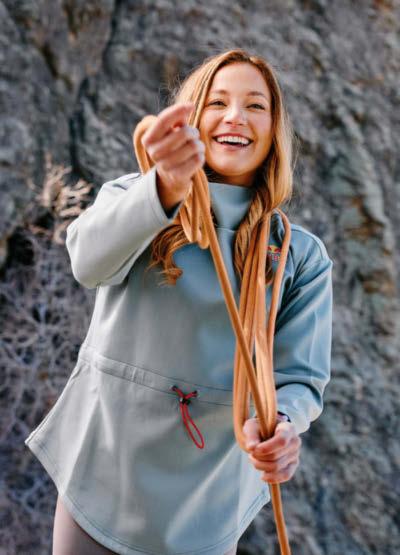


SASHA DIGIULIAN
Near her home in Boulder, Colorado, DiGiulian, 31, fnds respite hiking among the sandstone formations, prairie grass and prickly pine.
THE RED BULLETIN 101
“I don’t think climbing rocks will ever fully satisfy my desire to do something positive in the world.”

NEW HEIGHTS
“Can you really make a difference as an athlete?” DiGiulian asks. “But at least success in athletics gives you a platform to get welcomed in the door. And then you have to know what you’re talking about.”
abdominal muscles in order to break and reassemble her pelvic bone in multiple places. For 10 months she got cut open, stitched back together, recovered, went in, got cut open again. In between, she did PT, she crutched around, she started writing a book. She kept busy. But without climbing—without the daily opportunities to feel strong and competent; without the ability to set goals, work toward goals, achieve goals—she lost touch with the feeling of success, she says. She lost touch with part of who she was.
DiGiulian and I pick our way up a rocky ridge trail, enjoying the sunshine and its dry, uncomplicated warmth. Her moppy blackand-brown Bernedoodle, MooseChaga, trots behind us. The climber and her husband, film producer and director Erik Osterholm, got the pup a few years ago, marking a shift in their priorities. The surgeries and the pandemic had forced DiGiulian to stop traveling, and she enjoyed her newfound sense of community and groundedness. Osterholm warned her that a dog would change their ability to travel, but she told him she was ready.
Still: she’s on the road a lot. (The couple has great dog sitters.) She just got home a couple days ago from a trip that included speaking to the UN and meeting with Vice President Kamala Harris, and she’s about to head out for another travel block that includes training for a new project in Yosemite as well as a trade show for her nutrition-bar company, Send Bars, which she and her co-founder launched in 2022.
DiGiulian has always been brainy (“what do you think AI will do to journalism?” she asks me) and was raised to value education and other traditional measures of success (“you went to Berkeley, right?” she asks at the start of our hike). As a teenager, her role models were never pure climbers. She deeply admired those like Lynn Hill, who was the first person, man or woman, to free climb the Nose on Yosemite’s El Capitan in 1993, famously quipping afterward, “It goes, boys.” DiGiulian hung a poster of Hill with the quote on her bedroom wall, and today Hill is a friend who plays a prominent role in DiGiulian’s film. But the athletes DiGiulian really wanted to emulate were those like Maria Sharapova and Serena Williams, women who wielded influence beyond the court. “I didn’t see many climbers transcending sport or really crushing it in the business space,” she says.
Perhaps because she grew up outside of D.C.—one of the family’s neighbors was then-governor, now-senator Mark Warner—she’s also gravitated toward advocacy work. Since 2016, she’s lobbied on Capitol Hill with the nonprofit Access Fund for legislation that protects public lands, and she works with the climate action group Protect Our Winters. Actually, today, she tells me, a bipartisan bill she testified for in Congress, called the EXPLORE Act, was passed by the House.
“I don’t think climbing rocks will ever fully satisfy my desire to do something positive for the world,” DiGiulian says, as we walk
the trail back toward her home, our feet crunching on the dirt. “It’s been more like, how can I use the influence that I have from climbing to effect positive change?”
“And even that feels vapid,” she continues, seemingly aware this might sound rote. “Can you really make a difference as an athlete? But at least success in athletics gives you a platform to get welcomed in the door. And then you have to actually know what you’re talking about.”
In a sport that can be described as monomaniacal, DiGiulian has broadened the definition of what it means to be a professional climber. “I think Sasha will be remembered as one of the most important climbers of her generation,” former Climbing magazine editor-in-chief Shannon Davis tells me, citing the difficulty of the grades that she climbs, the variety of disciplines she’s excelled at and the longevity of her career. But, he says, “where I think she’s really helped push the sport is just helping us think of climbers as a whole person.”
Every sport has its rules and traditions. Climbing originated in 19th-century England before it was brought to California’s Sierra Nevada in the 1930s, and many of its ideals were established during this time, historian Joseph E. Taylor III, tells me. Victorianera climbers believed that accepting money as an athlete tainted sport: “Only the amateur possessed pure motives,” Taylor writes in his book, Pilgrims of the Vertical: Yosemite Rock Climbers and Nature at Risk. Later, 1960s Yosemite gave rise to dirtbags, climbers who left school and worked odd jobs to climb full-time and achieve peak performance. “You live this life of monastic poverty,” Taylor says of the dirtbag ethos. “You dumpster dive, you scrounge, you shoplift . . . you do what you have to do because it’s the only way to advance yourself.”
While male climbers have certainly had to balance supporting themselves financially and not being seen as a sellout, as a woman, DiGiulian’s glossier presentation and lucrative sponsorships might attract more criticism in a sport where, as Taylor says, there was also “a strain of misogyny from the beginning.” Early English climbers extolled masculinity and did not see most women as real climbers, he tells me. “They established the conceits we still struggle with today.”
Not only is DiGiulian not a man, she also never tried to be “one of the guys.” She looks and acts traditionally feminine, she’s an advocate for women’s sports, and she’s spoken out about the toxic effects of body dysmorphia among female athletes. She didn’t just laugh it off and “let boys be boys” when the pro male climber bodyshamed her on Instagram. She still believes she did the right thing in standing up for herself and says other women told her they’d been bullied by the same person. But confronting the boys’ club takes its toll: The fallout from the experience, and the resulting sense of alienation from her community, she says, was traumatic.
SASHA DIGIULIAN
THE RED BULLETIN 103
“How many times am I going to do

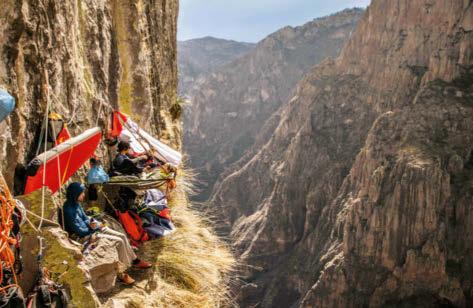

Even some of the most widely respected women climbers dealt with sexism. Lynn Hill, for example, earned undeniable cred for both her talent and years spent at Yosemite’s Camp 4. But she was still paid less than a less-accomplished male counterpart by a mutual sponsor; men also said she had an advantage on the Nose thanks to her small fingers. Had Hill ever heard a man’s first ascent attributed to his unique physical advantage? “Never heard of such a thing,” she tells me.
In the film, Hill explains that the climbing culture she grew up in prized self-effacement and humility: You didn’t talk about what you did; you let other people talk about it. It’s perhaps irked some climbers, then, to see DiGiulian promote herself unabashedly. But many male climbers didn’t have to promote themselves, Hetrick says. “If a guy did something, everyone in the core community talked about it, and sponsorships percolated from there.”
Meanwhile, she says, “I watched many women work hard and accomplish incredible first ascents or podiums and think the telephone was going to ring, and it just never did.” Even Hill says that her first free ascent on the Nose was not fully recognized for the achievement it was until no one was able to repeat the feat for 12 more years. By then, she had become a mother and was no longer prioritizing climbing in the same way.
DiGiulian suggests that the criticism may also spring from runof-the-mill jealousy. “I think a lot of the scrutiny that I’ve faced in my career is like, why is Sasha making this money and I’m not?” she says, as we walk back up her driveway. But haters aren’t just people who are jealous of what you have, I muse. They’re people who believe you don’t deserve what you have.
DiGiulian agrees, and the thought strikes a nerve. “Because as a female athlete you’re like, how many times am I going to do something to prove that I deserve it?” she says. “It’s this never-
ending uphill battle.” Her recent experiences, especially the social media kerfuffle and her surgeries, have taught her that trying to prove your worth to people who are determined not to see it is like pouring yourself down the drain. “The athlete in me will always want to prove more and more,” she says. “But at the end of the day I’m just so grateful I can move and be fully functioning again, and it puts things in perspective.”
These days, she has a much lower tolerance for fake friendships, and she tries to surround herself with people who are genuinely supportive. And she stays off Reddit, she says, with a wry smile. It still gets to her, though. “It’s impossible to say I’m not affected,” she admits.
It can be exhausting, being a certain kind of woman in this world. But you can’t fight every troll. You can’t win every heart. So you pull your circle tighter. You stop reading the comments. And you become further acquainted with the sound of your own voice.
Just four months after her final surgery, in June 2021, DiGiulian returned to Mexico to tackle Logical Progression. As Here to Climb documents, despite being less fit or prepared than she’d ever been before a climb, DiGiulian claimed the first female free ascent of the 3,000-foot, 5.13 (7c+) route.
But her real comeback, in her eyes, took place the following September, on a 2,000-foot, 5.14b (8c) route in Spain’s Picos de Europa mountain range, called Rayu. This time, DiGiulian wanted to free what would be the hardest big wall climbed by an all-women’s team. She recruited Brette Harrington, a North Face climber with a deep alpine-climbing resume; and Matilda Söderlund, an old friend and Swedish pro who had climbed 5.14d.
NEW HEIGHTS
104 THE RED BULLETIN
In 2021, DiGiulian surmounted the route called Logical Progression, a 3,000-foot, 5.13 ascent on a wall in Chihuahua, Mexico, appropriately called El Gigante. The huge adventure, captured up close in the flm Here to Climb, was a triumphant conclusion to several challenging years for DiGiulian.
something to prove that I deserve it?”

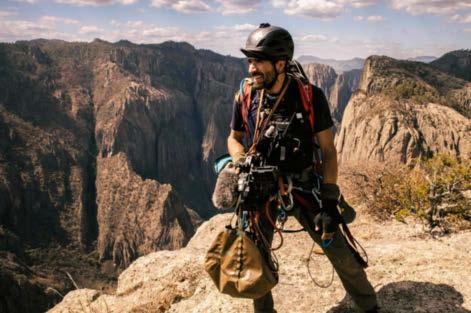
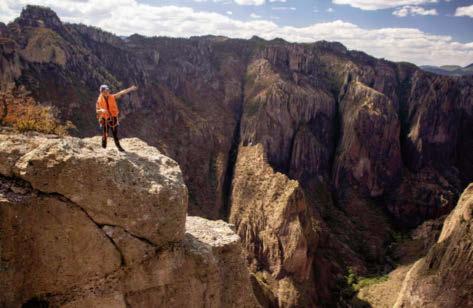
After two and a half weeks of sessioning various sections of the adventurous big wall, the women were ready to attempt the climb from bottom to top. On the second day, Söderlund sent the 5.14b crux, and the trio could have moved forward to claim the team ascent. But DiGiulian was determined to send the crux too: It would be the same grade as the hardest section of big-wall she’d climbed before her surgeries.
As DiGiulian describes it in an essay for Outside, over the next day and a half, she and Harrington attempted to free the section. The limestone was covered in sharp crystals, and their fingers left blood on the holds. A storm was coming in. On their fourth day, she took her last shot before the team had to push on.
A short film, Rayu, captures DiGiulian’s climb through the final section of the crux. Her fingers are bleeding so profusely she can’t use her right index finger. Söderlund and Harrington encourage her from below. “Everything you’ve got,” Söderlund calls. DiGiulian exhales, swinging a tan arm overhead to crimp three fingertips over a barely discernible ripple of rock. “Hold it!” Harrington shouts.
The wind whistles. “BAAAT!” DiGiulian yells and pastes herself against the blank gray face. She tiptoes leftward on invisible undulations. “BAAAT!” she shouts again. She hooks her left foot, pulling leftward once more. One more reach for the final hold. Now she’s standing upright at the anchor. “FUUUCK YEAH!” she hollers, pumping her fist in the air. “WOOOO!” she screams, her voice cracking with elation.
During my Zoom interview with Kati Hetrick, I show her this clip and ask for her reaction. I think she might say something about DiGiulian’s style or strengths. Instead, she tells me, smiling, “I’m just reminded how much Sasha loves climbing.” Some people have a perception that DiGiulian is in it for the wrong reasons, she
says—that she’s in it for the money. If DiGiulian just wanted to make money, Hetrick points out, there are a lot of other ways for her to do it.
“She chose climbing,” she says. “And she chose climbing because she loves climbing.”
She is 31 years old now, but on the wall, you can still see the little girl she was. When she falls off and cries out in frustration: “She tries so hard,” Hill says. When she reaches the anchor and howls in elation: “Outside climbing, she’s at her happiest,” Hetrick says.
But of course she is no longer a child. She has traversed the passage from girlhood to womanhood, one that includes the dawning realization that the world celebrates your wins when you are small and nonthreatening but questions your worthiness as your windfalls grow. It involves the hard lesson that sometimes you do have to choose—between speaking out or fitting in; between being humble or being seen. Try to please everyone and you’ll lose yourself. Stand up for yourself and you might lose almost everyone.
The choice isn’t easy, but she’s made the same one again and again. “The naysayers,” DiGiulian writes in her book, “will always be around, always coming from a place of fear or competition.” Climbing in the way that only she can has gained her a rare vantage point, a height from which just a handful of human beings will ever get to see the world. She’s shed some blood on the way up. But what a view it is.

be available to stream on Max.
SASHA DIGIULIAN
Here to Climb, an HBO sports documentary from Red Bull Media House, debuts Tuesday, June 18 at 9:00 p.m. ET/PT on HBO and will
THE RED BULLETIN 105 Pablo Durana

When a rare total eclipse crossed North America, a team of pilots and photographers set out to capture an impossible shot.

NEW HEIGHTS
WORDS BY NORA O’DONNELL PHOTOS BY DUSTIN SNIPES AND MASON MASHON

CHASING DARKNESS 107
A fantastic celestial event inspired a talented crew of artists—both in the sky and on the ground—to dream up a once-in-a-lifetime photo shoot on April 8, 2024.
There’s something we’re forgetting. There’s always something. Is it big?
Is it small? Is it going to
wreck the project?
The night before the total eclipse, Luke Aikins struggled to sleep. He didn’t expect that. After all, death-defying stunts were second nature for the renowned skydiver and pilot. This is the guy who set a world record in 2016 when he jumped from a plane at 25,000 feet—without a parachute—and landed safely on a net. And he knew that the upcoming stunt was extremely unlikely to put anyone’s life at risk, especially not his. As a member of the Red Bull Air Force, Aikins had the job of guiding aerobatic pilots Kevin Coleman and Pete McLeod from the ground, and yet, as he lay awake in bed, he felt … stressed? What are we missing? he wondered.
For months, a team of pilots, photographers and specialized crew members had been preparing to do the unthinkable. On April 8, when the solar eclipse reached totality, Coleman and McLeod would fly in the path of the sun while photographers on the ground attempted to capture two planes—and the celestial event—aligned precisely in the same frame. Experts told them it was a crazy idea. There were too many variables that must line up perfectly in a matter of not seconds but milliseconds. Still, they were going to try.
“It’s so fun to be able to have this new problem,” says the Los Angeles–based sports photographer Dustin Snipes, who’s known for crafting inventions for challenging projects. “When I’m trying to think of a problem and dissect it, I end up making things, because it helps my brain relax. It’s sort of like my shower thoughts.”
“Doctor Dustin,” teases Mason Mashon, another photographer on the project, who spent hundreds of hours troubleshooting with Snipes. Indeed, Snipes’ enthusiasm gives off a hint of a younger Doc Brown, the fictional, time-traveling scientist from Back to the Future. To help himself problemsolve, Snipes constructed various contraptions, including a set of triggers using arcade-like buttons and a handmade walnut box.
Mashon, an adventure photographer based in British Columbia, admits he has a very different approach. “I feel like Dustin is very methodical, and I’m more, ‘Let’s just try it and figure it out.’ ”
“I think everyone’s first reaction was laughter,” adds Canadian photographer and popular YouTuber Peter McKinnon, who also joined the project early on. “The laughter quickly subsided to posing the question: ‘Wait, are you serious?!’ ”

not only an eclipse but two planes fying at 180 miles per hour.
First, they went to work on the calculations. Snipes reached out to the United States Naval Observatory and aerospace manufacturer Blue Origin to confirm astronomical details. Meanwhile, Aikins pondered how to get two planes to fly through the path of the sun.
Four weeks before the eclipse, the entire team met in Shreveport, Louisiana, where Coleman has an airstrip, to do a test run. Using a pole, a rope and a weight, Aikins and McLeod created a makeshift sundial, which cast shadows on the ground that created a line through the middle of the sun. If Aikins could guide Coleman and McLeod to fly along the string line using a radio, compass and GPS coordinates, then they’d be in perfect alignment with the sun for the shot.
Or so they thought. “You’d think a degree would be perfect,” Aikins says, referring to the coordinates. “But the sun moves a quarter of a degree every minute. It was literally a game of inches. They would move a foot in the air, which is hard to do, and it would change our view dramatically on the ground.”
After a series of practices, Aikins was able to fine-tune his guidance until they got it right, but even then, they still had
NEW HEIGHTS
Opposite page, top: Red Bull aerobatic pilots American Kevin Coleman (left) and Canadian Pete McLeod (right) were up for the challenge. Below: With solar flters affxed to their cameras, a team of photographers prepare to capture
108 THE RED BULLETIN

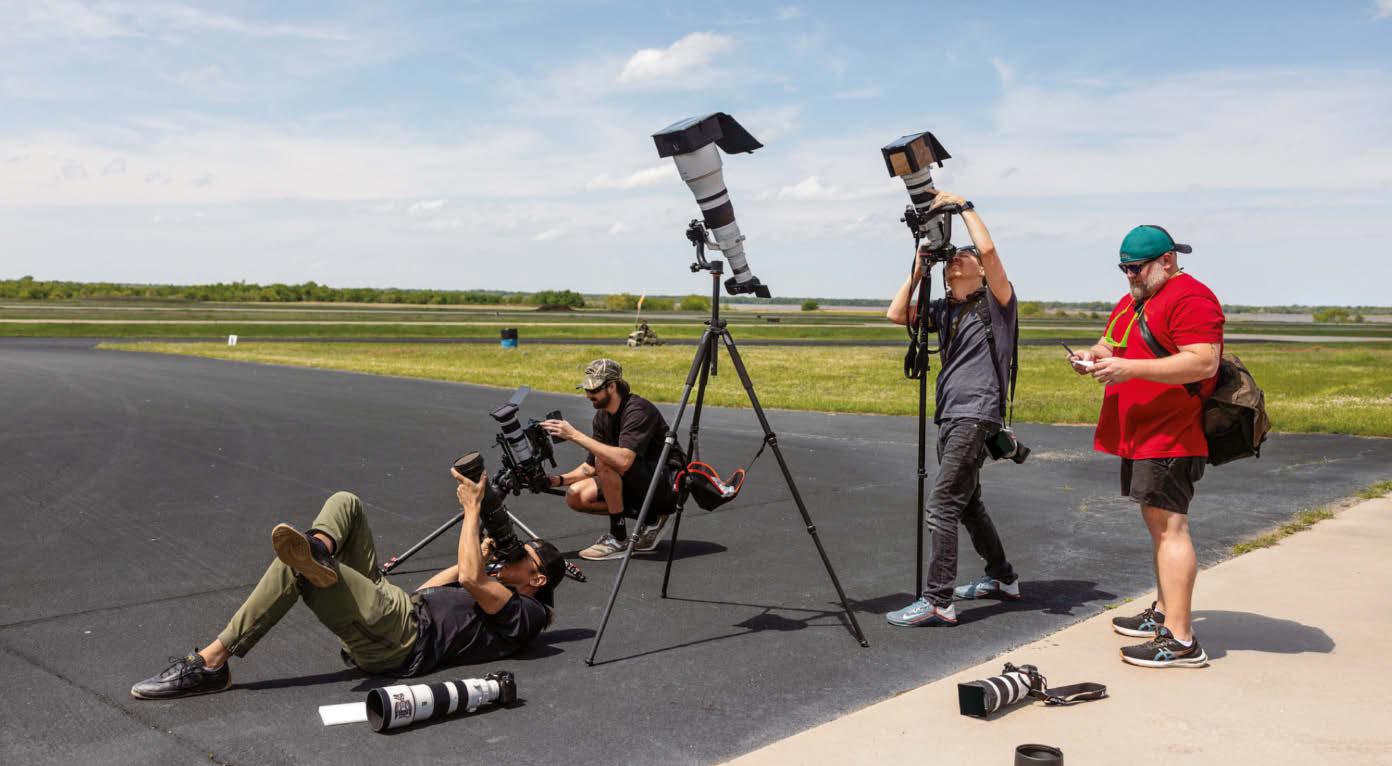
CHASING DARKNESS
Kerrigan
Colin


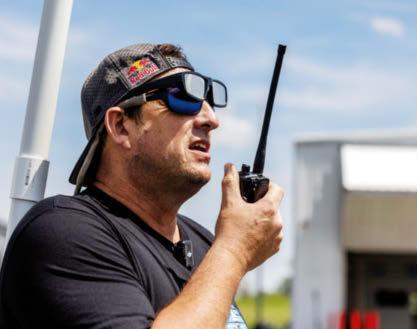
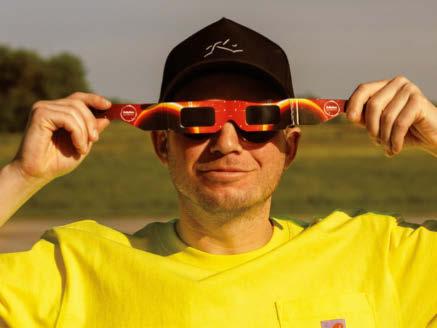

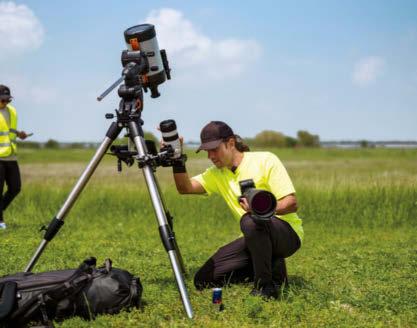
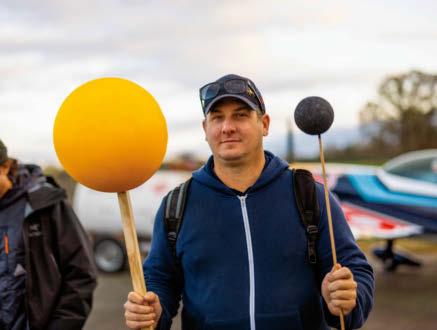

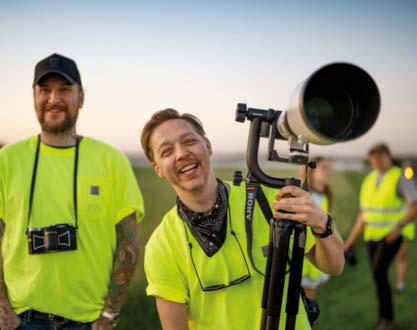
The many scenes of preparation and the crew that made it possible.
Top row: Pilot Pete McLeod and aviation expert Luke Aikins (holding a radio). Second row: A protective gear demonstration during a test run in Shreveport, Louisiana; photographer Mason Mashon with his tripod. Third row: An important eclipse simulation; photographers Dustin Snipes and Mashon test lighting on the wing; Peter McKinnon (in hat) and Snipes have a chuckle. Fourth row: Aikins tests the sundial while pilot Kevin Coleman readies for takeoff.

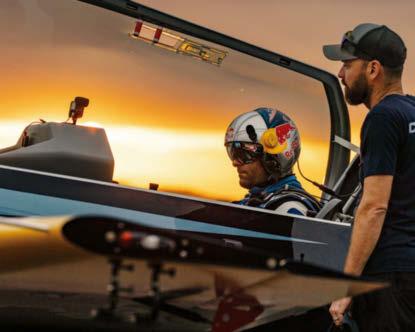
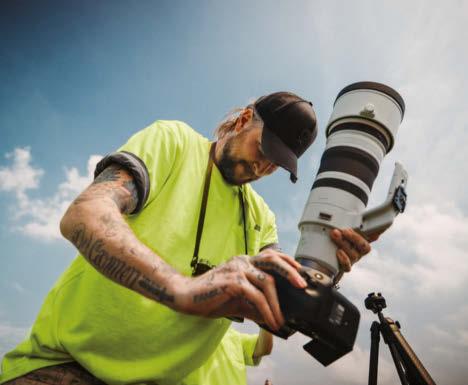
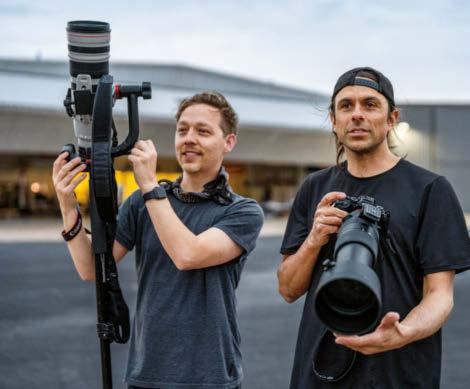

concerns about the location. In Shreveport, the eclipse would reach only 98 percent coverage. Mashon, who’s used to dealing with tight windows in high-stakes situations, predicted there would be less than a minute to get the shot. “So I studied the totality map, and bam!—Sulphur Springs,” says Mashon.
He’s talking about Sulphur Springs, Texas, which sat in the middle of the path of totality, meaning the full eclipse would last more than four minutes. As a bonus, the town also had a small municipal airport. “I pushed for the location,” Mashon continues. “If we could get into that center line of the path of totality, that would improve our chances. We needed every last second to make it so.”
A week before the eclipse, Aikins tested the lighting near his home on Puget Sound in Washington state. During an eclipse, experts told him, the level of light in the sky would approximate “civil twilight,” a scientific term for the moment soon after sunset when the sun is six degrees below the horizon. “We were afraid we wouldn’t even get a silhouette of a plane,” Aikins says. “We didn’t know how dark it was going to get.”
Aikins mounted some modified mountain bike lights made by Outbound Lighting on the wings of his plane and had his wife and son snap images with an
iPhone from the ground. If Snipes and Mashon could adjust the lights to get just the right exposure, it could work.
When the team reunited in Sulphur Springs, Snipes and Mashon made microadjustments to the lighting until they could get it as close as possible to perfect. Then, on the morning of the eclipse, they woke up to the ultimate project killer: fog. “You couldn’t see anything,” says Mashon. About an hour before the onset of totality, the sky was still cloudy, but the sun shone through just enough for them to proceed.
As the pilots got set for the first of three passes, Aikins stood next to his sundial with a radio in hand. When the eclipse reached totality at 1:43 p.m., the shadows from his sundial completely disappeared.
“Pure darkness,” McKinnon recalls. “The crickets came out and all you could hear was the crackle over Luke’s radio.”
Suddenly, Aikins had no way to steer the planes along the string line. On the first pass, the planes missed their mark and Aikins started to sweat. Then they missed again. By the third and final pass, the planes came close but not enough. Snipes yelled a colorful expletive. Aikins radioed to Coleman and McLeod to hurry so they could get one more pass.
On the ground, McKinnon, Snipes and Mashon maximized their coverage. McKinnon took his camera off the tripod
and moved about 35 feet to the right of where Aikins stood. Pilots Coleman and McLeod got into formation, flying only four feet apart from each other. With mere seconds left of totality, a shining diamond of sunlight escaped from behind the moon—just enough light to guide the planes across the sun.
Click! Click! Click! Click! Click!
Miraculously, all three photographers captured the planes and the eclipse in the same frame, each shot different but equally beautiful. “I guess that’s what makes it art, right?” Aikins muses.
“It was a team effort, all the way,” stresses Snipes.
“I may never get another opportunity to do something this awesome,” McKinnon says. “A career highlight.”
“Honestly, this was one of the most stressful shoots I’ve ever worked on,” Mashon admits. “And I work in some pretty intense environments where I’m, like, positioned on the knife edge of the cliff.”
Aikins, the accomplished daredevil, echoes that sentiment. “This was unlike any project I’ve ever done,” he admits.
“When I jumped out of that plane without a parachute, I had full control of whether I was gonna live or die. But this had more intensity for me, because no one had complete control. Every person had to do their job at exactly the same moment.”
CHASING DARKNESS
The photographers brought some of their favorite gear to get the shot. From left: Peter McKinnon with his Canon EOS R3 camera and 100-300 mm lens; Dustin Snipes’ main rig was a Canon EOS R5 with 600 mm f4 lens; Mason Mashon’s arsenal included three different Sony cameras (models A1 and A9III) and a variety of lenses.
THE RED BULLETIN 111 Colin Kerrigan (5)

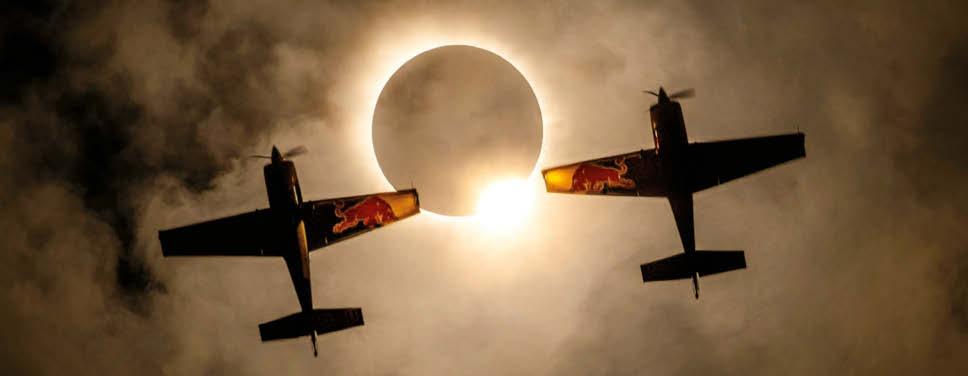
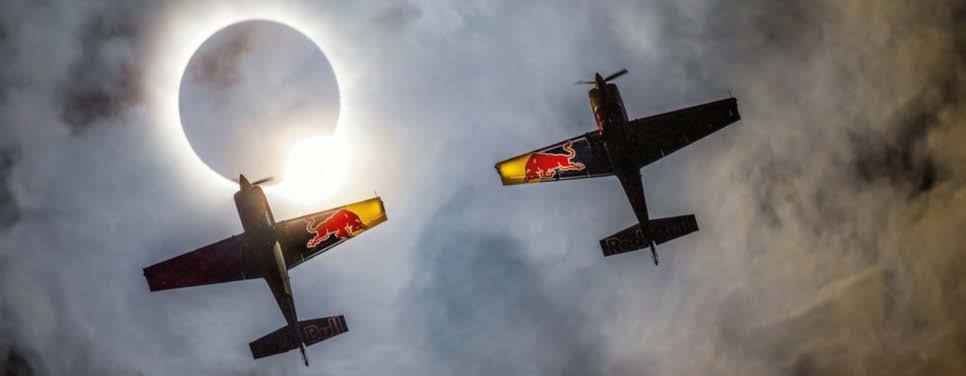
NEW HEIGHTS CHASING DARKNESS
112 THE RED BULLETIN
One moment, three incredible images: Pilots Kevin Coleman and Pete McLeod few at 180 miles per hour in formation just four feet apart and 1,500 feet above ground, while photographers Mason Mashon (top), Peter McKinnon (middle) and Dustin Snipes (bottom) quickly captured the planes and the eclipse from the ground in Sulphur Springs, Texas.

RS THE CREATORS THE CREATORS THE CREATORS
THE CREATORS THE CREATORS THE CREATORS THE CREATORS THE CREATORSCREATORS
ATORS CREATORS THE
Celebrating the genius of innovative content makers
2024 ISSUE 2 THE RED BULLETIN QUARTERLY
116
Ludwig
124
Patrick Cloud 126
Gear
THE RED BULLETIN 115
AthomewithLudwigAhgren,thewannabelate-nighttalk show host turned YouTube icon.
THE CREATORS
116 THE RED BULLETIN
WORDS BY SHEILA YASMIN MARIKAR PHOTOS BY MARÍA JOSÉ GOVEA

LUDWIG
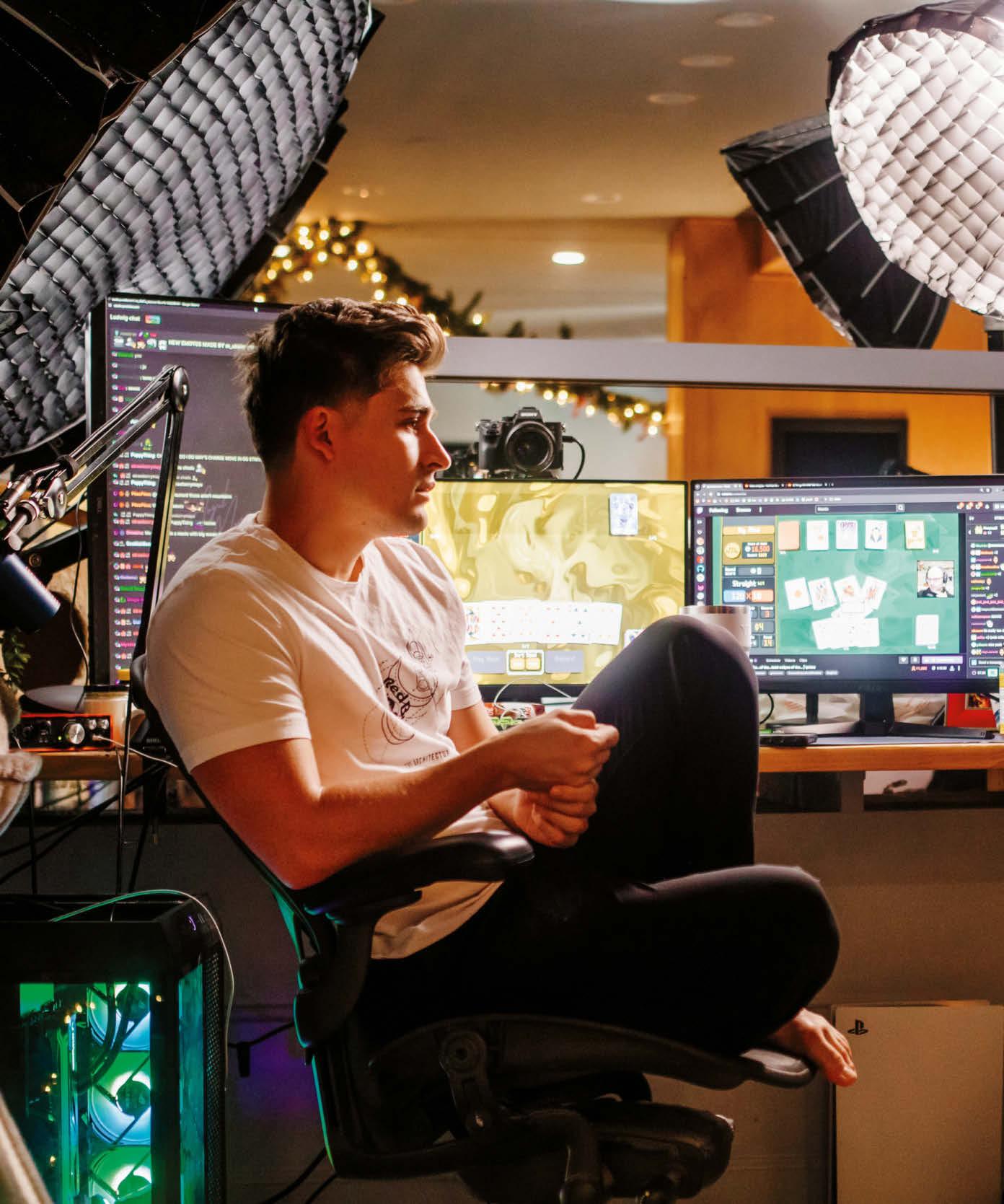
THE CREATORS

When Ludwig Ahgren was 16 years old, he met Jay Leno. Ahgren was a guest at his sister’s graduation from Emerson College in Massachusetts, and Leno was the marquee speaker. A connoisseur of Conan O’Brien and The Colbert Report, Ahgren fancied himself a future late-night star. He had the opportunity to meet Leno. He took it.
“I was full of ego,” he recalls while seated at a rolling desk chair on a subterranean floor of his Los Angeles home on a Monday in April. He’s wearing a white T-shirt, black sweatpants and no shoes (or, for that matter, socks); the luminescence of three monitors and two studio lights casts his face in an incandescent glow.
“I came up to him and said, ‘Hey Jay, I’m gonna be a late-night talk show host,’ ” Ahgren goes on. Leno humored him, asked for his name. Their conversation ended there, and Ahgren went on to matriculate at Arizona State University, where he majored in journalism. “I thought it was the closest thing to talk show host,” he says. “I never became that, but I guess now I’m something kind of close.”
To put it mildly. With 5.8 million subscribers, Ahgren, 28, who goes by the handle Ludwig online, is one of the most popular streamers on YouTube. Ahgren came up on the Super Smash Bros. circuit around 2019, livestreaming hundreds (thousands?) of hours of gameplay to an ever-increasing following on Twitch. By 2020, he had picked up over a million followers, largely by branching out and collaborating with other prominent creators. While streaming may still be his bread and butter—he calls his workspace his “stream center”—these days, he’s thinking bigger. Wilder. Like a precocious talent whose ascent, despite the heights it’s already reached, has only just begun.
“I was at a meeting recently where we were talking about how blockbusters are usually the right gamble,” he says. “Basically, why it’s worth it to forgo 10 smaller streams and put more eggs into one basket for a higher concept,” such as Unpaid Intern, a comedy series he recently launched that’s like The Office minus every iota of HR. “I’d rather put my time and energy into what might be a blockbuster than another stream where I’m just staring at my computer. I’d rather take a gamble.”
“I’d rather put my time and energy into what might be a blockbuster. I’d rather take a gamble.”
LUDWIG
THE RED BULLETIN 119
Seated here at the “stream center” in his home in Los Angeles, Ludwig, 28, has livestreamed countless hours of content to his millions of subscribers on YouTube. These days, he’s thinking even bigger.

“Ludwig has this inhuman energy to nail takes and make the whole crew laugh.”
To back up, Ahgren did not always have designs on the big time. Growing up in New Hampshire, he played video games “like any kid does—for fun,” he says. “After you do your homework, for however long your mom will let you.” Given his namesake, his mother thought he might play the piano. Can he? “I wouldn’t say that’s a fair assessment,” he says. He proved more proficient at consuming television, and though he knew what he wanted to be when he grew up, college, initially, was a challenge.
“I think that if you’re not doing some kind of extracurricular activity, you’re wasting your time in college,” he says. “The degree doesn’t always net you something, unless you’re like, a STEM major, in which case, go off and make $100K. That’s dope. But if you’re getting a journalism degree? That’s not what happens.” [Ed. note: Again, to put it mildly.] “So I was like, ‘OK, what are my extracurriculars?’ And then I tried joining a bunch of shit.”
First came the sailing club. “I quit because it cost $4K a semester,” he says. “Like, no way.” Next, acapella. “I didn’t get a call back.” Then, a comedy club. “They didn’t choose me.” Eventually, he found a new comedy club that was just starting up, called Tempe Late Night. He was one of its first members.
At this point in the retelling, Ders, one of the cats who cohabitates with Ahgren and his girlfriend, a streamer known as QTCinderella—they have two, plus a dog—wanders in. Ders is a Scottish Fold who commands a room like Rihanna. For some, it is impossible to look away from Ders. Ahgren is able to nonchalantly scratch her back and carry on.
One day at a Tempe Late Night meetup, Ahgren noticed a poster on the wall advertising an upcoming meeting of a Super Smash Bros. Club. He went. He began attending weekly tournaments. It was his first foray into competitive gaming, but as graduation
THE CREATORS
loomed, so did the reality of the real world and its attendant obligations. He focused first on location. “I figured it would be good to go to either New York or L.A.,” he says. “Because those are places you should go, I think. Not for any specific reason.”
He applied to 300 jobs in both cities and got one interview in Los Angeles. He rented a Toyota Camry, stuffed his belongings into it and drove to L.A., where he slept on his sister’s couch. He got the job, “web editor” of a wine and spirits magazine, and has lived in L.A. ever since.
He can’t remember the name of the magazine. “I got fired after six weeks,” he says. An HTML formatting flub was to blame; in what sounds like a page ripped from an Unpaid Intern script (not that there are scripts), he incorrectly identified a major funder of the magazine in a photo caption, and she called for his head. “It was a total accident,” he says. “Frankly, I was out of my depth doing HTML formatting. I should be doing Squarespace at most.”

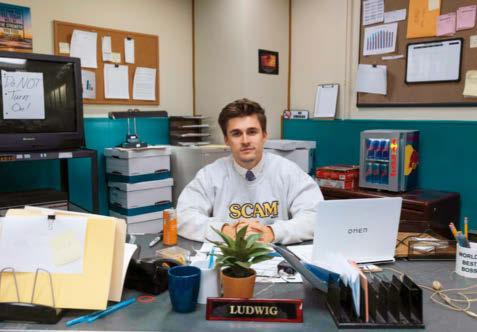
After that there were jobs at Best Buy (“the largest one west of the Mississippi, in terms of sales volume,” he says, “and number of thefts, which seem to go hand in hand”), Snapchat (where he got let go “not because I was bad at my job—although I wasn’t great at it—but because they were spending haphazardly”) and a “Chinese vape company that made vapes that looked like the old iPod Shuffles,” he says. “I don’t know who their market was. I assume it was children.” All the while, he kept streaming on the side, building up his base of fans and collaborators.
He served as the vape company’s head of marketing, and his “huge pitch” to them hinged on his friendship with the YouTuber FaZe Banks, who had verbally committed to being the spokesperson for a subscription program “where you reduce the amount of nicotine in your vape cartridge every month until eventually you’re vaping no nicotine at all,” Ahgren says. “FaZe had been vaping for a while and he wanted to quit.” According to Ahgren, the CEO rejected his


As part of his efforts to think bigger, Ahgren recently launched a new comedy series called Unpaid Intern on YouTube. “Ludwig is really good at putting himself in front of any audience,” says his fellow streamer and friend Nick V. “I think it’s a huge part of why he’s such a good performer. He can quickly identify if something is a good or bad idea, or if something could be improved.”
LUDWIG
THE RED BULLETIN 121
Colin Kerrigan
pitch because he was worried that the company’s vapes weren’t good enough. The promotion would lead to increased product scrutiny that could beget bad publicity. Game over. “I was a lame duck once that happened,” Ahgren says. He collected a paycheck until he was fired in February 2019.
By that point, he was making about $2,500 a month streaming. “I had about $7,000 in my savings account,” he recalls. “I figured I can probably go for six months without having to get a real job. If it works in six months, ‘hell yeah,’ if not, I’ll find another job. That’s OK, too.”
“I lied about it, though,” he says. “Online, I said I quit to go full time.”
It’s the better story, and Ahgren is nothing if not a storyteller. He exudes the affability of a huckster meets the boy next door; stick a microphone in his face and the showman comes to life. And yet it never feels like he’s trying too hard. “It’s important to be yourself and be authentic,” he says of his onscreen persona. “But at the same time, you’re putting on a damn show, right? You should be more entertaining than you would be if you were in a bubble bath at 10 p.m.”
“I always had this mantra,” he adds. “You should stream to one viewer as you would to 10,000. If you’re not giving that one person all you have to offer, why are they going to sit around and why are new people going to join?”
He mastered the art of bringing new fans on board in the spring of 2021, when he embarked on a “subathon” that ended up lasting 732 hours. Lest you imagine Ahgren as a Dr. Evil–esque mastermind, stroking Ders in his lap as he thinks up ever more twisted ways to gin up his subscription base, know that the impetus for the subathon was quite simple. His appendix burst.
“I was bedridden for two weeks,” he says. “I couldn’t stream, and it’s weird to not stream for that long. It’s very uncommon.”
When he felt ready to get back in the saddle (or the rolling desk chair), he wanted to make up for lost time. “I saw that people were doing subathons,” in which every new subscription makes the livestream last a little longer. “I figured I’d go maybe a week. The only way it would hit a month is if it broke the record for the most subscribers ever, which I didn’t think was possible at the start of it, but then it happened.”
“Then it happened” is one way to describe Ahgren’s swift and powerful rise . There is something about the ease with which he speaks, in three dimensions as well as two, that makes his success seem inevitable. There’s his news-anchor-perfect swoop of hair—“it’s how most people recognize me,” he says; “if I’m wearing a hat, I get approached a lot less”—his movie-star smile, his
seeming lack of body fat in an industry that tends to like its onscreen talent that way.
But to chalk it up to “then it happened” would be to oversimplify his appeal.
“Ludwig is unique because he is a machine that interprets content and spits out all the parts of it that he admires, creating a grotesque, ghoulish, yet strangely sincere and beautiful version of how he sees the world,” says Slime, a streamer who came up with Ahgren in the Super Smash Bros. circuit. They’ve collaborated many times. “What keeps me coming back is that I’ve never, ever seen a camera turn on and him not turn on with it, you know?” Slime says.
“He has this inhuman energy to nail takes and make the whole crew laugh for eight hours straight, or us, or anyone watching. It truly is the one thing I admire about him the most.”
Nick V, another Super Smash Bros. friend, concurs. “Ludwig is really good at putting himself in the shoes of an audience,” he says. “I think it’s a huge part of why he is such a good performer. He can quickly identify if something is a good or bad idea, or if something could be improved, purely by understanding whether or not an audience is likely to respond well to it.”
One thing Ahgren’s audience responded particularly well to: his invitation to spend a $10,000 decor budget for his stream space across Amazon. This is why, behind his rolling desk chair, there are “some things that might not make conventional sense,” Ahgren says, like the popcorn machine filled with plastic yellow ducks and a regal 6-foot-tall pirate statue that alone cost $2,000. His audience also picked out the banner that now graces the wall behind a cat tree frequented by Ders—a portrait of Ronald Reagan with a misattributed quote: “Drunk cigs don’t count.”
(It’s a meme.)
Some touches are Ahgren’s own. The signed Tom Brady jersey. The laundry-strewn air mattress on which he sleeps during certain livestreams. (“The weirdest part is when you’re waking up,” he says.
“When you’re sleeping, you’re just sleeping.”) The collection of vitamins and supplements on his desk, a stash worthy of a GNC shelf—fish oil, creatine, magnesium, D3.
“You’d be hard-pressed to find someone who streams who’s getting enough D3,” he says.
In the manufactured darkness of his stream space—he keeps the blinds drawn, to keep the lighting consistent—Ahgren has found a way of letting people into his life while entertaining them, often late at night. Maybe Leno remembers his name. Maybe he doesn’t. Maybe it doesn’t matter.
“I realized, at a certain point, a while back, that I don’t even watch late-night talk shows,” he says. “I find them a bit dated. So then I was like, maybe I should try to become something else.”
THE
CREATORS
122 THE RED BULLETIN

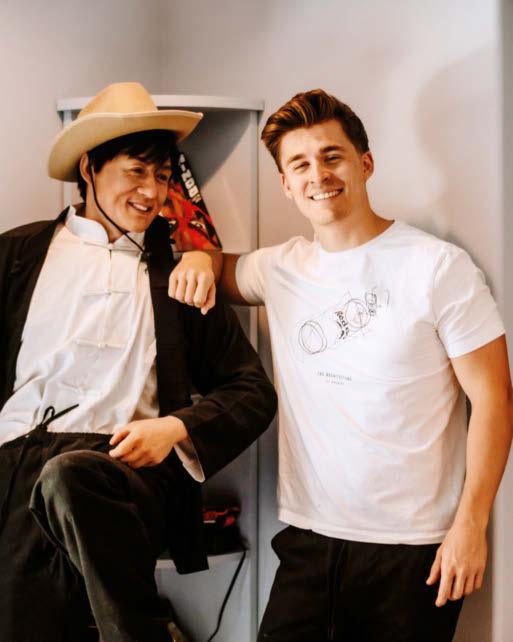
Ludwig invited his fans to spend a $10,000 decor budget for his stream space across Amazon, which is why it’s flled with yellow plastic ducks, among other things. Some touches are his own, though, like a life-size Jackie Chan statue and a signed Tom Brady jersey.
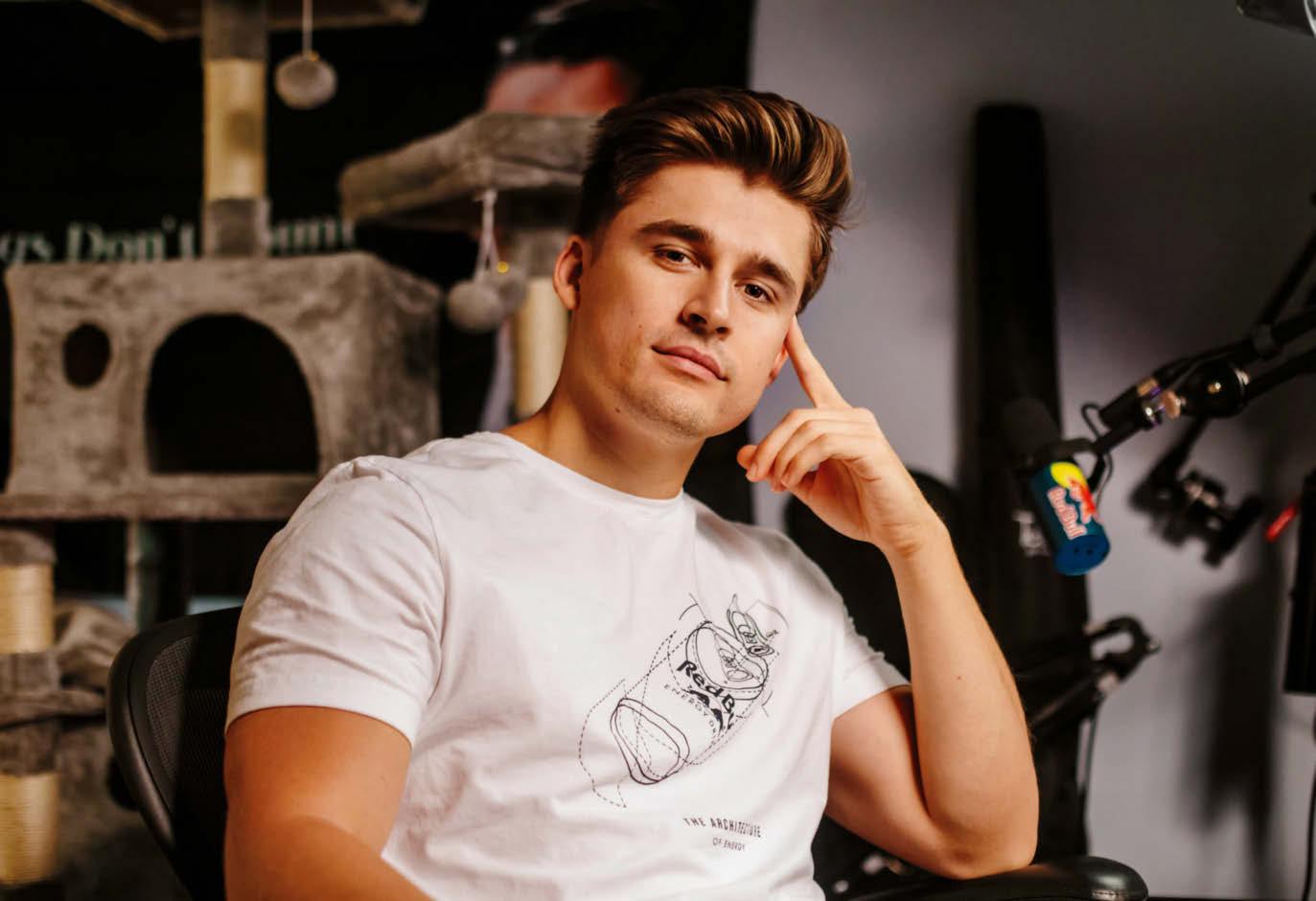
LUDWIG
BEATS, RHYMES AND LIFE
Get to know Patrick Cloud, the multihyphenate talent and host of Red Bull Rap IQ.
BY WILL LAVIN
Hip-hop’s impact on the world is undeniable. Celebrating its 50th anniversary last year, the culture collectively raised a glass to honor its achievements, while fans, artists and industry insiders shared stories of how the global phenomenon changed their lives. One person who was hugely impacted by hip-hop is Red Bull Rap IQ host Patrick Cloud.
Born and raised in Los Angeles, the 34-year-old musician, gamer and YouTube personality—whose real name is Patrick Houston—started out as an aspiring rapper and producer before discovering he had a talent for creating content and hosting videos, which eventually led to a gig as creative director at All Def, one of the internet’s largest Black-owned digital platforms—a perfect ft for Cloud, with its focus on hip-hop, comedy and social justice.
Last year, Cloud was tapped to ask the questions on Red Bull Rap IQ, the game show where rappers and basketball players go headto-head as they fex their hip-hop knowledge— and even the host gets stumped sometimes.
The Red Bulletin recently got a chance to visit Cloud on the set of the freewheeling series. During a break from shooting, he joined us in the green room to talk about about his music career, how J Dilla sparked his love afair with hip-hop and who his favorite Rap IQ guests have been so far.
As a musician, YouTube personality, gamer and creative director, Patrick Cloud is uniquely qualifed to host Red Bull Rap IQ.

Conversation
THE CREATORS The
124 THE RED BULLETIN Bran’dee Allen

1 When did you frst fall in love with hip-hop?
There’s a couple of moments, but none more so than the frst time I heard “Waves” by J Dilla. The way he chopped that [10cc] sample still baffes me. It made me wanna produce and rap. It made me wanna do everything all at once.
2 Then you actually did go on to rap. How did that come about?
It was thanks to my best friends Lonnie and Cecil. I met Lonnie at a party when he was just stood by himself rapping in the corner. I had just fallen in love with hip-hop, so I went right over to him and we instantly bonded. They had a rap group and I told them I wanted to be a part of it. They gave me all these CDs full of beats because they produce, too, and I wrote to every single beat, and I got in because of my work ethic.
3 You also produce. What inspired that move?
I played football for like one year at Hamilton High, but I was tiny. I remember getting hit so hard that I was like, ‘What’s a piano look like?’ They literally knocked the art into me. There was this electronic-music class where you could learn how to produce, but you had to take a year of piano frst. So in 11th grade I took piano and then my senior year I was able to join the class.
4 Are there plans to drop any new music soon?
For a while I was dropping an album a year, but I took a break for a few years because I started producing for other people and then there was the period after COVID began, which was just a weird time. I just kind of creatively died for a little bit. But I recently got back in the studio and am working on some new stuff.
5 How would you best describe to someone what it is you do? I consider myself a musician and a gamer. Am I a YouTuber? Sure. But if I have to put something on a résumé it’ll be creative director.
6 As host of Rap IQ, what’s your most memorable episode? It would probably be the NLE Choppa and Duke Deuce episode. They’re just so funny! They knew each other, which is super important because a lot of times when you have two big talents that aren’t really familiar with each other, they might be a little standoffsh. But they were completely themselves. We had moments where they were dancing, and they were imitating other rappers within the charades part. It was a very wild day.
7 Do you have a wish list of artists you’d like on the show? Someone like Lil Yachty would be good, as he’d bring the numbers and could be really funny on the show. I feel like Lizzo would be hilarious. Also, Megan Thee Stallion—her personality would be great.”
8 Ending with rap’s big question: Who’s in your Top 5 list of MCs? I have to preface this by saying I appreciate everyone’s Top 5. My personal list is a balance of how good they are, how much I like them and how much I listened to them growing up. Five is Lupe Fiasco. Four is MF DOOM. I gotta give three to Ol’ Dirty Bastard. Two doesn’t really exist, but it’s [Madlib’s animated side project] Quasimoto. Then number one is A Tribe Called Quest— and that one’s non-negotiable.”

TRACKS




ESSENTIAL SOUNDS
As host of Red Bull Rap IQ, Patrick Cloud has met many of hip-hop’s top stars. Here, he breaks down some of the best tracks by his favorite guests.
BUDDY
“Real Life S**t” (2018)
“I was super surprised when I frst heard Buddy. As a Compton artist, I expected him to sound a certain way. I had no idea he was so soulful. I feel that’s what happens when people meet me—they think I’ll be a certain way but then they’re usually pleasantly surprised.”
SMINO (FEAT. BARI)
“Flea Flicka” (2017)
“I have always loved rapper-producers who can form their own sound, but I learned much later that it’s also a skill to pick great beats. The production on this record is addictive but very strange, and I like to think it’s very refective of my personality—he’s strange, but I like it.”
KAMAIYAH
“Come Back” (2016)
“Kamaiyah has such a unique favor to her. This track reminds me of Oakland. I’ve only been there less than 10 times but I’m a huge fan of their culture. It’s also another tie-in to my personality, as I don’t get turnt up all that much. It’s a smooth anthem but it still knocks.”
DUKE DEUCE (FEAT. LIL KEED)
“Busy” (2021)
“When Duke Deuce dropped this I was like, ‘Yes, fnally!’ It’s so fun. What he’s talking about on this song sums up my life, ‘No, I can’t answer my phone, I’m busy.’ That could be for women I don’t have time for or friends and family I’m struggling to carve time out for.”
THE RED BULLETIN 125
Red Bull Rap IQ streams on the Red Bull 1520 YouTube channel. Scan here to catch up on the latest episodes.
PRECIOUS METALS
Three shining high-tech reminders that you don’t have to be a worldclass athlete to strive for gold, silver and bronze.
Bang & Olufsen Beoplay HX
Don’t be fooled by the opulent, carefully calibrated bling of these wireless headphones. No doubt, the pristine white fnish with gold accents makes an unsubtle visual statement, but when you want to lose yourself in your favorite tracks, you’ll surely be struck by the masterfully coherent sound—with crisp treble and punchy bass and detailed midrange. Elegantly designed physical controls on each earcup allow you to adjust volume, noise cancellation and Bluetooth settings; beyond that a wider suite of functions can be controlled on the B&O app. No one will buy these with price performance as a priority, but the acoustic quality and industrial design are simply golden.

ACTIVE LIFESTYLE Gear
BANG & OLUFSEN BEOPLAY HX $600; BANG-OLUFSEN.COM
Leica M11-P
This level of luxury is rarely this discreet. But with a throwback silver-chrome fnish—and an unexpected no-logo design—this update to the M11 oozes subtlety. Yet the beauty of the M11-P is more than skin deep; it’s the frst camera to conform to new technical standards that protect the copyright and ownership rights of each fle and substantiate authenticity in a new era of AI weirdness. Still, the primary reasons anyone will fall in love with this striking camera are the extraordinary quality of the images you’ll take and the unmatched freedom of creating art with such a well-designed rangefnder.


LUXURY TECH
LEICA M11-P $9,195; LEICA-CAMERA.COM THE RED BULLETIN 127
Gallo Acoustics A’Diva SE
With a shiny bronze fnish and an aesthetic sitting at the intersection of space age and vintage, these distinctive spherical speakers punch well above their weight. An incrementally larger and higherperformance cousin to Gallo’s celebrated Micro speaker, the A’Diva SE has a 3-inch transducer that disperses sounds more widely than the compact form might suggest. Though the bass performance of these 2.2-pound spheres is plenty strong enough for most home theaters or desktop setups, they can be paired with Gallo’s equally handsome RoomSub subwoofer to deliver a more feshed out soundscape to any well-appointed listening room.


Only 5 inches in diameter, these speakers have a far larger sound, particularly with bassheavy music, than you might imagine.
ACTIVE LIFESTYLE Gear LUXURY TECH
GALLO ACOUSTICS A’DIVA SE $460; GALLOACOUSTICS.COM 128 THE RED BULLETIN


SUBSCRIBE NOW getredbulletin.com $19.99 FOR 4-ISSUE SUBSCRIPTION
She might not be a regular in the starting lineup— yet—but MiLaysia Fulwiley had a spectacular rookie year playing guard for the University of South Carolina, a squad that soared to victory back in April, closing out a perfect 38-0 season with a convincing win in the women’s NCAA championship game over Iowa and superstar Caitlin Clark. Here, Fulwiley celebrates her team’s win in the SEC tournament, where she was named MVP after scoring a career-high 24 points in the conference fnal.
“Just keep working hard,” she told reporters when invited to speak to all the little girls out there who look up to her.
“The sky’s the limit for me, so why not for you?”
“The love, the chemistry, the bond. It was just amazing.”

FINAL TAKE
130
Grace Sorrells
DON’T SKIRT A CHALLENGE WHEN YOU CAN FACE IT HEAD-ON.
Not to parrot the stock advice delivered by many dads over the years, but tackling obstacles isn’t just good for you, it’s good for the world. We’ll explain. When you are 4x4 driving clearly, you aren’t doing it because it’s the quickest — or easiest — way to get from point A to point B. But when you’re on the trail, sticking to it is paramount, because widening it is bad news for the Earth. Basically, turning onto the trail is a contract with nature that says “I promise to stay in my lane, even if there’s a boulder in it”.




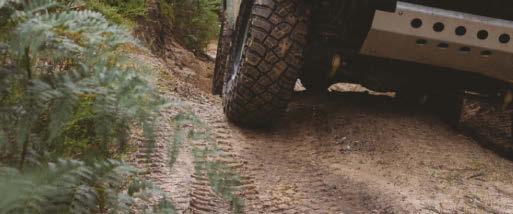


To that end, the force a tire exerts on the terrain should be all-encompassing, powerful, and momentary. Take the track above for example. Pretty daunting proposition to roll tons of steel through miles of soft soil. But we design our offroad line, like the BFGoodrich Mud-Terrain T/A KM3 to overcome anything through a Linear Flex Zone that envelops obstacles and soft soil for a brief moment so you can move through the trail with minimal impact so it doesn’t get wider. We engineer incessantly to ensure we uphold that contract for every driver in every situation. Because it’s the right thing to do. But at the same time, isn’t it more fun that way? Maybe our dads were right.
To that end, the force a tire exerts on the terrain should be all-encompassing, powerful, and momentary. Take the track above for example. Pretty daunting proposition to roll tons of steel through miles of soft soil. But we design our offroad line, like the BFGoodrich Mud-Terrain T/A® KM3 to overcome anything through a Linear Flex Zone that envelops obstacles and soft soil for a brief moment so you can move through the trail with minimal impact so it doesn’t get wider. We engineer incessantly to ensure we uphold that contract for every driver in every situation. Because it’s the right thing to do. But at the same time, isn’t it more fun that way? Maybe our dads were right.
To that end, the force a tire exerts on the terrain should be all-encompassing, powerful, and momentary. Take the track above for example. Pretty daunting proposition to roll tons of steel through miles of soft soil. But we design our offroad line, like the BFGoodrich Mud-Terrain KM3 to overcome anything through a Linear Flex Zone that envelops obstacles and soft soil for a brief moment so you can move through the trail with minimal impact so it doesn’t get wider. We engineer incessantly to ensure we uphold that contract for every driver in every situation. Because it’s the right thing to do. But at the same time, isn’t it more fun that way?
To that end, the force a tire exerts on the terrain should be all-encompassing, powerful, and momentary. Take the track above for example. Pretty daunting proposition to roll tons of steel through miles of soft soil. But we design our offroad line, like the BFGoodrich Mud-Terrain KM3 to overcome anything through a Linear Flex Zone that envelops obstacles and soft soil for a brief moment so you can move through the trail with minimal impact so it doesn’t get wider. We engineer incessantly to ensure we uphold that contract for every driver in every situation. Because it’s the right thing to do. But at the same time, isn’t it more fun that way?
LEARN
LEARN MORE ON HOW TO TRAVERSE THE EARTH RESPONSIBLY at









LEARN MORE ON HOW TO TRAVERSE THE EARTH RESPONSIBLY at BFGoodrichTires.com
MORE
HOW TO TRAVERSE at BFGoodrichTires.com
ON
BFGoodrichTires.com
LEARN
TO
THE EARTH RESPONSIBLY at BFGoodrichTires.com
MORE ON HOW
TRAVERSE

WIIINGS FOR YOUR SUMMER.





































































































































































































































































 WORDS BY JEN SEE PHOTOS BY MARÍA JOSÉ GOVEA
WORDS BY JEN SEE PHOTOS BY MARÍA JOSÉ GOVEA








































 In 2014, Grambeau captured the true art of Teahupo’o in black and white. “Those moments speak to the power and beauty in awesome tones,” he says.
“It has a mesmerizing beauty of energy that is almost seductive in nature. For some 35 years, I have been repeatedly drawn back to this sacred reef in the Pacifc, where no two swells are ever the same.”
In 2014, Grambeau captured the true art of Teahupo’o in black and white. “Those moments speak to the power and beauty in awesome tones,” he says.
“It has a mesmerizing beauty of energy that is almost seductive in nature. For some 35 years, I have been repeatedly drawn back to this sacred reef in the Pacifc, where no two swells are ever the same.”































































































































